
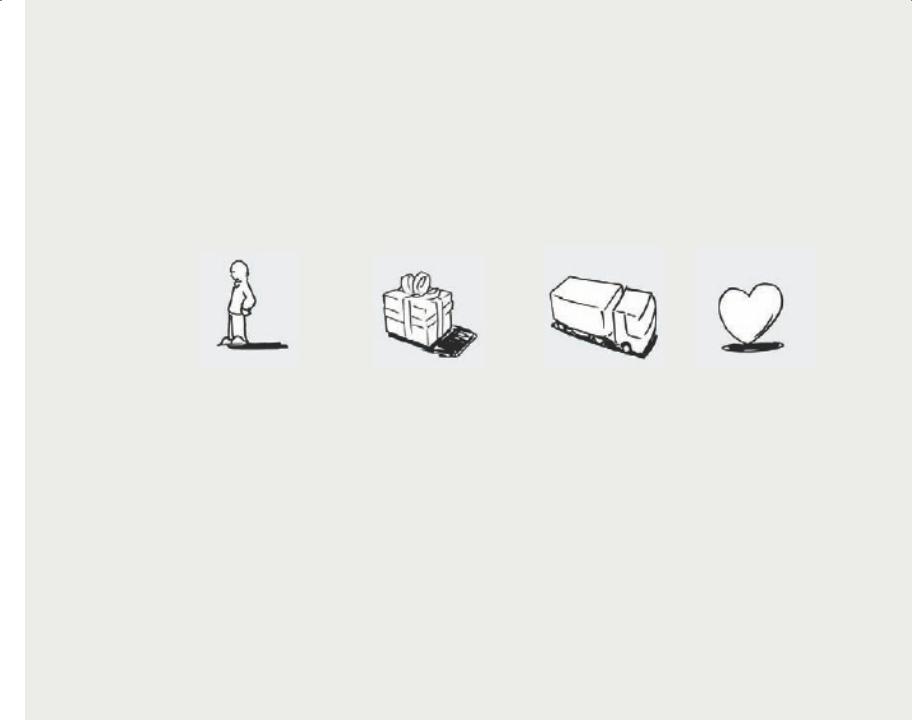
[ The 9 Building Blocks
CS |
VP |
1Customer |
2 Value |
Segments |
Propositions |
An organization serves |
It seeks to solve customer |
one or several Customer |
problems and satisfy |
Segments. |
customer needs with |
|
value propositions. |
CH |
Cr |
3 Channels |
4 Customer |
Value propositions |
Relationships |
are delivered to customers |
Customer relationships |
through communication, |
are established and |
distribution, and sales |
maintained with each |
Channels. |
Customer Segment. |
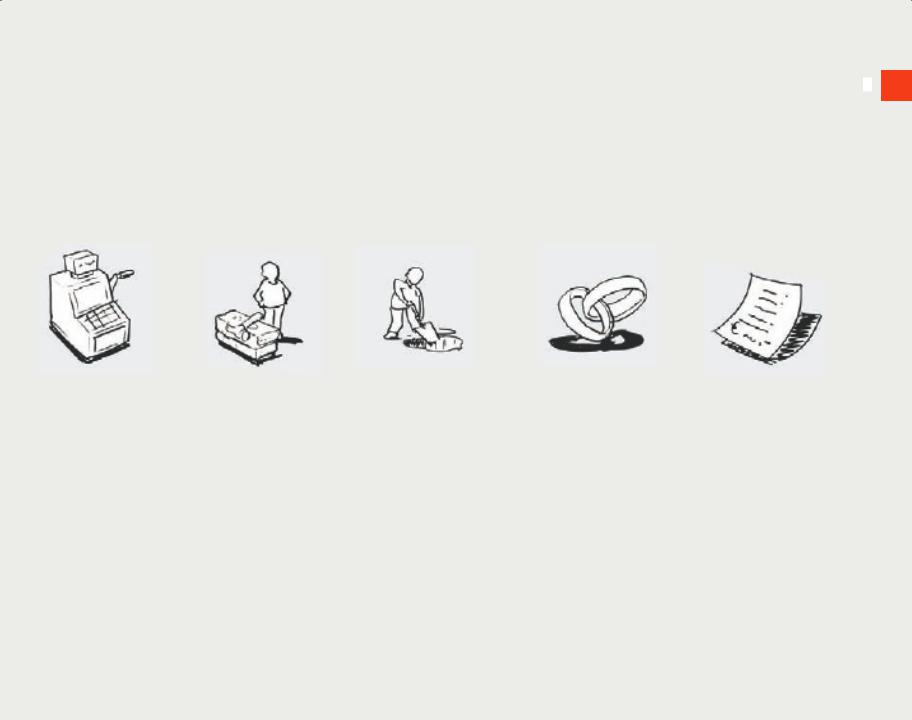
17
r$ |
Kr |
KA |
KP |
C$ |
5 Revenue |
6 Key |
7 Key |
8 Key |
9 Cost |
Streams |
Resources |
Activities |
Partnerships |
Structure |
Revenue streams result |
Key resources are the |
. . . by performing a num- |
Some activities are |
from value propositions |
assets required to oΩer |
ber of Key Activities. |
outsourced and some |
successfully oΩered to |
and deliver the previously |
|
resources are acquired |
customers. |
described elements . . . |
|
outside the enterprise. |
The business model elements result in the cost structure.
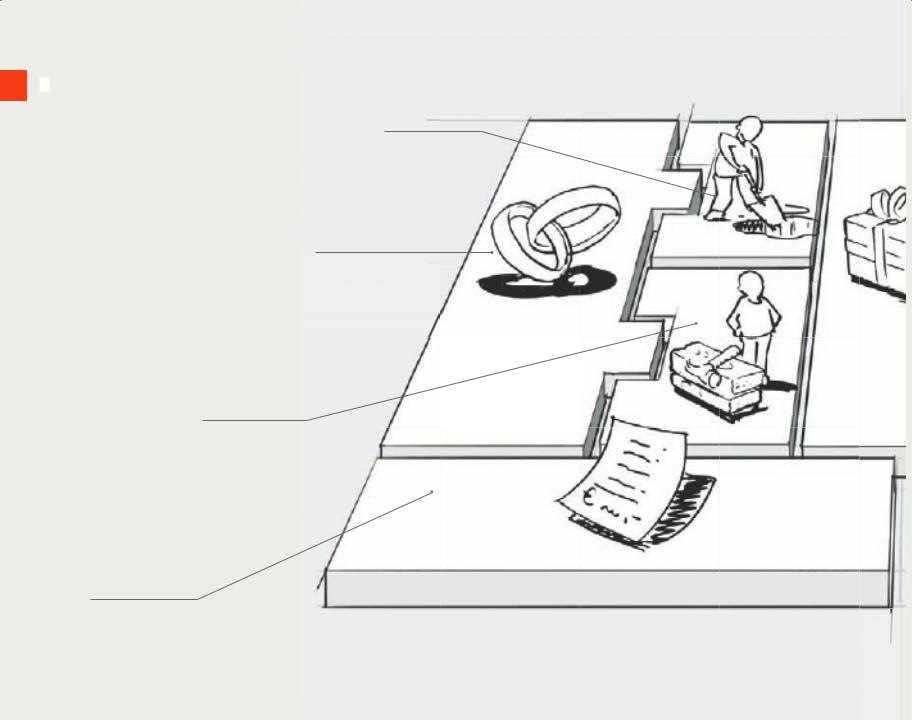
18 |
KA |
|
Key Activities
KP
Key Partners
Kr
Key Resources
C$
Cost Structure
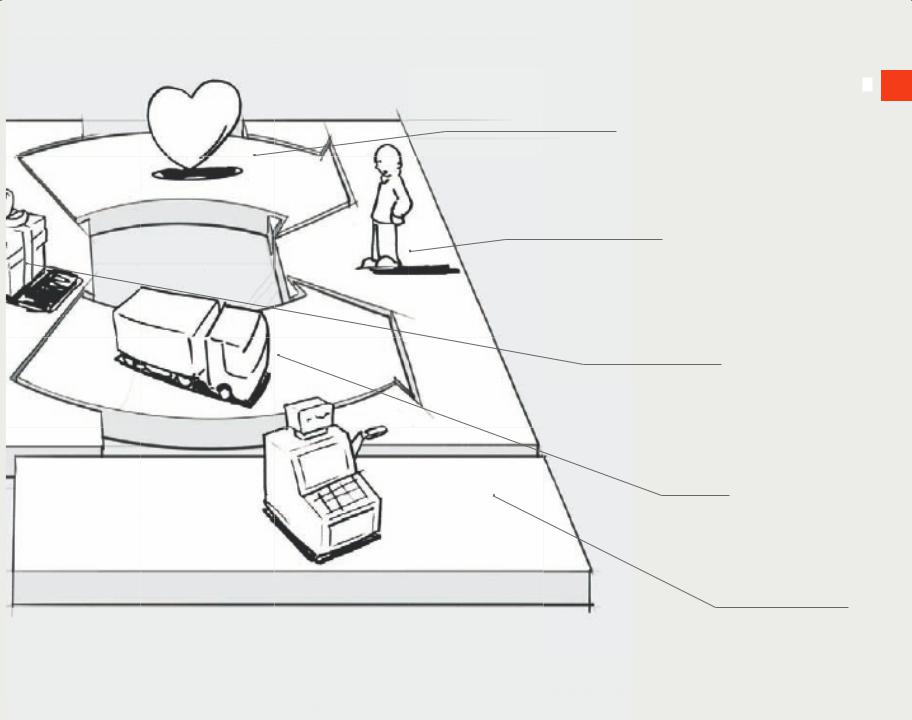
Cr |
19 |
|
|
Customer Relationships |
|
CS
Customer Segments
VP
Value Propositions
CH
Channels
r$
Revenue Streams
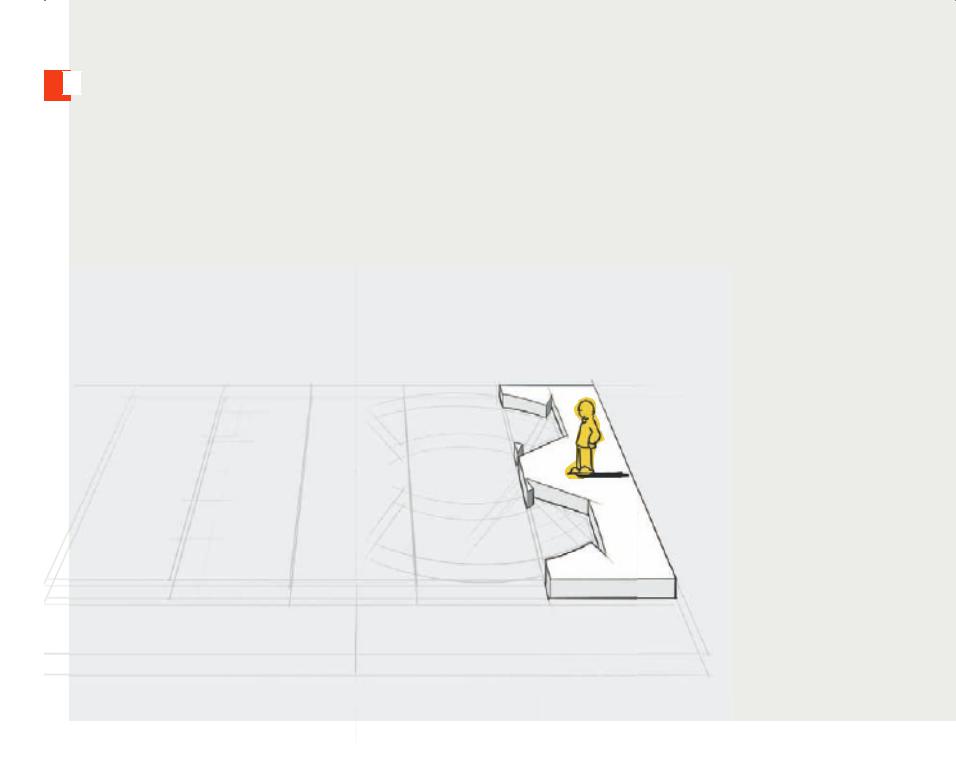
CS
1
 Customer Segments
Customer Segments
The Customer Segments Building Block defines the diΩerent groups of people or organizations an enterprise aims to reach and serve
Customers comprise the heart of any business model. Without (profitable) customers, no company can survive for long. In order to better satisfy customers, a company may group them into distinct segments with common needs, common behaviors,
or other attributes. A business model may define one or several large or small Customer Segments. An organization must make a conscious decision about which segments to serve and which segments to ignore. Once this decision is made, a business model can be carefully designed around a strong understanding of specific customer needs.
Customer groups represent separate segments if:
•Their needs require and justify a distinct oΩer
•They are reached through diΩerent Distribution Channels
•They require diΩerent types of relationships
•They have substantially diΩerent profitabilities
•They are willing to pay for diΩerent aspects of the oΩer

For whom are we creating value? |
21 |
|
|
Who are our most important customers? |
|
There are diΩerent types of Customer Segments. Here are some examples:
Mass market
Business models focused on mass markets don’t distinguish between diΩerent Customer Segments. The Value Propositions, Distribution Channels, and Customer Relationships all focus on one large group of customers with broadly similar needs and problems. This type of business model is often found in the consumer electronics sector.
Niche market
Business models targeting niche markets cater to specific, specialized Customer Segments. The Value Propositions, Distribution Channels, and Customer Relationships are all tailored to the specific requirements of a niche market. Such business models
are often found in supplier-buyer relationships. For example, many car part manufacturers depend heavily on purchases from major automobile manufacturers.
Segmented
Some business models distinguish between market segments with slightly diΩerent needs and problems. The retail arm of a bank like Credit Suisse, for example, may distinguish between a large group of customers, each possessing assets of up to U.S. $100,000, and
a smaller group of aΩluent clients, each of whose net worth exceeds U.S. $500,000. Both segments have similar but varying needs and problems. This has implications for the other building blocks of Credit Suisse’s business model, such as the Value Proposition, Distribution Channels, Customer Relationships, and Revenue streams. Consider Micro Precision Systems, which specializes in providing outsourced micromechanical design and manufacturing solutions. It serves three diΩerent Customer Segments—the watch industry, the medical industry, and the industrial automation sector—and oΩers each slightly diΩerent Value Propositions.
Diversified
An organization with a diversified customer business model serves two unrelated Customer Segments with very diΩerent needs and problems. For example, in 2006 Amazon.com decided to diversify its retail
business by selling “cloud computing” services: online storage space and on-demand server usage. Thus
it started catering to a totally diΩerent Customer Segment—Web companies—with a totally diΩerent Value Proposition. The strategic rationale behind this diversification can be found in Amazon.com’s powerful IT infrastructure, which can be shared by its retail sales operations and the new cloud computing service unit.
Multi-sided platforms (or multi-sided markets)
Some organizations serve two or more interdependent Customer Segments. A credit card company, for example, needs a large base of credit card holders and a large base of merchants who accept those credit cards. Similarly, an enterprise oΩering a free newspaper needs a large reader base to attract advertisers. On the other hand, it also needs advertisers to finance production and distribution. Both segments are required to make the business model work (read more about multi-sided platforms on p. 76).
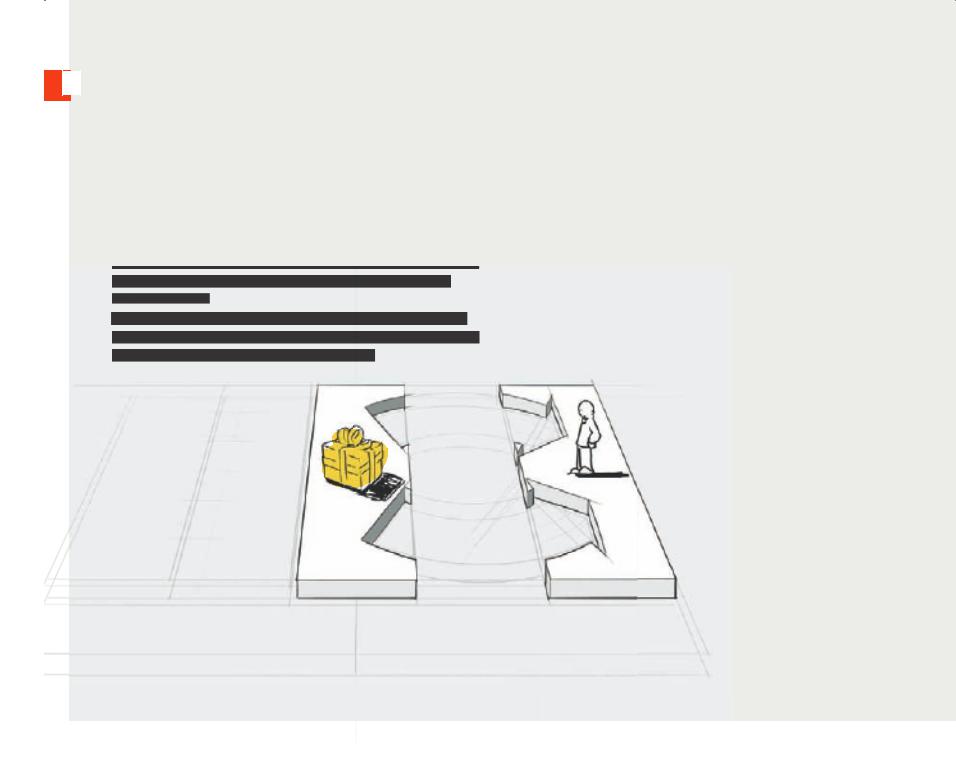
VP
2 Value Propositions
The Value Propositions Building Block describes the bundle of products and services that create value for a specific Customer Segment
The Value Proposition is the reason why customers turn to one company over another. It solves a customer problem or satisfies a customer need. Each Value Proposition consists of a selected
bundle of products and/or services that caters to the requirements of a specific Customer Segment. In this sense, the Value Proposi-

What value do we deliver to the customer? |
23 |
|
|
Which one of our customer’s problems are we helping |
|
to solve? Which customer needs are we satisfying? |
|
What bundles of products and services are we oΩering |
|
to each Customer Segment? |
|
A Value Proposition creates value for a Customer Segment through a distinct mix of elements catering to that segment’s needs. Values may be quantitative (e.g. price, speed of service) or qualitative (e.g. design, customer experience).
Elements from the following non-exhaustive list can contribute to customer value creation.
Newness
Some Value Propositions satisfy an entirely new set of needs that customers previously didn’t perceive because there was no similar oΩering. This is often, but not always, technology related. Cell phones,
for instance, created a whole new industry around mobile telecommunication. On the other hand, products such as ethical investment funds have little to do with new technology.
Performance
Improving product or service performance has traditionally been a common way to create value. The PC sector has traditionally relied on this factor by bringing more powerful machines to market. But improved performance has its limits. In recent years, for example, faster PCs, more disk storage space, and better graphics have failed to produce corresponding growth in customer demand.
Customization
Tailoring products and services to the specific needs of individual customers or Customer Segments creates value. In recent years, the concepts of mass customization and customer co-creation have gained importance. This approach allows for customized products and services, while still taking advantage of economies of scale.

2
“Getting the job done”
Value can be created simply by helping a customer get certain jobs done. Rolls-Royce understands this very well: its airline customers rely entirely on RollsRoyce to manufacture and service their jet engines. This arrangement allows customers to focus on running their airlines. In return, the airlines pay Rolls-Royce a fee for every hour an engine runs.
Design
Design is an important but diΩicult element to measure. A product may stand out because of superior design. In the fashion and consumer electronics industries, design can be a particularly important part of the Value Proposition.
Brand/status
Customers may find value in the simple act of using and displaying a specific brand. Wearing a Rolex watch signifies wealth, for example. On the other end of the spectrum, skateboarders may wear the latest “underground” brands to show that they are “in.”
Price
OΩering similar value at a lower price is a common way to satisfy the needs of price-sensitive Customer Segments. But low-price Value Propositions have important implications for the rest of a business model. No frills airlines, such as Southwest, easyJet, and Ryanair have designed entire business models specifically to enable low cost air travel. Another example of a price-based Value Proposition can be seen in the Nano, a new car designed and manufactured by the Indian conglomerate Tata. Its surprisingly low price makes the automobile aΩordable to a whole new segment of the Indian population. Increasingly, free oΩers are starting to permeate various industries. Free oΩers range from free newspapers to free e-mail, free mobile phone services, and more (see p. 88 for more on FREE).

25 
Cost reduction
Helping customers reduce costs is an important way to create value. Salesforce.com, for example, sells a hosted Customer Relationship management (CRM) application. This relieves buyers from the expense and trouble of having to buy, install, and manage CRM software themselves.
Risk reduction
Customers value reducing the risks they incur when purchasing products or services. For a used car buyer, a one-year service guarantee reduces the risk of post-purchase breakdowns and repairs. A service-level guarantee partially reduces the risk undertaken by a purchaser of outsourced IT services.
Accessibility
Making products and services available to customers who previously lacked access to them is another way to create value. This can result from business model innovation, new technologies, or a combination of both. NetJets, for instance, popularized the concept of fractional private jet ownership. Using an innovative business model, NetJets oΩers individuals and corporations access to private jets, a service previously unaΩordable to most customers. Mutual funds provide another example of value creation through increased accessibility. This innovative financial product made it possible even for those with modest wealth to build diversified investment portfolios.
Convenience/usability
Making things more convenient or easier to use can create substantial value. With iPod and iTunes, Apple oΩered customers unprecedented convenience searching, buying, downloading, and listening to digital music. It now dominates the market.
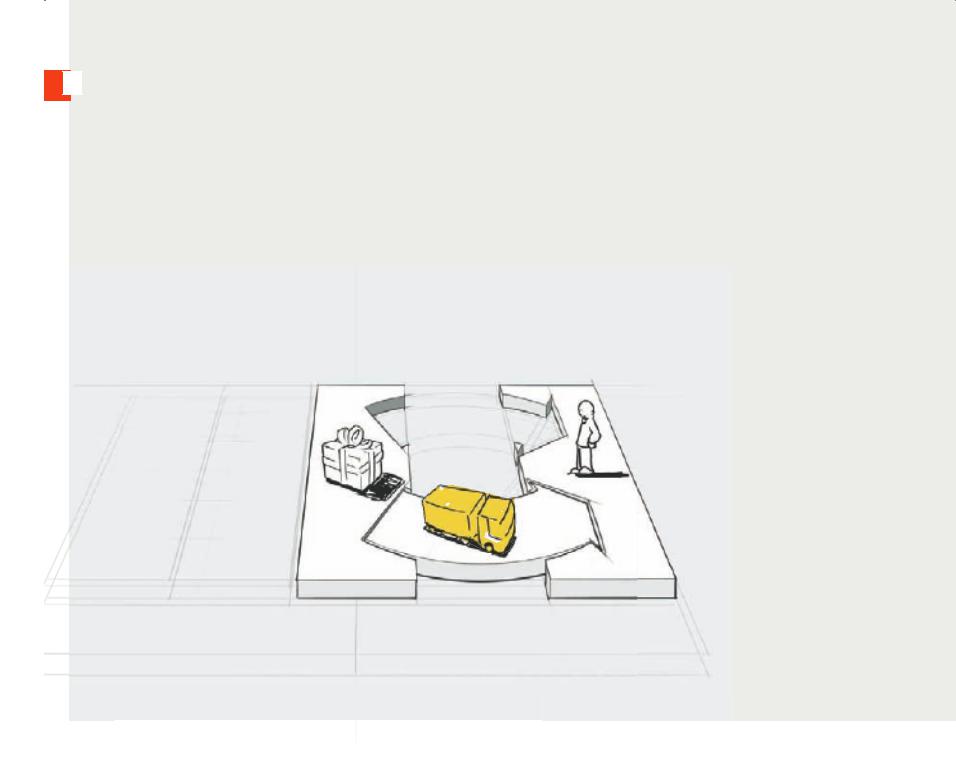
CH
3
 Channels
Channels
The Channels Building Block describes how a company communicates with and reaches its Customer Segments to deliver a Value Proposition
Communication, distribution, and sales Channels comprise a company's interface with customers. Channels are customer touch points that play an important role in the customer experience. Channels serve several functions, including:
•Raising awareness among customers about a company’s products and services
•Helping customers evaluate a company’s Value Proposition
•Allowing customers to purchase specific products and services
•Delivering a Value Proposition to customers
•Providing post-purchase customer support

Through which Channels do our Customer Segments |
27 |
|
|
want to be reached? How are we reaching them now? |
|
How are our Channels integrated? Which ones work best? |
|
Which ones are most cost-eΩicient? How are we |
|
integrating them with customer routines? |
|
Channels have five distinct phases. Each channel can cover some or all of these phases. We can distinguish between direct Channels and indirect ones, as well as between owned Channels and partner Channels.
Finding the right mix of Channels to satisfy how customers want to be reached is crucial in bringing a Value Proposition to market. An organization can
choose between reaching its customers through its own Channels, through partner Channels, or through a mix of both. Owned Channels can be direct, such as an in-house sales force or a Web site, or they can be indirect, such as retail stores owned or operated by the organization. Partner Channels are indirect and span a whole range of options, such as wholesale distribution, retail, or partner-owned Web sites.
Partner Channels lead to lower margins, but they allow an organization to expand its reach and benefit from partner strengths. Owned Channels and particularly direct ones have higher margins, but can be costly to put in place and to operate. The trick is to find the right balance between the diΩerent types of Channels, to integrate them in a way to create a great customer experience, and to maximize revenues.
Channel Types |
Channel Phases |
Own |
Direct |
Partner |
Indirect |
Sales force
Web sales
Own stores
Partner
stores
Wholesaler
1. Awareness
How do we raise awareness about our company’s products and services?
2. Evaluation
How do we help customers evaluate our organization’s Value Proposition?
3. Purchase
How do we allow customers to purchase specific products and services?
4. Delivery
How do we deliver a Value  Proposition to customers?
Proposition to customers?
5. After sales
How do we provide post-purchase customer support?
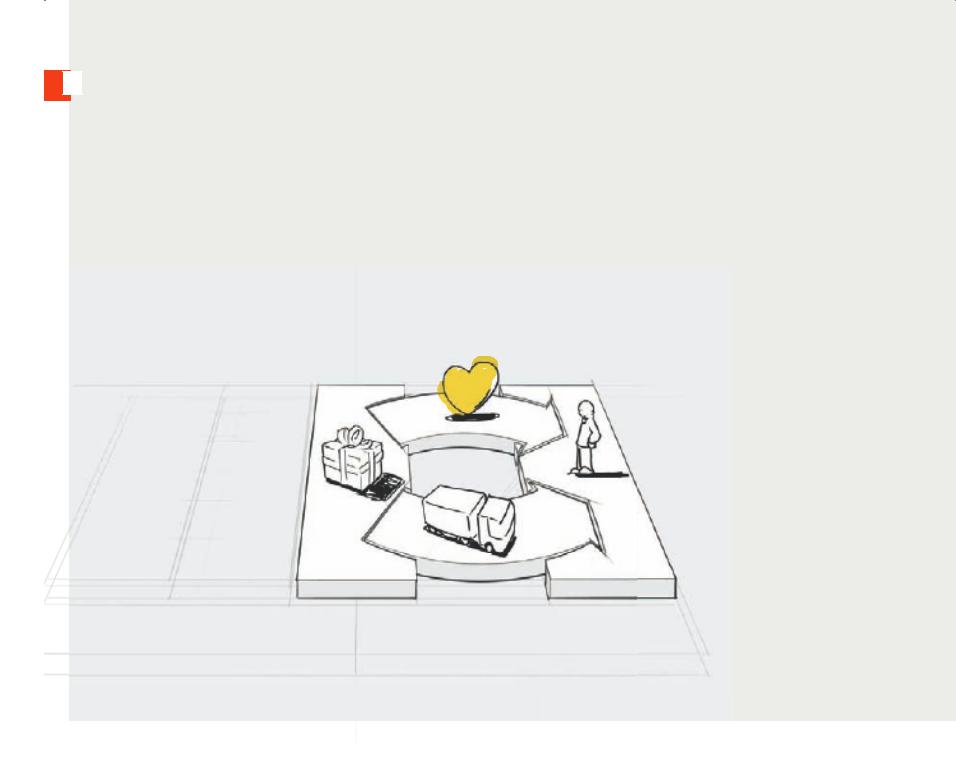
Cr
4
 Customer Relationships
Customer Relationships
The Customer Relationships Building Block describes the types of relationships a company establishes with specific Customer Segments
A company should clarify the type of relationship it wants to establish with each Customer Segment. Relationships can range from personal to automated. Customer relationships may be driven by the following motivations:
•Customer acquisition
•Customer retention
•Boosting sales (upselling)
In the early days, for example, mobile network operator Customer Relationships were driven by aggressive acquisition strategies involving free mobile phones. When the market became saturated, operators switched to focusing on customer retention and increasing average revenue per customer.
The Customer Relationships called for by a company’s business model deeply influence the overall customer experience.

What type of relationship does each of our Customer |
29 |
|
|
Segments expect us to establish and maintain with them? |
|
Which ones have we established? How costly are they? |
|
How are they integrated with the rest of our business model? |
|
We can distinguish between several categories of Customer Relationships, which may co-exist in a company’s relationship with a particular Customer Segment:
Personal assistance
This relationship is based on human interaction.
The customer can communicate with a real customer representative to get help during the sales process or after the purchase is complete. This may happen onsite at the point of sale, through call centers, by e-mail, or through other means.
Dedicated personal assistance
This relationship involves dedicating a customer representative specifically to an individual client. It represents the deepest and most intimate type of relationship and normally develops over a long period of time. In private banking services, for example, dedicated bankers serve high net worth individuals. Similar relationships can be found in other businesses in the form of key account managers who maintain personal relationships with important customers.
Self-service
In this type of relationship, a company maintains no direct relationship with customers. It provides all the necessary means for customers to help themselves.
Automated services
This type of relationship mixes a more sophisticated form of customer self-service with automated processes. For example, personal online profiles give customers access to customized services. Automated services can recognize individual customers and their characteristics, and oΩer information related to orders or transactions. At their best, automated services can simulate a personal relationship (e.g. oΩering book or movie recommendations).
Communities
Increasingly, companies are utilizing user communities to become more involved with customers/prospects and to facilitate connections between community members. Many companies maintain online communities that allow users to exchange knowledge and
solve each other’s problems. Communities can also help companies better understand their customers. Pharmaceutical giant GlaxoSmithKline launched a private online community when it introduced alli, a new prescription-free weight-loss product.
GlaxoSmithKline wanted to increase its understanding of the challenges faced by overweight adults, and thereby learn to better manage customer expectations.
Co-creation
More companies are going beyond the traditional customer-vendor relationship to co-create value with customers. Amazon.com invites customers to write reviews and thus create value for other book lovers. Some companies engage customers to assist with the design of new and innovative products. Others, such as YouTube.com, solicit customers to create content for public consumption.
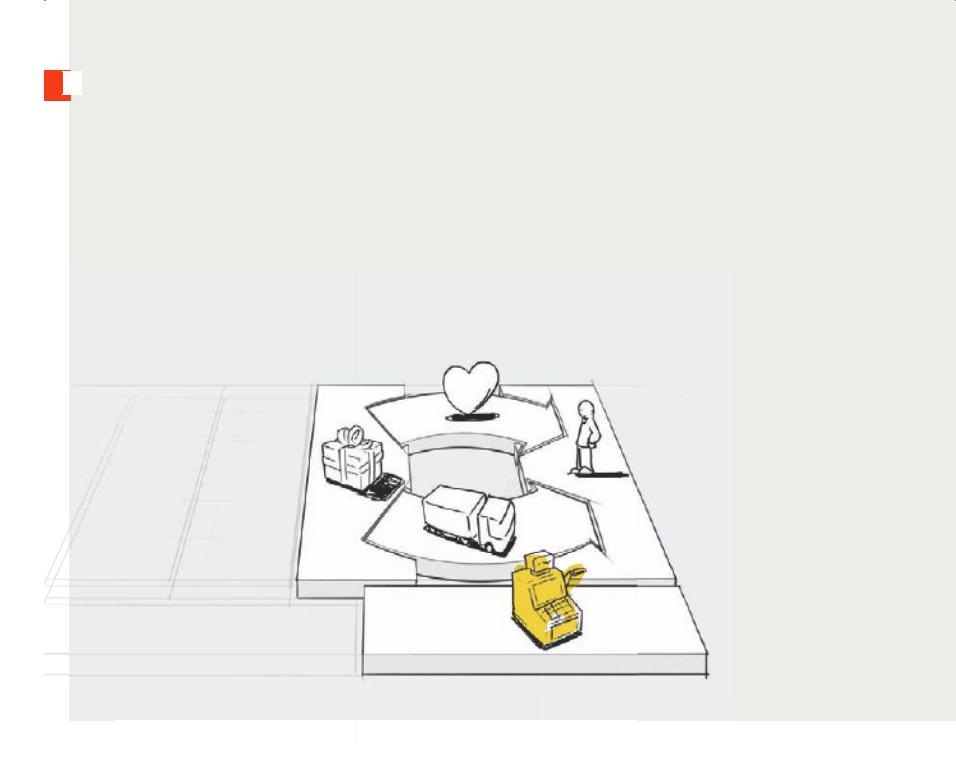
r$
5
 Revenue Streams
Revenue Streams
The Revenue Streams Building Block represents the cash a company generates from each Customer Segment (costs must be subtracted from revenues to create earnings)
If customers comprise the heart of a business model, Revenue Streams are its arteries. A company must ask itself, For what value is each Customer Segment truly willing to pay? Successfully answering that question allows the firm to generate one or more Revenue Streams from each Customer Segment. Each Revenue Stream may have diΩerent pricing mechanisms, such as fixed list prices, bargaining, auctioning, market dependent, volume dependent, or yield management.
A business model can involve two diΩerent types of Revenue Streams:
1.Transaction revenues resulting from one-time customer payments
2.Recurring revenues resulting from ongoing payments to either deliver a Value Proposition to customers or provide post-purchase customer support

For what value are our customers really willing to pay? |
31 |
|
|
For what do they currently pay? How are they currently |
|
paying? How would they prefer to pay? How much does |
|
each Revenue Stream contribute to overall revenues? |
|
There are several ways to generate Revenue Streams:
Asset sale
The most widely understood Revenue Stream derives from selling ownership rights to a physical product. Amazon.com sells books, music, consumer electronics, and more online. Fiat sells automobiles, which buyers are free to drive, resell, or even destroy.
Usage fee
This Revenue Stream is generated by the use of a particular service. The more a service is used, the more the customer pays. A telecom operator may charge customers for the number of minutes spent on the phone. A hotel charges customers for the number of nights rooms are used. A package delivery service charges customers for the delivery of a parcel from one location to another.
Subscription fees
This Revenue Stream is generated by selling continuous access to a service. A gym sells its members monthly or yearly subscriptions in exchange for access to its exercise facilities. World of Warcraft Online, a Web-based computer game, allows users to play its online game in exchange for a monthly subscription fee. Nokia’s Comes with Music service gives users access to a music library for a subscription fee.
Lending/Renting/Leasing
This Revenue Stream is created by temporarily granting someone the exclusive right to use a particular asset for a fixed period in return for a
fee. For the lender this provides the advantage of recurring revenues. Renters or lessees, on the other hand, enjoy the benefits of incurring expenses for only a limited time rather than bearing the full costs
of ownership. Zipcar.com provides a good illustration. The company allows customers to rent cars by the hour in North American cities. Zipcar.com’s service has led many people to decide to rent rather than purchase automobiles.
Licensing
This Revenue Stream is generated by giving customers permission to use protected intellectual property in exchange for licensing fees. Licensing allows rightsholders to generate revenues from their property without having to manufacture a product or commercialize a service. Licensing is common in the media industry, where content owners retain copyright while selling usage licenses to third parties. Similarly, in technology sectors, patentholders grant other companies the right to use a patented technology in return for a license fee.

5

Brokerage fees
This Revenue Stream derives from intermediation services performed on behalf of two or more parties. Credit card providers, for example, earn revenues by taking a percentage of the value of each sales transaction executed between credit card merchants and customers. Brokers and real estate agents earn a commission each time they successfully match a buyer and seller.
Advertising
This Revenue Stream results from fees for advertising a particular product, service, or brand. Traditionally, the media industry and event organizers relied heavily on revenues from advertising. In recent years other sectors, including software and services, have started relying more heavily on advertising revenues.
Each Revenue Stream might have diΩerent pricing mechanisms. The type of pricing mechanism chosen can make a big diΩerence in terms of revenues generated. There are two main types of pricing mechanism: fixed and dynamic pricing.

33
Pricing Mechanisms
Fixed Menu Pricing
Predefined prices are based on static variables
List price Fixed prices for individual products, services, or other Value Propositions
Product feature Price depends on the number or quality of dependent Value Proposition features
Customer segment Price depends on the type and characteristic dependent of a Customer Segment
Dynamic Pricing
Prices change based on market conditions
Negotiation Price negotiated between two or more partners (bargaining) depending on negotiation power and/or negotiation skills
Yield management Price depends on inventory and time of purchase (normally used for perishable resources such as hotel rooms or airline seats)
Real-time-market Price is established dynamically based on supply and demand
Volume dependent Price as a function of the quantity purchased |
Auctions Price determined by outcome of competitive bidding |
|
|
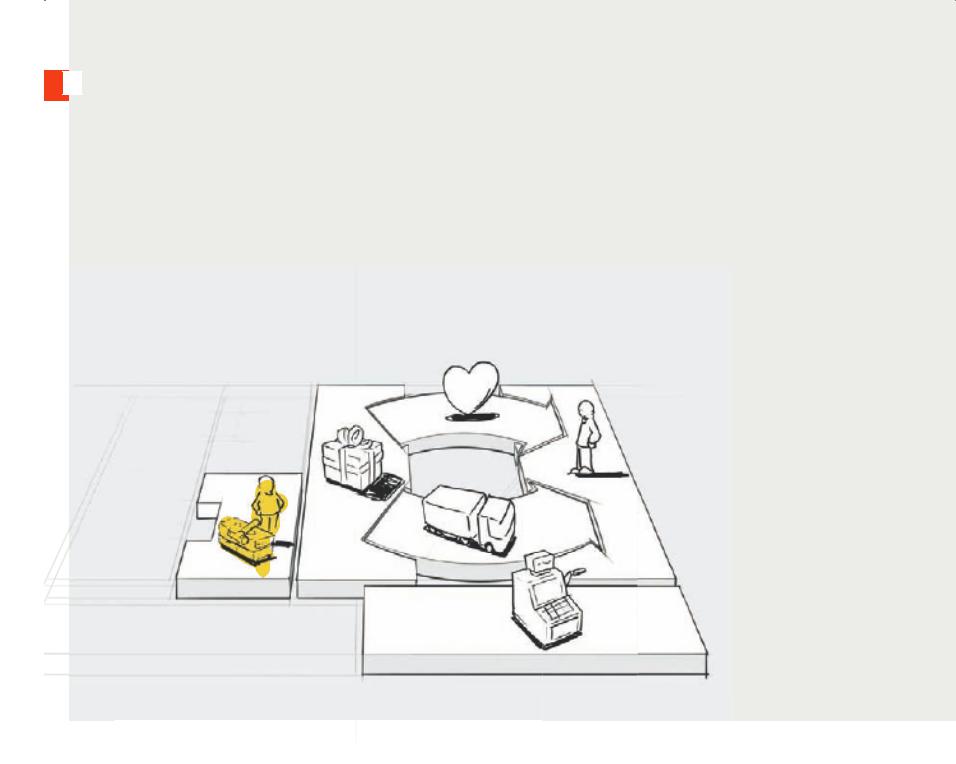
Kr
6
 34 Key Resources
34 Key Resources
The Key Resources Building Block describes the most important assets required to make a business model work
Every business model requires Key Resources. These resources allow an enterprise to create and oΩer a Value Proposition, reach markets, maintain relationships with Customer Segments, and earn revenues. DiΩerent Key Resources are needed depending on the type of business model. A microchip manufacturer requires capital-intensive production facilities, whereas a microchip designer focuses more on human resources.
Key resources can be physical, financial, intellectual, or human. Key resources can be owned or leased by the company or acquired from key partners.

What Key Resources do our Value Propositions require? |
35 |
|
|
Our Distribution Channels? Customer Relationships? |
|
Revenue Streams? |
|
Key Resources can be categorized as follows:
Physical
This category includes physical assets such as manufacturing facilities, buildings, vehicles, machines, systems, point-of-sales systems, and distribution networks. Retailers like Wal-Mart and Amazon.com rely heavily on physical resources, which are often capital-intensive. The former has an enormous global network of stores and related logistics infrastructure. The latter has an extensive IT, warehouse, and logistics infrastructure.
Intellectual
Intellectual resources such as brands, proprietary knowledge, patents and copyrights, partnerships, and customer databases are increasingly important components of a strong business model. Intellectual resources are diΩicult to develop but when success-
fully created may oΩer substantial value. Consumer goods companies such as Nike and Sony rely heavily on brand as a Key Resource. Microsoft and SAP depend on software and related intellectual property developed over many years. Qualcomm, a designer and supplier of chipsets for broadband mobile devices, built its business model around patented microchip designs that earn the company substantial licensing fees.
Human
Every enterprise requires human resources, but people are particularly prominent in certain business models. For example, human resources are crucial in knowledge-intensive and creative industries. A pharmaceutical company such as Novartis, for example, relies heavily on human resources: Its business model is predicated on an army of experienced scientists and a large and skilled sales force.
Financial
Some business models call for financial resources and/or financial guarantees, such as cash, lines of credit, or a stock option pool for hiring key employees. Ericsson, the telecom manufacturer, provides an example of financial resource leverage within a business model. Ericsson may opt to borrow funds
from banks and capital markets, then use a portion of the proceeds to provide vendor financing to equipment customers, thus ensuring that orders are placed with Ericsson rather than competitors.
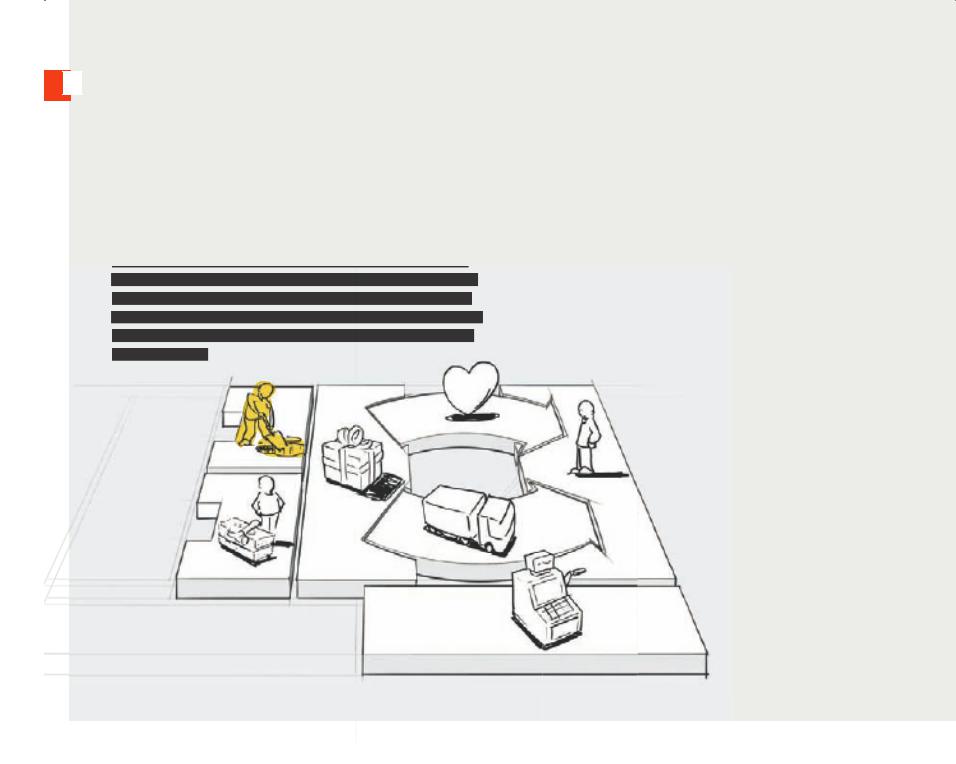
KA
7
 Key Activities
Key Activities
The Key Activities Building Block describes the most important things a company must do to make its business model work
Every business model calls for a number of Key Activities. These are the most important actions a company must take to operate successfully. Like Key Resources, they are required to create and oΩer a Value Proposition, reach markets, maintain Customer Relationships, and earn revenues. And like Key Resources, Key

What Key Activities do our Value Propositions require? |
37 |
|
|
Our Distribution Channels? Customer Relationships? |
|
Revenue streams? |
|
Key Activities can be categorized as follows:
Platform/network
Production
These activities relate to designing, making, and delivering a product in substantial quantities and/or of superior quality. Production activity dominates the business models of manufacturing firms.
Problem solving
Key Activities of this type relate to coming up with new solutions to individual customer problems.
The operations of consultancies, hospitals, and other service organizations are typically dominated by problem solving activities. Their business models call for activities such as knowledge management and continuous training.
Business models designed with a platform as a Key Resource are dominated by platform or networkrelated Key Activities. Networks, matchmaking platforms, software, and even brands can function as a platform. eBay’s business model requires that the company continually develop and maintain its platform: the Web site at eBay.com. Visa’s business model requires activities related to its Visa® credit card transaction platform for merchants, customers, and banks. Microsoft’s business model requires managing the interface between other vendors’ software and its Windows® operating system platform. Key Activities in this category relate to platform management, service provisioning, and platform promotion.
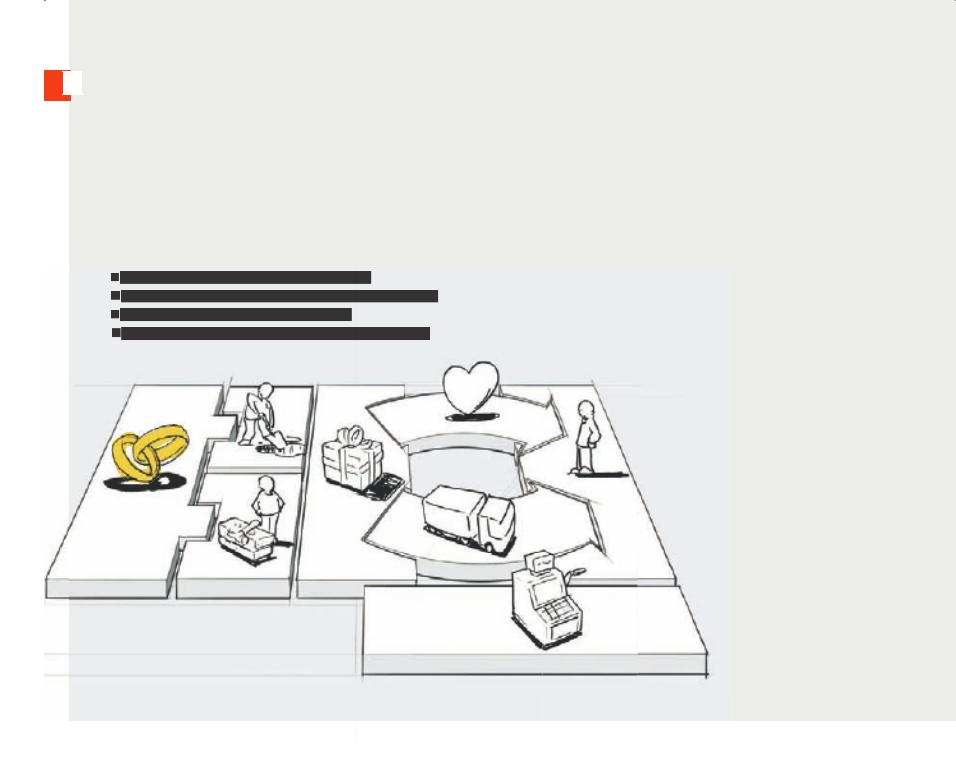
KP
8
 Key Partnerships
Key Partnerships
The Key Partnerships Building Block describes the network of suppliers and partners that make the business model work
Companies forge partnerships for many reasons, and partnerships are becoming a cornerstone of many business models. Companies create alliances to optimize their business models, reduce risk, or acquire resources.
We can distinguish between four diΩerent types of partnerships:

Who are our Key Partners? Who are our key suppliers? |
39 |
|
|
Which Key Resources are we acquiring from partners? |
|
Which Key Activities do partners perform? |
|
It can be useful to distinguish between three motivations for creating partnerships:
Optimization and economy of scale
The most basic form of partnership or buyer-supplier relationship is designed to optimize the allocation of resources and activities. It is illogical for a company to own all resources or perform every activity by itself. Optimization and economy of scale partnerships are usually formed to reduce costs, and often involve outsourcing or sharing infrastructure.
Reduction of risk and uncertainty
Partnerships can help reduce risk in a competitive environment characterized by uncertainty. It is not unusual for competitors to form a strategic alliance in one area while competing in another. Blu-ray, for example, is an optical disc format jointly developed
by a group of the world’s leading consumer electronics, personal computer, and media manufacturers. The group cooperated to bring Blu-ray technology to market, yet individual members compete in selling their own Blu-ray products.
Acquisition of particular resources and activities
Few companies own all the resources or perform all the activities described by their business models. Rather, they extend their own capabilities by relying on other firms to furnish particular resources or perform certain activities. Such partnerships can be motivated by needs to acquire knowledge, licenses, or access to customers. A mobile phone manufacturer, for example, may license an operating system for its handsets rather than developing one in-house. An insurer may choose to rely on independent brokers to sell its policies rather than develop its own sales force.
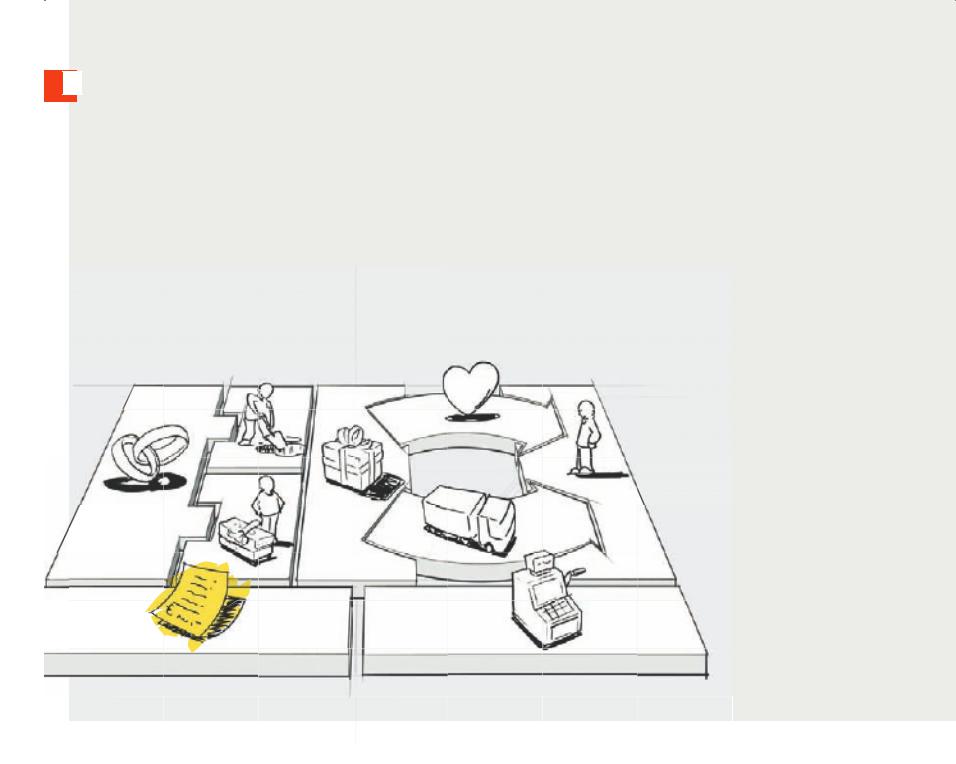
C$
9
 Cost Structure
Cost Structure
The Cost Structure describes all costs incurred to operate a business model
This building block describes the most important costs incurred while operating under a particular business model. Creating and delivering value, maintaining Customer Relationships, and generating revenue all incur costs. Such costs can be calculated relatively easily after defining Key Resources, Key Activities, and Key Partnerships. Some business models, though, are more cost-driven than others. So-called “no frills” airlines, for instance, have built business models entirely around low Cost Structures.

What are the most important costs inherent in our business |
41 |
|
|
model? Which Key Resources are most expensive? Which |
|
Key Activities are most expensive? |
|
Naturally enough, costs should be minimized in every business model. But low Cost Structures are more important to some business models than to others. Therefore it can be useful to distinguish between two broad classes of business model Cost Structures: cost-driven and value-driven (many business models fall in between these two extremes):
Cost-driven
Cost-driven business models focus on minimizing costs wherever possible. This approach aims at creating and maintaining the leanest possible Cost Structure, using low price Value Propositions, maximum automation, and extensive outsourcing. No frills airlines, such as Southwest, easyJet, and Ryanair typify cost-driven business models.
Value-driven
Some companies are less concerned with the cost implications of a particular business model design, and instead focus on value creation. Premium Value Propositions and a high degree of personalized service usually characterize value-driven business models. Luxury hotels, with their lavish facilities and exclusive services, fall into this category.
Cost Structures can have the following characteristics:
Fixed costs
Costs that remain the same despite the volume of goods or services produced. Examples include salaries, rents, and physical manufacturing facilities. Some businesses, such as manufacturing companies, are characterized by a high proportion of fixed costs.
Variable costs
Costs that vary proportionally with the volume of goods or services produced. Some businesses, such as music festivals, are characterized by a high proportion of variable costs.
Economies of scale
Cost advantages that a business enjoys as its output expands. Larger companies, for instance, benefit from lower bulk purchase rates. This and other factors cause average cost per unit to fall as output rises.
Economies of scope
Cost advantages that a business enjoys due to a larger scope of operations. In a large enterprise, for example, the same marketing activities or Distribution Channels may support multiple products.
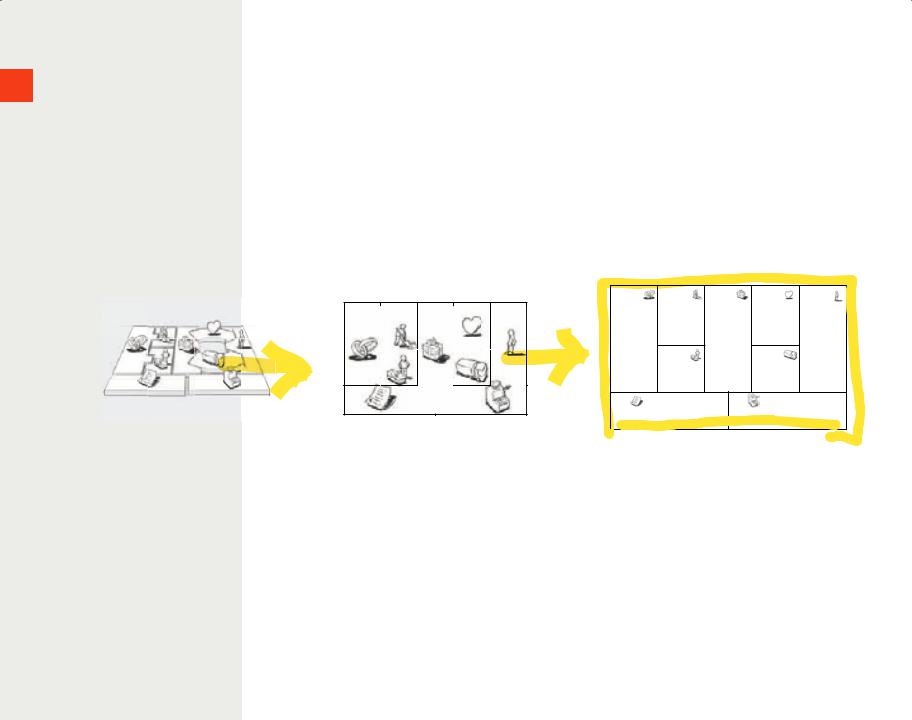
The nine business model Building Blocks form the basis for a handy tool, which we call the
Business Model Canvas.
The Business Model Canvas
This tool resembles a painter’s canvas—preformat- ted with the nine blocks—which allows you to paint pictures of new or existing business models.
The Business Model Canvas works best when printed out on a large surface so groups of people can jointly start sketching and discussing business model elements with Post-it® notes or board markers.
It is a hands-on tool that fosters understanding, discussion, creativity, and analysis.
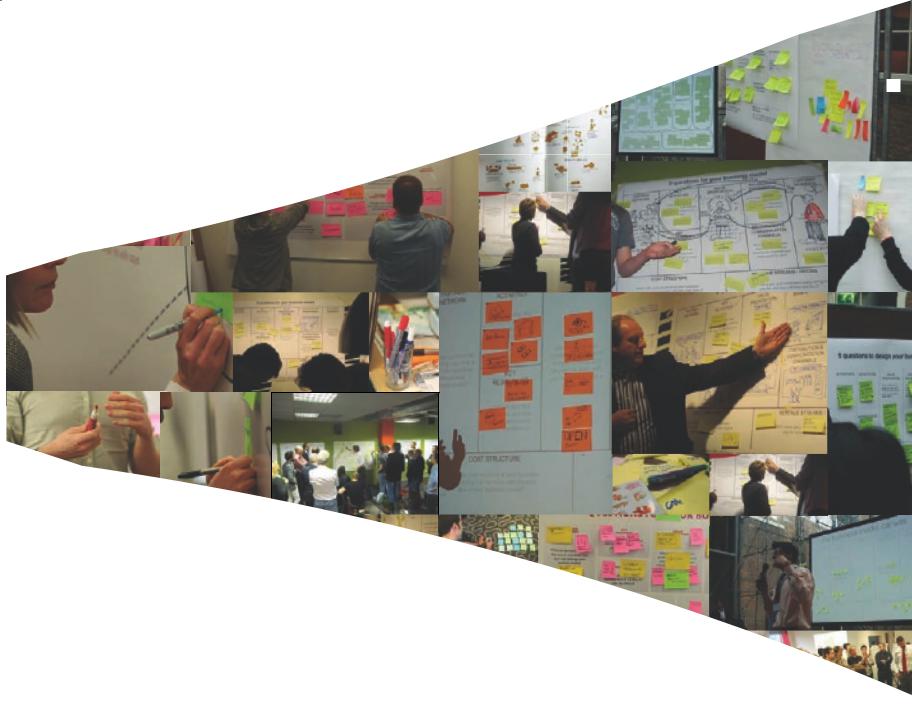
43
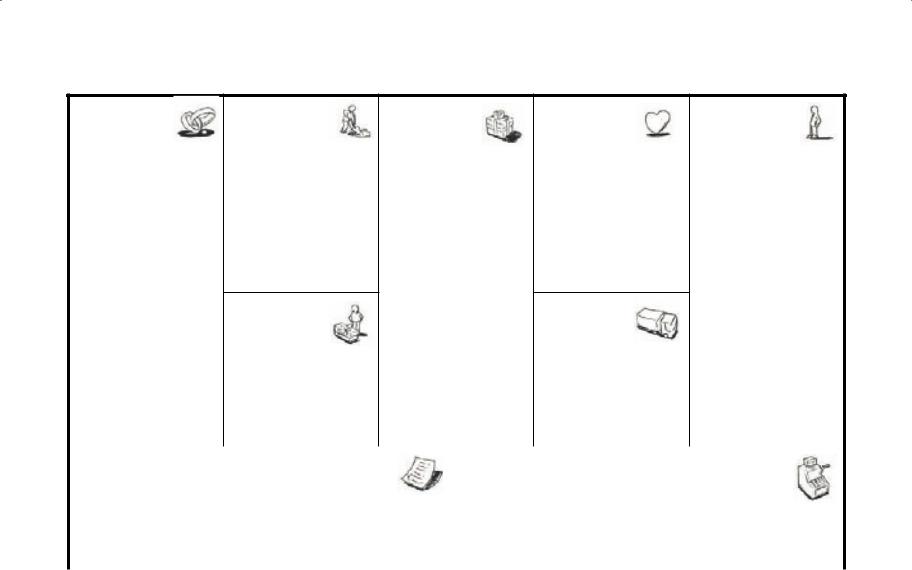
 44 The Business Model Canvas
44 The Business Model Canvas
Key |
Key |
Value |
Customer |
Customer |
|
Proposition |
|||||
Partners |
Activities |
Relationships |
Segments |
||
|
Key |
Channels |
Resources |
|
Cost |
Revenue |
Structure |
Streams |
|
|
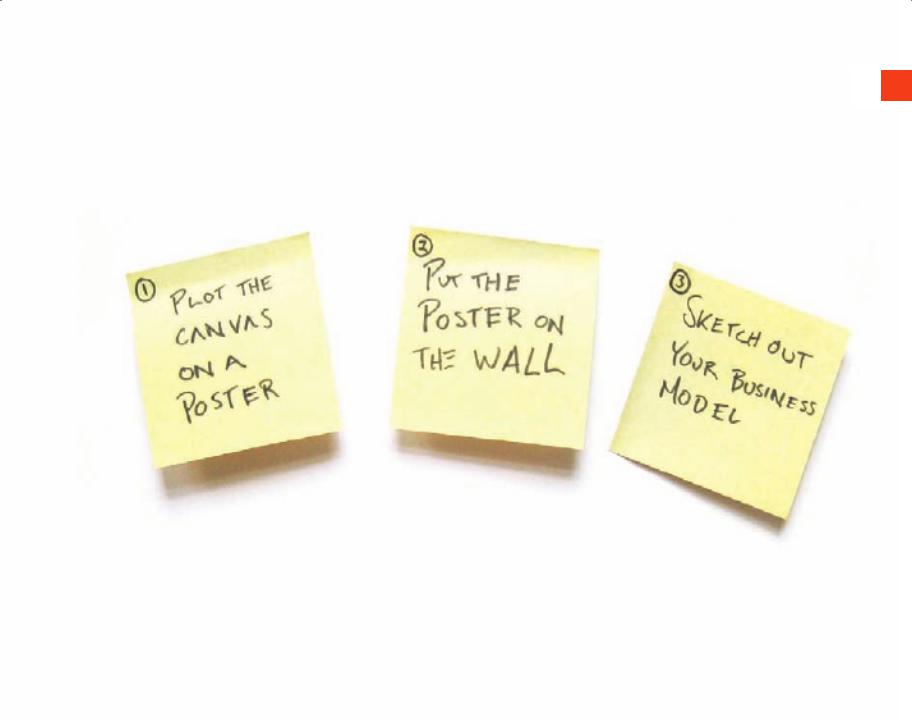
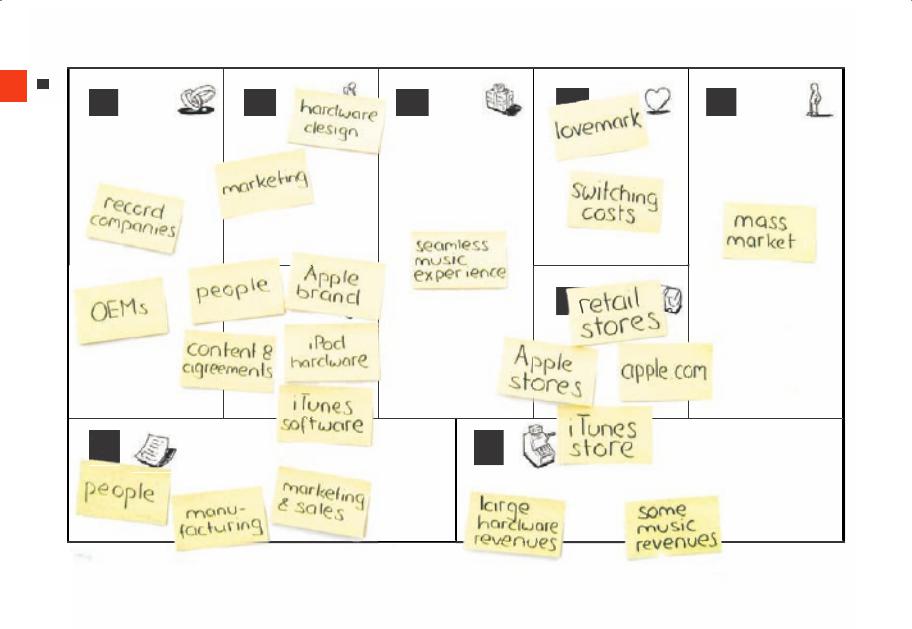

Example: Apple iPod/iTunes Business Model |
47 |
|
In 2001 Apple launched its iconic iPod brand of portable media player. The device works in conjunction with iTunes software that enables users to transfer music and other content from the iPod to a computer. The software also provides a seamless connection to Apple’s online store so users can purchase and download content.
This potent combination of device, software, and online store quickly disrupted the music industry and gave Apple a dominant market position. Yet Apple was not the first company to bring a portable media player to market. Competitors such as Diamond Multimedia, with its Rio brand of portable media players, were successful until they were outpaced by Apple.
How did Apple achieve such dominance? Because it competed with a better business model. On the one hand, it oΩered users a seamless music experience by combining its distinctively designed iPod devices with iTunes software and the iTunes online store. Apple’s Value Proposition is to allow customers to easily search, buy, and enjoy digital music. On the other hand, to make this Value Proposition possible, Apple had to negotiate deals with all the major record companies to create the world’s largest online music library.
The twist? Apple earns most of its music-related revenues from selling iPods, while using integration with the online music store to protect itself from competitors.

left brain |
right brain |
logic |
emotion |
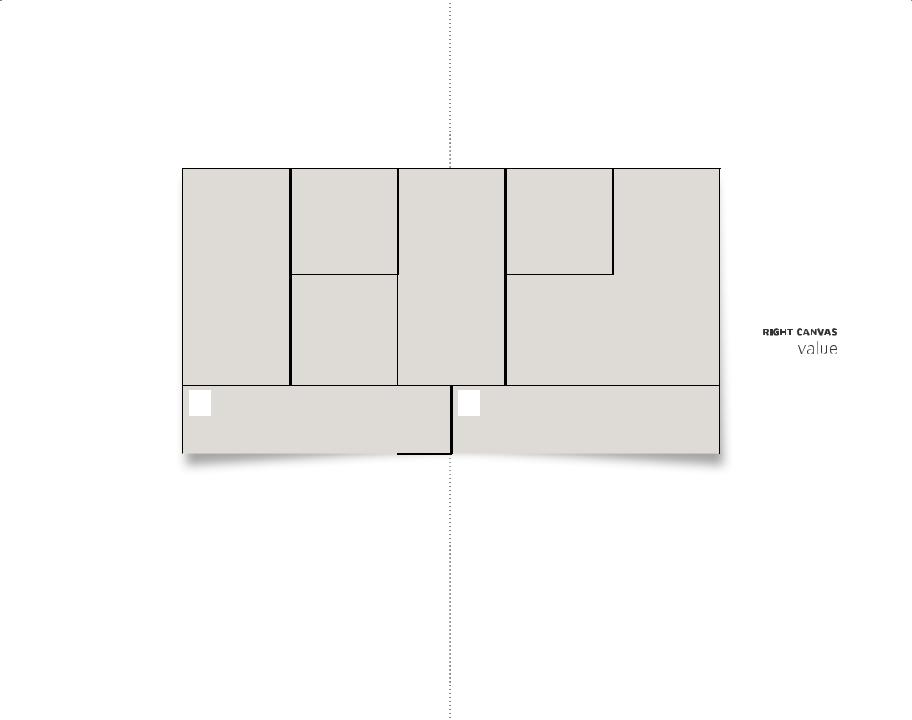
KP |
KA |
VP |
CR |
CS |
KR |
|
CH |
left canvas
efficiency
|
|
|
|
|
|
|
|
C$ |
|
|
R$ |
|
|
|
|
|
|
|
|
|

50HOW DO YOU USE THE CAnVAS?
The public sector is often challenged to implement private sector principles. I have used the Canvas to help a department view itself as a serviceoriented business,
establishing externalized as-is and to-be business models.
It has created a whole new conversation around describing and innovating the business.
Mike Lachapelle, Canada
I consult with small companies on using the freemium business model. This model involves giving core products away for free, which is very counterintuitive to most businesspeople. Thanks
to the Business Model Canvas, I can
easily illustrate how it makes financial sense.
Peter Froberg, Denmark
I help business owners plan their transition and exit from their companies.
Success depends on sustaining longterm company viability and growth. Key to this is a business model innovation program. The Canvas helps us identify and innovate their business models.
Nicholas K. Niemann, United States
I’m using the Business Model Canvas in Brazil to help artists, cultural producers, and game designers to envision innovative business models for the Cultural and Creative Industries. I apply it in the
Cultural Production MBA at FGV and in the Innovation Games Lab at COPPE/ UFRJ Business Incubator.
Claudio D'Ipolitto, Brazil
When you typically think of a business model, the conclusion is that it is a 'for profit' business. However, I found that the Canvas is also very effective in the
non-profit sector. We used it to
DESIGN + ALIGN
members of the leadership team during the formation of a new non-profit program. The Canvas was flexible enough to take into account the goals of this social entrepreneurial venture, and bring clarity to the true Value Proposition of the business and how to make it sustainable.
Kevin Donaldson, United States
I wish I had known the Canvas years ago! With a particular tough and complicated print-to-digital project within the publishing industry it would
have been so helpful to
show all project members in this visual way both the big picture, their (important) own roles in it and the interdependencies.
Hours of explaining, arguing, and misunderstanding could have been saved.
Jille Sol, Netherlands
A close friend was looking for a new job. I used the Business Model
Canvas in order to assess her personal business model.
Her core competences and Value Proposition were outstanding but she failed to leverage her strategic partners and develop appropriate
Customer Relationships. This adjusted focus opened new opportunities.
Daniel Pandza, Mexico

Imagine 60 first-year students, knowing nothing about entrepreneurship. In less than five days, thanks to the Business
Model Canvas, they were able to pitch a viable idea with conviction and clarity.
They used it as a tool to cover all the startup-building dimensions.
Guilhem Bertholet, France
I use the Business Model Canvas to teach early stage entrepreneurs across a wide range of industries as
a much better way to
translate
THEIR BUSInESS
PLANS
InTO THE BUSInESS
PROCESSES
that they (will) need to operate their businesses and to ensure that they are focused properly on being customercentric in a way that makes the business as highly profitable as it can be.
Bob Dunn, United States
I have used the Canvas with a co-founder to design a business plan for a national level contest held by
The Economic Times, India. The Canvas enabled me to think through all the aspects of the startup and put
together a plan that VCs might find well thought out and attractive to fund.
We were asked to redesign the language service of an international nGO. The Business Model Canvas was especially helpful to show the links between the needs of people’s day-to-day work and a service that was felt
too specialized, considered only as an afterthought, and far away from their priorities.
Paola Valeri, Spain
As a startup coach I support teams to create new products and design their businesses. The Business Model Canvas
does a great job assisting me to
remind the teams to think holistically about their business and prevents them from getting stuck
on details. This helps to make their new venture a success.
Christian Schüller, Germany
The Business Model
Canvas has allowed me to establish a common language and framework with colleagues.
I've used the Canvas to explore new growth opportunities, assess uses
of new business models by competitors, and to communicate across the organization how we could
accelerate technology, market, and business model innovations.
Bruce MacVarish, United States
The Business Model Canvas has helped several health care organizations in the netherlands to make the move from a budget driven governmental institution to an entrepreneurial value-adding organization.
Huub Raemakers, Netherlands
I used the Canvas with senior managers of a public company to help them restructure their value chain due to changes in sector regulation. The key success factor was to understand which new Value Propositions could be offered to their clients and then translated into internal operations.
Leandro Jesus, Brazil
We used 15,000 post-its and more than
100 meters of broWn paper
to design a future organizational structure in a global manufacturing company.
The key of all activities was, however, the Business Model Canvas. It convinced us by its practical applicability, simplicity, and logical cause-and-effect relationships.
Daniel Egger, Brazil
I used the Canvas to do a
reality
check
for my new startup Mupps, a platform where artists can make their own music apps for iPhone and Android phones
in minutes. You know what? The Canvas made me even surer of the possible success! So I gotta go, work to do!
Erwin Blom, Netherlands
The Business Model Canvas has proven to be a very useful tool for capturing
ideas and solutions for e-commerce 51 projects. Most of my clients are SMEs
and the Canvas helps them to
clarify their current business models and
understand and focus on the impact of e-commerce on their organizations.
Marc Castricum, Netherlands
I applied the Canvas to help a company align key staff in order to determine shared goals and strategic priorities, which were used during the planning process and incorporated with the BSC.
It also ensured that the chosen initiatives were clearly driven by the new strategic priorities.
Martin Fanghanel, Bolivia
Praveen Singh, India

Patt

erns

“Pattern in architecture is the idea of capturing architectural design ideas
as archetypal and reusable descriptions.”
Christopher Alexander, Architect

This section describes business models with similar characteristics, similar arrangements of business model Building Blocks, or similar behaviors. We call these similarities business model patterns. The patterns described in the following pages should help you understand business model dynamics and serve as a source of inspiration for your own work with business models.
We’ve sketched out five business model patterns built on important concepts in the business literature. We’ve “translated” these into the language of the Business Model Canvas to make the concepts comparable, easy to understand, and applicable. A single business model can incorporate several of these patterns.
Concepts upon which our patterns are based include Unbundling,
the Long Tail, Multi-Sided Platforms, FREE, and Open Business Models.
New patterns based on other business concepts will certainly emerge over time.
Our goal in defining and describing these business model patterns is to recast well-known business concepts in a standardized format—the
Business Model Canvas—so that they are immediately useful in your own work around business model design or invention.
Patterns
56Unbundling Business Models
66 The Long Tail
76 Multi-Sided Platforms
88 FREE as a Business Model
108 Open Business Models

Un-
Bundling
Business
Models

Def_Pattern No. 1
The concept of the “unbundled” corporation holds that there are three fundamentally diΩerent types of businesses: Customer Relationship businesses, product innovation businesses, and infrastructure businesses. • Each type has diΩerent economic, competitive, and cultural imperatives. • The three types may
co-exist within a single corporation, but ideally they are “unbundled” into separate entities in order to avoid conflicts or undesirable trade-oΩs.
[ REF·ER·ENCES ]
1 • “Unbundling the Corporation.” Harvard Business Review. Hagel, John, Singer, Marc. March–April 1999.
2 • The Discipline of Market
Leaders: Choose Your Customers, Narrow Your Focus, Dominate Your
Market. Treacy, Michael, Wiersema, Fred. 1995.
[ EX·AM·PLES ]
mobile telecom industry, private banking industry
unbundling business patterns
57
patterns

unbundling business Models
58
paTTerns
|
1 John Hagel |
|
|
|
2 Hagel and Singer |
|||
|
and Marc Singer, who coined |
|
|
|||||
|
the term “unbundled corporation,” |
|
|
|||||
believe that companies are composed of three |
Bundled |
|
describe the role of Customer |
|||||
very diΩerent types of businesses with diΩerent |
|
|
Relationship businesses as finding and |
|||||
economic, competitive, and cultural imperatives: |
|
|
acquiring customers and building relationships |
|||||
Customer Relationship businesses, product innovation |
|
|
with them. Similarly, the role of product innovation |
|||||
businesses, and infrastructure businesses. Similarly, |
|
|
businesses is to develop new and attractive products and |
|||||
Treacy and Wiersema suggest that companies |
|
|
services, while the role of infrastructure businesses is to build |
|||||
should focus on one of three value disciplines: |
|
|
and manage platforms for high volume, repetitive tasks. Hagel |
|||||
|
operational excellence, product leader- |
|
|
and Singer argue that companies should separate these |
||||
|
ship, or customer intimacy. |
|
|
businesses and focus on only one of the three internally. |
||||
|
|
|
|
|
|
Because each type of business is driven by diΩerent |
||
|
|
|
|
|
|
factors, they can conflict with each other or |
||
|
|
|
|
|
|
produce undesirable trade-oΩs within the |
||
|
|
|
3 On the |
|
|
same organization. |
||
|
|
|
|
|
|
|
|
|
|
|
|
following pages we |
|
|
|
||
|
|
|
show how the idea of unbundling |
|
|
|
||
|
|
|
applies to business models. In the first |
|
|
|
||
|
|
|
example, we describe the conflicts and |
|
|
|
||
|
|
|
|
|
|
|
||
|
Unbundling |
|
undesirable trade-oΩs created by a “bundled” |
|
Unbundled! |
|||
|
|
|
|
|
|
|
|
|
business model within the private banking industry. In the second example we show how mobile telecom operators are unbundling and focusing on new
core businesses.

THREE CORE BUSINESS TYPES
Competition Culture Economics
Product
Innovation
Early market entry enables charging premium prices and acquiring large market share; speed is key
Battle for talent; low barriers to entry; many small players thrive
Employee centered; coddling the creative stars
Customer Relationship |
Infrastructure |
Management |
Management |
High cost of customer acquisition makes it imperative to gain large wallet share; economies of scope are key
Battle for scope; rapid consolidation; a few big players dominate
Highly service oriented; customer- comes-first mentality
High fixed costs make large volumes essential to achieve low unit costs; economies of scale are key
Battle for scale; rapid consolidation; a few big players dominate
Cost focused; stresses standardization, predictability, and eΩiciency
unbundling business paTTerns
59
paTTerns
Source: Hagel and Singer, 1999.

unbundling business Models
60
patterns
Private Banking:
Three Businesses in One
Swiss private banking, the business of providing banking services to the very wealthy, was long known as a sleepy, conservative industry. Yet over the last decade the face of the Swiss private banking industry changed considerably. Traditionally, private banking institutions were vertically integrated and performed tasks ranging from wealth management to brokerage to financial product design. There were sound reasons for this tight vertical integration. Outsourcing was costly, and private banks preferred keeping everything in-house due to secrecy and confidentiality concerns.
But the environment changed. Secrecy became less of an issue with the demise of the mystique surrounding Swiss banking practices, and outsourcing became attractive with the breakup of the banking value chain due to the emergence of specialty service providers such as transaction banks and financial product boutiques. The former focus exclusively on handling banking transactions, while the latter concentrate solely on designing new financial products.
Zurich-based private banking institution Maerki Baumann is an example of a bank that has unbundled its business model. It spun oΩ its transaction-oriented platform business into a separate entity called Incore Bank, which oΩers
banking services to other banks and securities dealers. Maerki Baumann now focuses solely on building Customer Relationships and advising clients.
On the other hand, Geneva-based Pictet, the largest Swiss private bank, has preferred to remain integrated. This 200-year-old institution develops deep Customer Relationships, handles many client transactions, and designs its own financial products. Though the bank has been successful with this model, it has to carefully manage trade-oΩs between three fundamentally diΩerent types of businesses.
The figure opposite depicts the traditional private banking model, describes trade-oΩs, and unbundles it into three basic businesses:
relationship management, product innovation,
and infrastructure management.

Trade Offs
1 The bank serves two diΩerent markets with very diΩerent dynamics. Advising the wealthy is a long-term, relationship-based business.
Selling financial products to private banks is a dynamic, fast-changing business.
2The bank aims to sell its products to competing banks in order to increase revenues—but this creates a conflict of interest.
3 The bank’s product division pressures advisors to sell the bank’s own products to clients. This conflicts with client interest in neutral advice. Clients want to invest in the best products on the market, regardless of origin.
4The costand eΩiciency-focused transaction platform business conflicts with the remunerationintensive advisory and financial products business, which needs to attract costly talent.
5 The transaction platform business requires scale to drive down costs, which is diΩicult to achieve within a single bank.
6 The product innovation business is driven by speed and quick market entry, which is at odds with the long-term business of advising the wealthy.
The Private Banking Model
|
|
|
|
|
|
|
|
|
|
|
|
|
|
|
|
|
|
|
|
|
|
|
|
|
|
|
|
|
|
|
|
|
|
|
|
|
|
|
|
|
|
|
|
|
|
|
|
|
|
|
|
|
|
|
|
|
|
|
|
|
|
|
|
|
|
|
|
|
|
|
6 |
|
|
|
|
|
|
|
|
|
|
|
|
|
|
|
|
|
|
|
|
|
|
|
|
|
|
|
|
|
1 |
|
|
|
|
2 |
|
|
|
|
|
||||||||||||
|
|
|
|
|
|
|
|
|
|
|
|
|
advise |
|
|
|
|
|
|
|
|
|
|
|
|
|
|
|
|
|
|
|
|
|
|
|
|
|
|
||||||||||||||||||||||
|
|
|
|
|
|
|
|
|
|
|
|
|
|
|
|
|
|
|
|
|
|
|
|
|
|
|
|
|
|
|
|
|
|
|
|
personalintimate |
|
|
|
|
|
|
|
||||||||||||||||||
|
|
|
|
|
|
|
|
|
|
|
|
|
|
|
|
|
|
|
|
|
|
|
|
||||||||||||||||||||||||||||||||||||||
|
|
|
|
|
|
|
|
|
product |
r&d |
|
|
|
|
|
|
|
|
|
|
|
|
|
|
|||||||||||||||||||||||||||||||||||||
|
|
|
|
|
|
|
|
|
|
|
|
|
|
|
|
|
|
|
|
|
|
|
|
|
|
|
|
|
|
|
|
|
|
|
|
|
|
|
|
|
|
|
relationship |
|
|
|
|
|
|
|
|
|
|
|
|
|
|
||||
|
|
|
|
|
|
|
|
|
|
|
|
|
marketing |
|
|
|
|
|
|
|
|
|
|
|
|
|
|
|
|
|
|
|
|
|
|
|
|
|
|
|
|
|
|
|
|
|
|
|
|
|
|
|
|||||||||
|
|
|
|
|
|
|
|
|
|
|
|
|
|
|
|
|
|
|
|
|
|
|
|
|
|
|
|
|
|
|
|
|
|
|
|
|
|
|
|
|
|
|
|
wealthy |
|
|
|
|
|||||||||||||
|
|
|
|
|
|
|
|
|
|
|
|
|
|
|
|
|
|
|
|
|
|
|
|
|
|
|
|
|
|
|
|
|
|
|
|
|
|
|
|
|
|
|
key account |
|
|
|
|
|
|
|
|
|
|||||||||
|
|
|
|
|
|
|
|
|
|
|
|
|
|
platform |
|
|
|
|
|
|
|
|
|
|
|
|
|
|
|
|
|
|
|
|
management |
|
|
|
|
|
individuals |
|
|
|
|
||||||||||||||||
|
|
|
|
|
|
|
|
|
|
|
|
|
|
|
|
|
|
|
|
|
|
|
|
|
|
|
|
|
|
|
|
|
|
|
|||||||||||||||||||||||||||
|
|
|
|
|
|
|
|
|
|
|
|
|
|
|
|
|
|
|
|
|
|
|
|
|
|
|
|
|
|
|
|
||||||||||||||||||||||||||||||
|
|
|
|
|
|
|
|
|
|
|
|
|
|
management |
|
|
|
|
|
custom-tailored |
|
|
|
|
|
|
|
|
|
|
|
|
|
|
|
& families |
|
|
|
|
|||||||||||||||||||||
|
|
|
|
|
|
|
|
|
|
|
|
|
|
|
|
|
|
|
|
|
|
|
|
|
|
|
|
wealth manage- |
|
|
|
|
|
|
|
|
|
|
|
|
|
|
|
|
|
|
|
|
|
|
|
||||||||||
|
|
|
|
|
|
|
|
|
|
|
|
|
|
|
|
|
|
|
|
|
|
|
|
|
|
|
|
|
ment services |
|
|
|
|
|
|
|
|
|
|
|
|
|
private banks |
|
|||||||||||||||||
|
other product |
|
|
|
|
|
|
|
|
|
|
|
|
|
|
|
|
|
|
|
|
|
|
|
|
|
|
|
|||||||||||||||||||||||||||||||||
|
|
|
|
|
|
|
|
|
|
|
|
|
|
|
|
|
|
|
|
|
|
|
|
|
|
|
|||||||||||||||||||||||||||||||||||
|
|
|
|
|
|
|
|
|
|
|
|
|
|
|
|
|
|
|
|
|
|
|
|
|
|
|
|
|
|
|
|
|
|
|
|
|
|
|
|
|
|
|
|
|
|
|
|
|
|
|
|
|
|
||||||||
|
|
|
providers |
|
|
|
|
|
|
|
|
|
|
|
|
|
|
|
|
|
|
|
|
|
|
|
|
|
|
|
|
|
|
|
|
|
|
|
|
|
|
|
|
|
|
|
|
|
|
|
|
|
|
|
|||||||
|
|
|
|
|
|
|
|
|
|
|
|
|
|
|
|
|
|
|
|
|
|
|
|
|
financial |
|
|
|
|
|
|
|
|
|
|
private banks |
|||||||||||||||||||||||||
|
|
|
|
|
|
|
|
|
|
|
|
|
|
|
|
|
|
|
|
|
|
|
|
|
|
|
|
|
|
|
|
|
|
|
|
|
|||||||||||||||||||||||||
|
|
|
|
|
|
|
|
|
|
|
|
|
|
|
|
|
|
|
|
|
|
|
|
|
|
|
|
|
|
|
products |
|
|
|
|
|
|
|
|
|
|
|
|
|
|
|
|
|
|
|
|
|
|
|
|
|
|||||
|
|
|
|
|
|
|
|
|
|
|
|
|
|
|
|
|
|
|
|
|
|
|
|
|
|
|
|
|
|
|
|
|
|
|
|
|
|
|
|
|
|
|
personal |
|
|
|
|
|
|
independent |
|
||||||||||
|
|
|
|
|
|
|
|
|
|
|
|
brand/trust |
|
|
|
|
|
|
|
|
|
|
|
|
|
|
|
|
|
|
|
|
|
|
|
|
|||||||||||||||||||||||||
|
|
|
|
|
|
|
|
|
|
|
|
|
|
|
|
|
|
transaction |
|
|
|
|
|
|
networks |
|
|
|
|
|
|
|
|
financial |
|
|
|
||||||||||||||||||||||||
|
|
|
|
|
|
|
|
|
|
|
|
|
|
|
|
|
|
|
|
|
|
|
|
|
|
|
|
|
|
|
|
|
|
|
|
|
|
|
|
|
|
|
|
|
|
||||||||||||||||
|
|
|
|
|
|
|
|
|
|
|
|
|
|
|
|
|
|
|
|
|
|
|
|
|
|
|
|
|
|
management |
|
|
|
|
|
|
|
|
|
|
|
|
|
|
|
advisors |
|
|
|||||||||||||
|
|
|
|
|
|
|
|
|
|
|
|
|
|
|
|
|
|
|
|
|
|
|
|
|
|
|
|
|
|
|
|
|
|
|
|
|
|
|
|
|
|
|
|
|
|
|
|
|
|
|
|
||||||||||
|
|
|
|
|
|
|
|
|
|
|
|
|
product ip |
|
|
|
|
|
|
|
|
|
|
|
|
|
|
|
|
|
|
|
|
|
|
|
|
|
|
|
|
|
|||||||||||||||||||
|
|
|
|
|
|
|
|
|
|
|
|
|
|
|
|
|
|
|
|
|
|
|
|
|
|
|
|
|
|
|
|
sales force |
|
|
|
|
|
|
|
|
|
|
|
|
|
|
|||||||||||||||
|
|
|
|
|
|
|
|
|
|
|
|
|
|
|
|
|
|
|
|
|
|
|
|
|
|
|
|
|
|
|
|
|
|
|
|
|
|
|
|
|
|
|
|
|
|
|
|
|
|
|
|
|
|
|
|
|
|||||
|
|
|
|
|
|
|
|
|
|
|
|
|
|
|
|
|
|
|
|
|
|
|
|
|
|
|
|
|
|
|
|
|
|
|
|
|
|
|
|
|
|
|
|
|
|
|
|
|
|
|
|
|
|
|
|
|
|
|
|
|
|
|
|
|
|
|
|
|
|
|
|
|
|
transaction |
|
|
|
|
|
|
|
|
|
|
|
|
|
|
|
|
|
|
|
|
|
|
|
|
|
|
|
|
|
|
|
|
|
|
|
||||||||||||||
|
|
|
|
|
|
|
|
|
|
|
|
|
|
|
|
|
|
|
|
|
|
|
|
|
|
|
|
|
transaction |
|
|
|
|
|
|
|
|
|
|
|
|
|
|||||||||||||||||||
5 |
platform |
|
|
|
|
|
|
|
|
|
|
|
|
|
|
|
|
|
|
|
|
|
|
|
|
|
|
|
|
|
|
|
|
|
|
||||||||||||||||||||||||||
|
|
|
|
|
|
|
|
|
|
|
|
|
|
|
|
|
|
|
|
|
platform |
|
|
|
|
|
|
|
|
|
|
|
|
|
|
|
|
||||||||||||||||||||||||
|
|
|
|
|
|
|
|
|
|
|
|
|
|
|
|
|
|
|
|
|
|
|
|
|
|
|
|
|
|
|
|
|
|
|
|
|
|
|
|
|
|
|
|
|
|
|
|
|
|
|
|
|
|
|
|
||||||
|
|
|
|
|
|
|
|
|
|
|
|
|
|
|
|
|
|
|
|
|
|
|
|
|
|
|
|
|
|
|
|
|
|
|
|
|
|
|
|
|
|
|
|
|
|
|
|
|
|
|
|
|
|
|
|
|
|
|
|
|
|
|
|
|
|
|
|
|
|
|
|
|
|
|
|
|
|
|
|
|
|
|
|
|
|
|
|
|
|
|
|
|
|
|
|
|
|
|
|
|
|
|
|
|
|
|
|
|
|
|
|
|
|
|
|
|
|
|
|
|
|
|
|
|
|
|
|
|
|
|
|
|
|
|
|
|
|
|
|
|
|
|
|
|
3 |
|
|
|
|
|
|
|
|||||||||||||||||||||||||||||||||
|
|
|
platform management |
4 |
|
|
|
|
|
|
management & advisory fees |
||||||||||||||||||||||||||||||||||||||||||||||||||
|
|
|
|
|
|
|
|
|
|
|
|
|
|
|
|
|
|
|
|
|
|
|
|
|
|
|
|
||||||||||||||||||||||||||||||||||
|
|
|
|
|
|
|
|
|
|
|
hr: r&d |
|
|
|
|
|
|
|
|
|
|
|
|
product & performance fees |
|||||||||||||||||||||||||||||||||||||
|
|
|
|
|
|
|
|
|
|
|
|
|
|
|
|
|
|
|
|
|
|
|
|
|
|
|
|
|
|
||||||||||||||||||||||||||||||||
|
|
|
|
|
|
|
hr: private bankers |
|
|
|
|
|
|
|
|
|
|
|
|
|
|
|
|
transaction fees |
|||||||||||||||||||||||||||||||||||||
|
|
|
|
|
|
|
|
|
|
|
|
|
|
|
|
|
|
|
|
|
|
|
|
|
|
|
|
|
|
|
|
|
|
|
|
|
|
|
|
|
|
|
|
|
|
|
|
|
|
|
|
|
|
|
|
|
|
|
|
|
|
|
|
|
|
|
Relationship |
|
|
|
|
|
|
|
|
Product Innovation |
|
|
Infrastructure |
|
|
|
|
|
|
|
|
|
|
|
|
||||||||||||||||||||||||||||||||
|
|
|
• |
|
|
|
|
|
|
• |
|
• |
|
|
|
|
|
|
|
|
|
|
|
|
|||||||||||||||||||||||||||||||||||||
|
|
|
|
|
Business |
|
|
|
|
|
|
|
|
|
Business |
|
|
|
|
|
|
|
Business |
|
|
|
|
|
|
|
|
|
|
|
|
|
|
|
|
|
|
|
|
|
|||||||||||||||||
|
|
|
|
|
|
|
|
|
|
|
|
|
|
|
|
|
|
|
|
|
|
|
|
|
|
|
|
|
|
|
|
|
|
|
|
|
|
|
|
|
|||||||||||||||||||||
|
|
|
|
|
|
|
|
|
|
|
|
|
|
|
|
|
|
|
|
|
|
|
|
|
|
|
|
|
|
|
|
|
|
|
|
|
|
|
|
|
|
|
|
|
|
|
|
|
|
|
|
|
|
|
|
|
|
|
|
|
|
unbundling business patterns
61
patterns
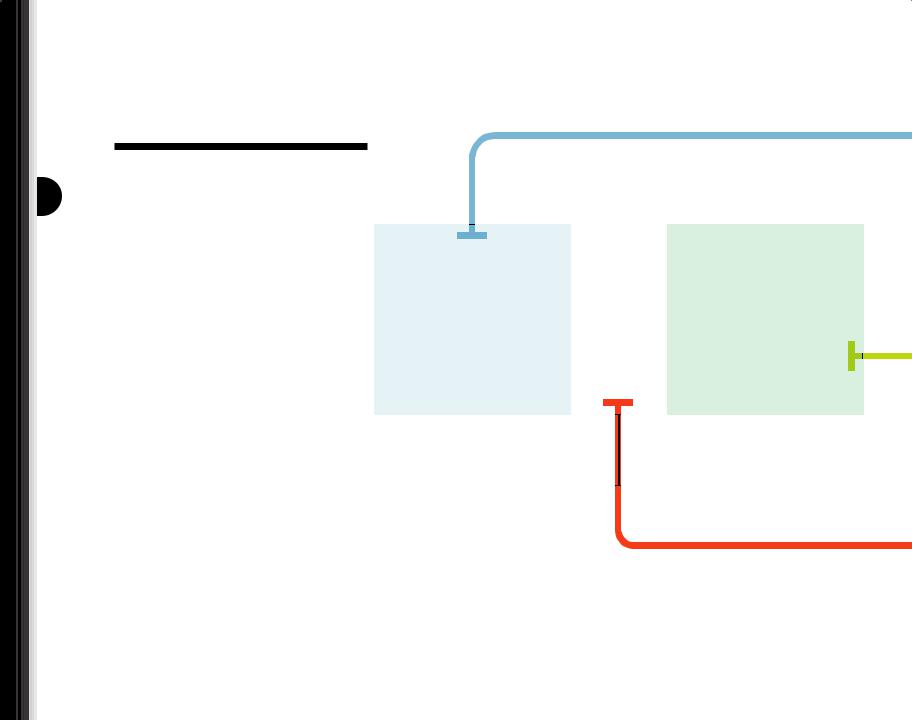
unbundling business Models
62
patterns
Unbundling the
Mobile Telco
Infrastructure Management
Mobile telecommunication firms have started unbundling their businesses. Traditionally they competed on network quality, but now they are striking network sharing deals with competitors or outsourcing network operations altogether to equipment manufacturers. Why? Because they realize that their key asset is no longer the network—it is their brand and their Customer Relationships.
|
network |
|
|
|
|
|
maintenance |
|
|
acquisition |
|
|
services |
|
|
|
|
|
|
|
retention |
|
|
|
provisioning |
|
|
|
|
telecom |
marketing |
voice |
|
installed |
|
|
|
||||
equipment |
|
|
|
|
|
|
data |
|
customer base |
||
suppliers |
|
|
|||
|
|
|
|||
|
network |
content |
|
|
|
|
|
|
Customer |
Relationship |
|
|
brand |
|
|
||
|
|
|
|||
|
|
|
|||
|
|
|
|
|
|
|
customer |
|
|
retail |
|
|
base |
|
|
|
|
|
|
|
|
|
|
network maintenance |
|
|
voice |
||
|
|
data |
|||
|
marketing |
|
|
||
|
|
|
service revenues |
||
|
|
|
|
||
|
|
|
|
|
|
Product Innovation
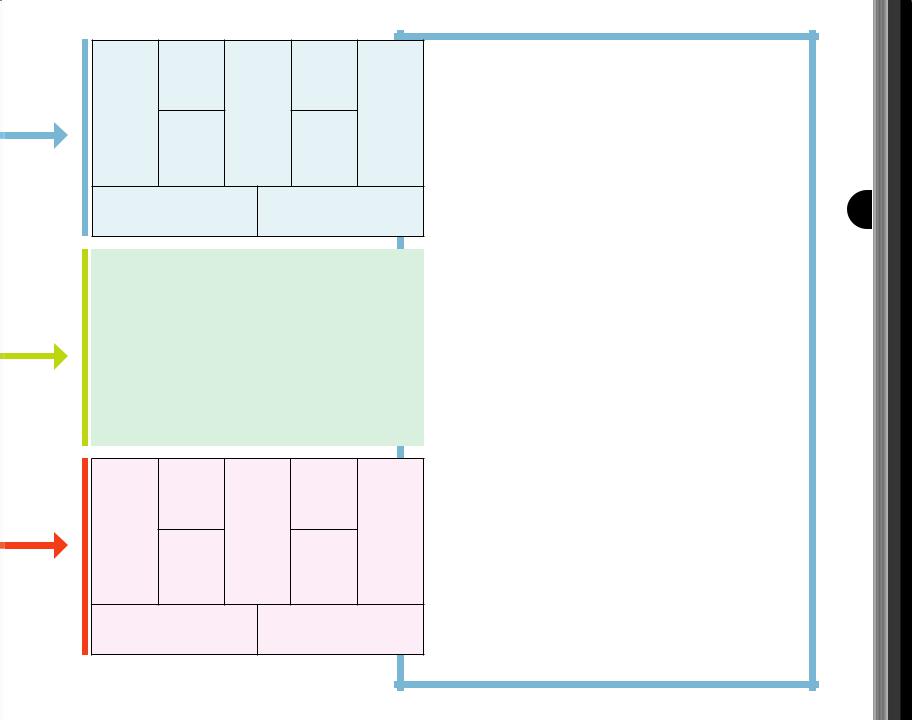
network maintenance
services
provisioning network infrastruc-
ture telcos operation &
maintenance
network
economies of scale
|
|
|
|
|
acquisition |
|
|
|
|
|
|
retention |
|
network |
|
|
voice |
|
installed |
|
|
|
|
|
|
||
operators |
|
|
data |
|
customer |
|
|
|
content |
|
base |
||
|
|
brand |
|
|
||
|
|
|
|
retail |
|
|
|
|
|
|
|
|
|
|
|
customer |
|
|
|
|
|
|
base |
|
|
|
|
|
|
|
|
|
|
|
|
marketing |
|
|
service revenues |
||
|
|
|
|
|
|
|
r&d
new
products telcos & services
intellectual property
licensing fees
Equipment Manufacturers
Telcos such as France Telecom, KPN, and Vodafone have outsourced operation and maintenance of some of their networks to equipment manufacturers such as Nokia Siemens Networks, Alcatel-Lucent, and Ericsson. Equipment manufacturers can run the networks at lower cost because they service several telcos at a time and thus benefit from economies of scale.
Unbundled Telco
After unbundling its infrastructure business, a telco can sharpen its focus on branding and segmenting customers and services. Customer relationships comprise its key asset and its core business. By concentrating on customers and increasing share of wallet with current subscribers, it can leverage investments made over the years acquiring and retaining customers. One of the first mobile telcos to pursue strategic unbundling was Bharti Airtel, now one of India’s leading telcos. It outsourced network operations to Ericsson and Nokia Siemens Networks and IT infrastructure to IBM, allowing the company to focus on its core competency: building Customer Relationships.
Content Providers
For product and service innovation, the unbundled telco can turn to smaller, creative firms. Innovation requires creative talent, which smaller and more dynamic organizations typically do a better job of attracting. Telcos work with multiple third-parties that assure a constant supply of new technologies, services, and media content such as mapping, games, video, and music. Two examples are Mobilizy of Austria and Sweden’s tat. Mobilizy focuses on
location-based service solutions for smartphones (it developed a popular mobile travel guide), and tat concentrates on creating advanced mobile user interfaces.
unbundling business patterns
63
patterns
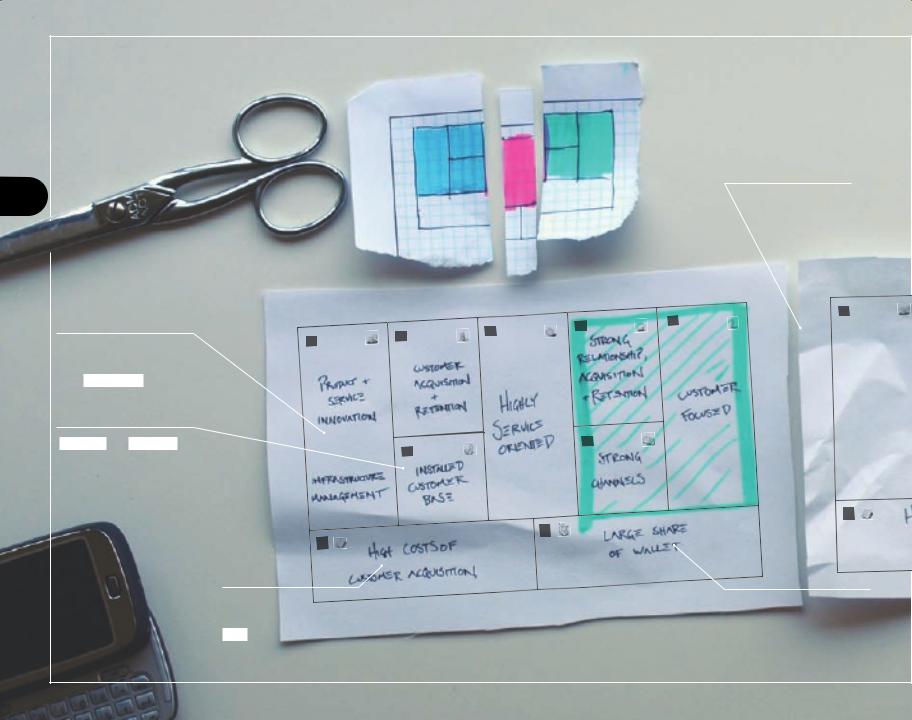
Models
patterns
Unbundled
Product and service innovation, infrastructure acquired from third parties
key assets and resources are the customer base and subscriber trust acquired over time
Customer acquisition and retention comprise main costs, which include branding and marketing expenses
Everything in this model is tailored to understanding and serving customers, or building strong Customer Relationships
This model aims at generating revenues with a broad scope
of products built upon customer trust—the goal is to win a large “share of wallet”
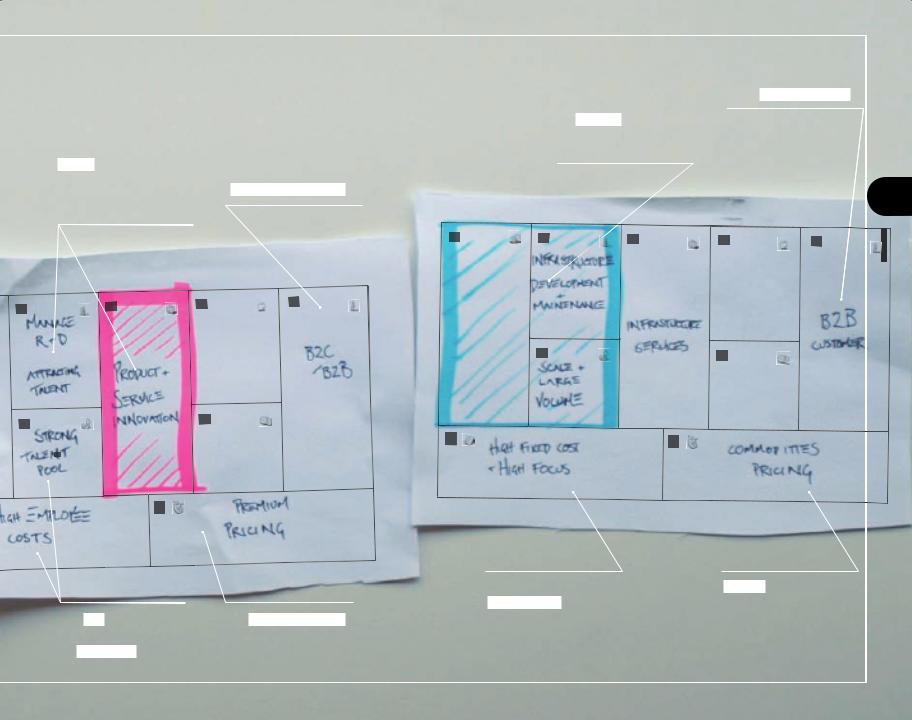
activity is focused on leveraging research and development to bring new products and services to market
Products and services can be brought to market directly, but are usually delivered through B2B intermediaries focused on customer relationships
The activities and oΩer are focused on delivering infrastructure services
Services are usually delivered to business customers
unbundling business Models
65
High cost base due to the |
High premium chargeable |
battle over creative talent, |
because of novelty factor |
the key resource in this |
|
model |
|
Platform is characterized by high fixed costs, which are leveraged through scale and large volume
revenues are based on low margins and high volume

The
Long
Tail

Def_Pattern No. 2
long tail business models are about selling less of more: They focus on oΩering a large number of niche products, each of which sells relatively infrequently. • Aggregate sales of niche items can be as lucrative as the traditional model whereby a small number of bestsellers account for most revenues. • Long Tail business models require low inventory costs and strong platforms to make niche content readily available to interested buyers.
[ REF·ER·ENCES ]
1 • The Long Tail: Why
the Future of Business
Is Selling Less of More.
Anderson, Chris. 2006.
2 • “The Long Tail.” Wired
Magazine. Anderson,
Chris. October 2004.
[ EX·AM·PLES ]
Netflix, eBay, YouTube,
Facebook, Lulu.com
the long tail
67
patterns

# of Sales
simple software
with professional results.
2. Democratization of distribution: The Internet has made digital content distribution a commodity, and dramatically lowered inventory, communications, and transaction costs, opening up new markets for niche products.
3. Falling search costs to connect supply with demand: The real challenge of selling niche content is finding interested potential buyers. Powerful search and recommendation engines, user ratings, and communities of interest have made this
much easier.

THe long Tail
69
paTTerns
 Focus on a large number of products, each selling in low volumes
Focus on a large number of products, each selling in low volumes
Anderson’s research focuses primarily on the media industry. For example, he showed how online video rental company Netflix moved toward licensing a large number of niche movies. While each niche
movie is rented relatively infrequently, aggregate revenue from Netflix’s vast niche film catalog rivals that from the rental of blockbuster movies.
But Anderson demonstrates that the Long Tail
concept applies outside the media industry as well. The success of online auction site eBay is based on a huge army of auctioneers selling and buying small quantities of “non-hit” items.
# of Products
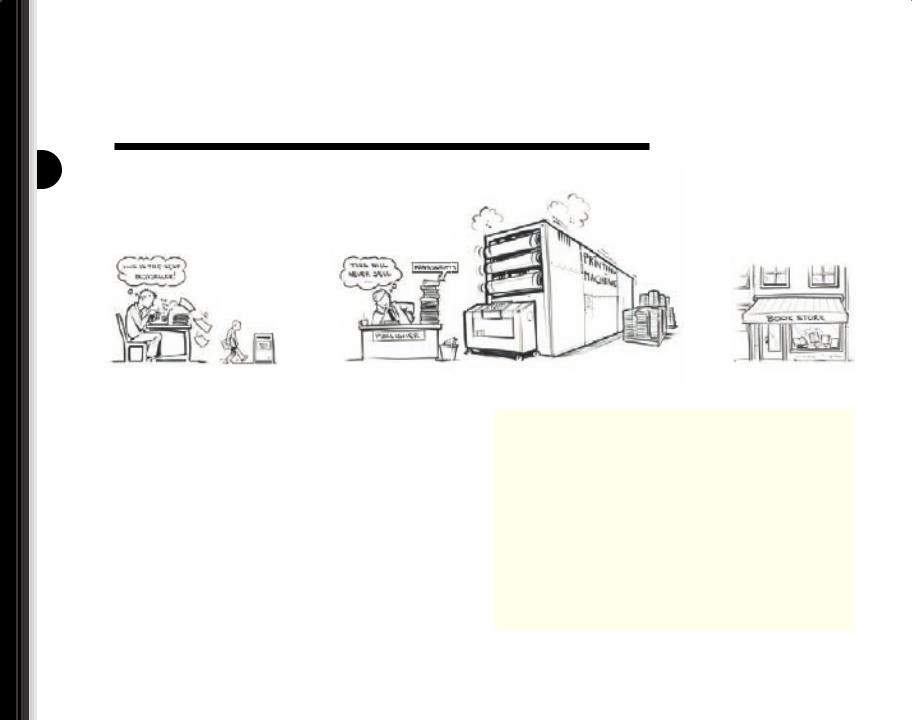
the long tail
70
patterns
TheTransformation of the
Book Publishing Industry
Old Model
We’ve all heard about aspiring authors who carefully craft and submit manuscripts to publishing houses in the hope of seeing their work in print—and face constant rejection. This stereotypical image of publishers and authors holds much truth. The traditional book publishing model
is built on a process of selection whereby publishers screen many authors and manuscripts and select those that seem most likely to achieve minimum sales targets. Less promising authors and their titles are rejected because it would be unprofitable to copyedit, design, print, and promote books that sell poorly. Publishers are most interested in books they can print in quantity for sale to large audiences.
|
content |
|
|
|
|
|
|
acquisition |
|
|
|
|
|
|
publishing |
|
|
|
– |
|
|
|
|
|
|
|
|
|
sales |
|
broad |
|
|
|
|
|
|
|
broad |
||
- |
|
|
content |
|
||
|
|
(ideally |
|
audience |
||
|
|
|
|
|||
|
publishing |
|
"hits") |
|
|
|
|
|
|
|
retail |
|
|
|
knowledge |
|
|
|
|
|
|
content |
|
|
|
network |
|
|
|
|
|
|
|
|
|
|
|
|
|
|
|
publishing / marketing |
|
|
wholesale revenues |
|||
|
|
|
|
|
|
|
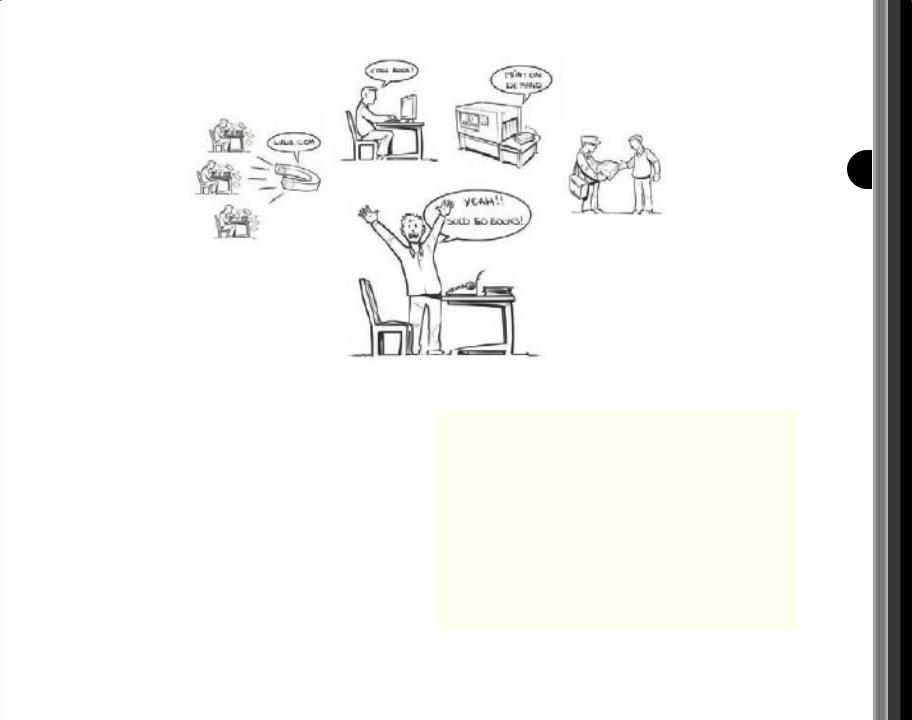
the long tail
71
patterns
A New Model
Lulu.com turned the traditional bestseller-centric publishing model on its head by enabling anyone to publish. Lulu.com’s business model is based on helping niche and amateur authors bring their work to market. It eliminates traditional entry barriers by providing authors the tools to craft, print, and distribute their work through an online marketplace. This
contrasts strongly with the traditional model of selecting “market-worthy” work. In fact, the more authors Lulu.com attracts, the more it succeeds, because authors become customers. In a nutshell, Lulu.com is a multisided platform (see p. 76) that serves and connects authors and readers with a Long Tail of user-generated niche content. Thousands of authors use Lulu.com’s self-service tools to publish and sell their books. This works because books are printed only in response to actual orders. The failure of a particular title to sell is irrelevant to Lulu.com, because such
a failure incurs no costs.
|
platform |
|
|
|
communities |
|
|
|
|
|
of interest |
|
|
|
development |
|
|
|
|
|
|
|
|
|
|
|
|
|
logistics |
|
|
|
online |
niche |
|
|
self-publish- |
profile |
|||
|
|
|
authors |
|||
|
|
|
ing services |
|
||
|
|
|
|
|
||
- |
|
|
marketplace |
|
|
|
|
|
|
|
|||
|
platform |
|
for niche |
|
niche |
|
|
print-on- |
|
content |
|
audiences |
|
|
|
|
|
lulu.com |
||
|
|
|
|
|
||
|
demand |
|
|
|
|
|
|
infrastruc- |
|
|
|
|
|
|
ture |
|
|
|
|
|
|
|
|
|
|
|
|
platform management |
|
sales commissions (low) |
||||
& development |
|
|
publishing service fees |
|||
|
|
|
|
|
||
|
|
|
|
|
|
|

the long tail
72
patterns
LEGO®’s New Long Tail
The Danish toy company LEGO started manufacturing its now famous interlocking bricks in 1949. Generations of children have played with them, and LEGO has released thousands of kits around a variety of themes, including
space stations, pirates, and the Middle Ages. But over time, intensifying competition in the toy industry forced LEGO to seek innovative new paths to growth. It started licensing the rights to use characters from blockbuster movies such as Star Wars, Batman, and Indiana Jones. While such licensing is expensive, it proved to be an impressive revenue generator.
In 2005 LEGO started experimenting with user-generated content. It introduced LEGO Factory, which allows customers to assemble their very own LEGO kits and order them online. Using software called LEGO Digital Designer, customers can invent and design their own buildings, vehicles, themes, and characters, choosing from thousands of components and dozens of colors. Customers can even design the box containing the customized kit. With LEGO Factory, LEGO turned passive users into active participants in the LEGO design experience.
This requires transforming the supply chain infrastructure, and because of low volumes LEGO has not yet fully adapted its support infrastructure to the new LEGO Factory model. Instead, it simply tweaked existing resources
and activities.
In terms of a business model, though, LEGO took a step beyond mass customization by entering Long Tail territory. In addition to helping users design their own LEGO sets, LEGO Factory now sells user-designed sets online. Some sell well; some sell poorly or not at all. What’s important for LEGO is that the user-designed sets expand a product line previously focused on a limited number of best-selling kits. Today this aspect of LEGO’s business accounts for only a small portion of total revenue, but it is a first step towards implementing a Long Tail model as a complement—or even alternative—to a traditional mass-market model.
LEGO
+
LEGO users can make their own designs and order them online
=
LEGO Factory
+
LEGO allows users to post and sell their designs online
=
LEGO Users Catalog
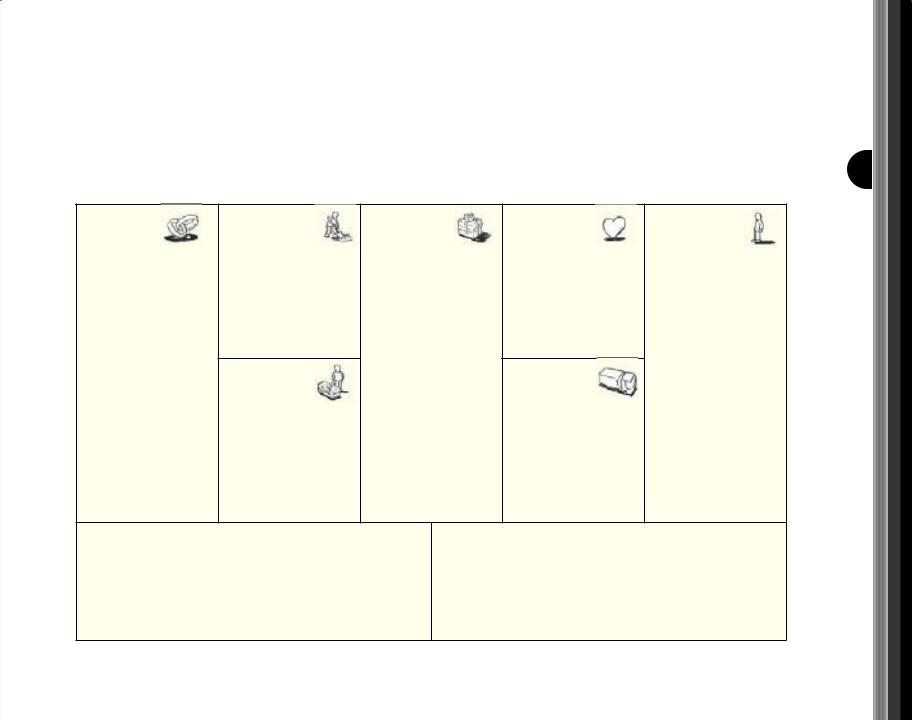
LEGO Factory: Customer-Designed Kits
KP
Customers who build new LEGO designs and post them online become key partners generating content and value
KA
LEGO has to provide and manage the platform and logistics that allow packaging and delivery of custommade LEGO sets
KR
LEGO has not yet fully adapted its resources and activities, which are optimized primarily for the mass market
VP
LEGO Factory substantially expands the scope of the oΩ-the-shelf
kit oΩering by giving LEGO fans the tools to build, showcase, and sell their own customdesigned kits
CR
LEGO Factory builds a Long Tail community around customers who are truly interested in niche content and want to go beyond oΩ-the- shelf retail kits
CH
LEGO Factory’s existence depends heavily on the Web channel
CS
Thousands of new, customer-designed kits perfectly complement LEGO’s standard sets of blocks. LEGO Factory connects customers who create customized designs with other customers, thus becoming a customer matchmaking platform and increasing sales
C$ 
LEGO Factory leverages production and logistics costs already incurred by its traditional retail model
R$ 
LEGO Factory aims to generate small revenues from a large number of customer-designed items. This represents a valuable addition to traditional high-volume retail revenues
the long tail
73
patterns

74
patterns
Pattern
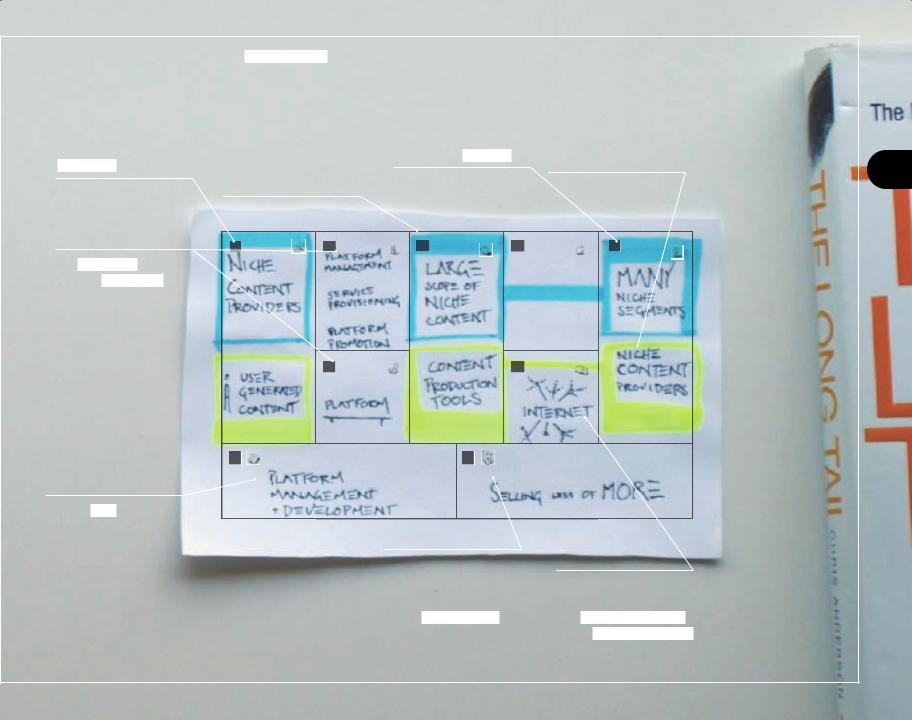
Niche content providers (professional and/or user-generated) are the key partners in this pattern.
The key resource is the platform; key activities include platform development and maintenance and niche content acquisition and production.
The main costs incurred cover platform development and maintenance
The value proposition of a Long Tail business model is characterized by oΩering a wide scope of “non-hit” items that may co-exist with “hit” products. Long Tail business models may also facilitate and build on user-generated content.
Long Tail business models focus on niche customers.
This model is based on aggregating small revenues from a large number of items. revenue streams vary; they may come from advertising, product sales, or subscriptions.
A Long Tail business model can serve both professional and amateur content producers, and may create a multi-sided platform (see p. 76) catering to users and producers alike.
Long Tail business models usually rely on the Internet as a customer relationship and/or transaction channel.
the long tail
75
patterns

Multi-
Sided
Platforms

Def_Pattern No. 3
multi-sided platforms bring together two or more distinct but interdependent groups of customers. • Such platforms are of value to one group of customers only if the other groups of customers are also present. • The platform creates value by facilitating interactions between the diΩerent groups. • A multi-sided platform grows in value to the extent that it attracts more users, a phenomenon known as the network eΩect.
[ REF·ER·ENCES ]
1 • “Strategies for Two-Sided Markets.” Harvard Business Review. Eisenmann, Parker, Van Alstyne. October 2006.
2 • Invisible Engines: How
Software Platforms Drive Innovation and Transform Industries. Evans, Hagiu, Schmalensee. 2006.
3 • “Managing the Maze of Multisided Markets.”
Strategy & Business.
Evans, David. Fall 2003.
[ EX·AM·PLES ]
Visa, Google, eBay,
Microsoft Windows,
Financial Times
Multi-sided platforMs
77
patterns

MulTi-sided plaTForMs
78
paTTerns
Multi-sided platforms, known by economists as multisided markets, are an important business phenomenon. They have existed for a long time, but proliferated with the rise of information technology. The Visa credit card, the Microsoft Windows operating system, the Financial Times, Google, the Wii game console, and Facebook are just a few examples of successful multi-sided platforms. We address them here because they represent an increasingly important business model pattern.
What exactly are multi-sided platforms? They are platforms that bring together two or more distinct but interdependent groups of customers. They create value as intermediaries by connecting these groups. Credit cards, for example, link merchants with cardholders; computer operating systems link hardware manufacturers, application developers, and users; newspapers link readers and advertisers; video gaming consoles link game developers with players. The key is that the platform must attract and serve all groups simultane-
ously in order to create value. The platform’s value for a particular user group depends substantially on the number of users on the platform’s “other sides.” A video game console will only attract buyers if enough games are available for the platform. On the other hand, game developers will develop games for a new video console only if a substantial number of gamers already use it. Hence multi-sided platforms often face a “chicken and egg” dilemma.
One way multi-sided platforms solve this problem is by subsidizing a Customer Segment. Though a platform operator incurs costs by serving all customer groups, it often decides to lure one segment to the platform with an inexpensive or free Value Proposition in order to subsequently attract users of the platform’s “other side.” One diΩiculty multi-sided platform operators face is understanding which side to subsidize and how to price correctly to attract customers.
Segments ≥ 2

 Customer
Customer
Segment A

Segment B
FACILITATE


 INTERACTION
INTERACTION
etc.
etc.
Segment N
One example is Metro, the free daily newspaper that originated in Stockholm and can now be found in many large cities worldwide. It launched in 1995 and immediately attracted a large readership because it was distributed free of charge to urban commuters in train and bus stations throughout Stockholm. This allowed it to attract advertisers and rapidly become profitable. Another example is Microsoft, which gave its Windows software development kit (SDK) away
for free to encourage development of new applications for its operating system. The larger number of applications attracted more users to the Windows platform and increased Microsoft’s revenues. Sony’s Playstation 3 game console, on the other hand, is an example of
a multi-sided platform strategy that backfired. Sony subsidized each console purchased in hopes of later collecting more game royalties. This strategy performed poorly because fewer Playstation 3 games sold than Sony initially estimated.
Operators of multi-sided platforms must ask themselves several key questions: Can we attract suΩicient numbers of customers for each side of the platform? Which side is more price sensitive? Can that side
be enticed by a subsidized oΩer? Will the other side of the platform generate suΩicient revenues to cover the subsidies?
The following pages outline three examples of multisided platform patterns. First, we sketch Google’s multi-sided platform business model. Then we show how Nintendo, Sony, and Microsoft compete with slightly diΩerent multi-sided platform patterns. Finally, we describe how Apple has slowly evolved into an operator of a powerful multi-sided platform.
MulTi-sided plaTForMs
79
paTTerns
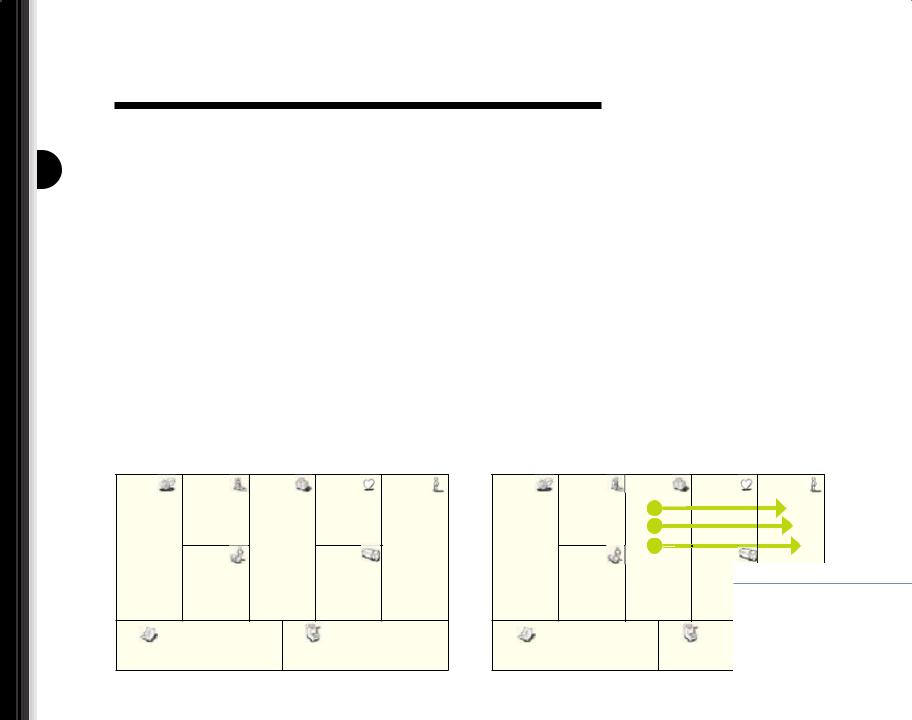
Multi-sided platforMs
80
patterns
Google’s Business Model
The heart of Google’s business model is its Value Proposition of providing extremely targeted text advertising globally over the Web. Through a service called AdWords, advertisers can publish advertisements and sponsored links on Google’s search pages (and on an aΩiliated content network as we will later see). The ads are displayed alongside search results when people use the Google search engine. Google ensures that only ads relevant to the search term are displayed. The service is attractive to advertisers because it allows them to tailor online campaigns to specific searches and particular demographic targets. The model only works, though, if many people use Google’s search engine. The more people Google reaches, the more ads it can display and the greater the value created for advertisers.
Google’s Value Proposition to advertisers depends heavily on the number of customers it attracts to its Web site. So Google caters to this second group of consumer customers with a powerful search engine and a growing number of tools such as Gmail (Web based e-mail), Google maps, and Picasa (an online photo album) among others. To extend its reach even further, Google designed a third service that enables its ads to be displayed on other, nonGoogle Web sites. This service, called AdSense, allows third parties to earn a portion of Google's advertising revenue by showing Google ads on their own sites. AdSense automatically analyzes a participating Web site’s content and displays relevant text and image ads to visitors. The Value Proposition to these third party Web site owners, Google’s third Customer Segment, is to enable them to earn money from their content.
KP |
KA |
VP |
CR |
CS |
KP |
KA |
VP |
CR |
CS |
|
|
|
|
|
|
|
targeted ads |
|
advertisers |
|
|
|
|
|
|
|
free search |
|
surfers |
|
|
targeted |
|
advertisers |
|
|
monetizing |
|
content |
|
KR |
CH |
|
KR |
nt |
CH |
creators |
||
|
ads |
|
|||||||
|
|
|
|
|
|
|
|
|
|
|
|
|
|
|
|
|
|
|
Google oΩers distinct |
C$ |
|
R$ |
|
|
C$ |
|
R$ |
|
Value Propositions to |
|
|
|
|
|
three interdependent |
Customer Segments
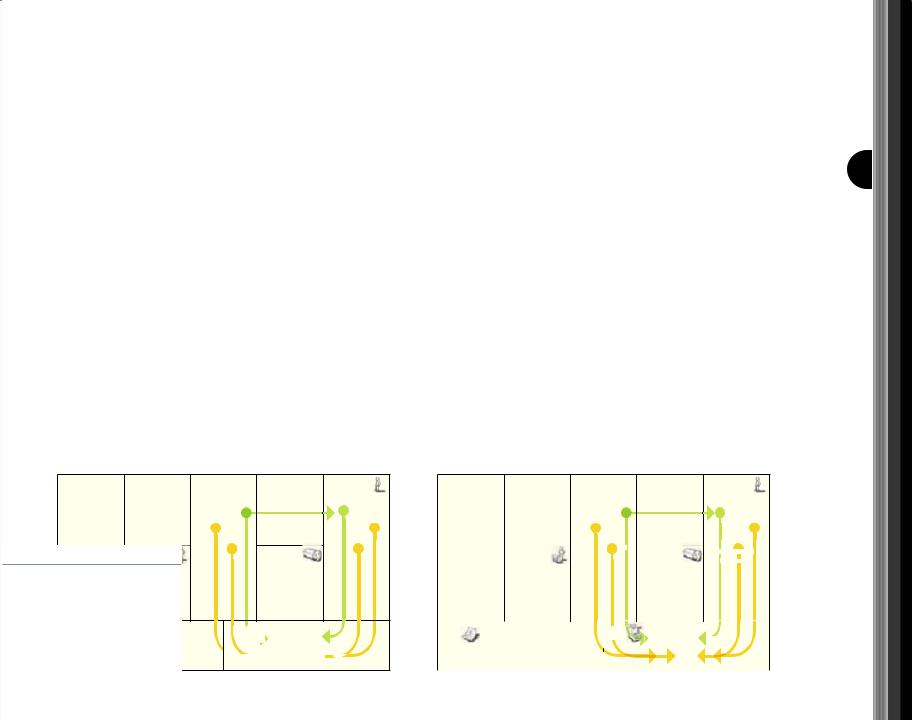
As a multi-sided platform Google has a very distinct revenue model. It makes money from one Customer Segment, advertisers, while subsidizing free oΩers to two other segments: Web surfers and content owners. This is logical because the more ads it displays to Web surfers, the more it earns from advertisers. Increased advertising earnings, in turn, motivates even more content owners to become AdSense partners. Advertisers don’t directly buy advertising space from Google. They bid on ad-related keywords associated with either search terms or content on third party Web sites. The bidding occurs through an AdWords auction service: the more popular a keyword, the more an advertiser has to pay for it. The substantial revenue that Google earns from AdWords allows it to continuously improve its free oΩers to search engine and AdSense users.
Google’s Key Resource is its search platform, which powers three diΩerent services: Web search (Google.com), advertising (AdWords), and third-party content monetization (AdSense). These services are based on highly complex proprietary search and matchmaking algorithms supported by an extensive IT infrastructure. Google’s three Key Activities can be defined as follows: (1) building and maintaining the search infrastructure, (2) managing the three main services, and (3) promoting the platform to new users, content owners, and advertisers.
KP KA
KR
Google has one main Revenue Stream that subsidizes other oΩers (Revenue Stream is replaced by “free”)
VP |
CR |
CS |
targeted ads |
advertisers |
|
free search
monetizing content CH
R$  keyword ti
keyword ti 

 free
free

KP |
KA |
VP |
CR |
CS |
|
platform |
|
|
|
|
management, |
|
|
|
|
managing |
|
|
|
|
services, |
targeted ads |
|
advertisers |
|
expanding |
|
|
|
|
free search |
|
|
|
|
reach |
|
|
|
|
monet |
izi |
ng |
|
|
|
|
|
|
|
|
|
|
|
|
|
|
|
|
||
|
KR |
content |
|
|
|
|
CH |
|
|
|
|
|
|
|
|
|
|
|
|
|||
|
search |
|
|
|
|
|
|
|
|
|
|
|
|
|
|
|
|
|
|
|
|
|
|
platform |
|
|
|
|
|
|
|
|
|
|
|
|
|
|
|
|
|
|
|
|
|
|
|
|
|
|
|
|
|
|
|
|
|
|
|
|
|
|
|
|
|
|
|
|
C$ |
|
|
|
|
|
|
|
keyword |
c |
|
|
|
|
|
|
|
|
|
|
|
|
|
|
|
|
|
|
|
|
|
|
|
|
|
|
|
|
|
|
|
|
||||
platform costs |
|
|
|
|
|
|
|
free |
|
|
|
|
|
|
|
|
|
|
|
|
||
|
|
|
|
|
|
|
|
|
|
|
|
|
|
|
|
|
|
|
|
|
||
|
|
|
|
|
|
|
|
|
|
|
|
|
|
|
|
|
|
|
|
|
|
|
Multi-sided platforMs
81
patterns
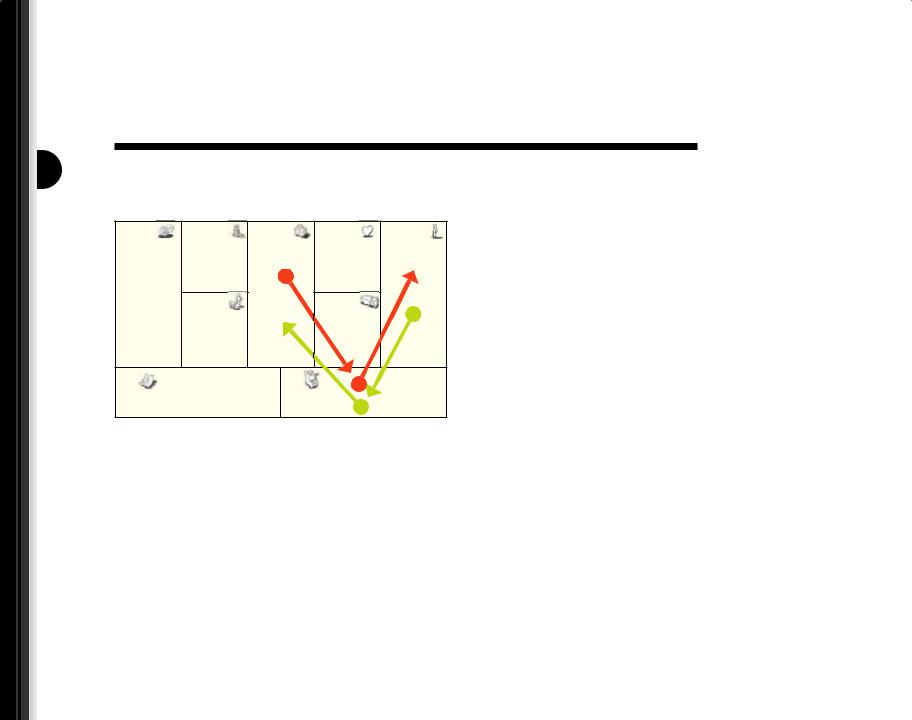
Multi-sided platforMs
82
patterns
Wii versus PSP/Xbox
Same Pattern, DiΩerent Focus
KP |
KA |
VP |
CR |
CS |
|
|
high per- |
|
hardcore |
|
|
formance |
|
|
|
|
|
m |
|
|
|
conso e |
|
|
|
|
|
|
|
|
KR |
console |
|
am |
|
|
|
||
|
|
|
developers |
|
|
|
audience |
|
|
|
|
|
|
|
C$ |
|
|
hardware |
|
|
|
|
sales a |
a l |
|
|
|
royalties |
|
PSP/Xbox Focus
Video game consoles, today a multi-billion dollar business, provide good examples of double-sided platforms. On one hand, a console manufacturer has to draw as many players as possible to attract game developers. On the other hand, players only buy the hardware if there is a suΩicient number of interesting games available for that console. In the game industry, this has led to a fierce battle between three main competitors and their respective devices: the Sony Playstation series, the Microsoft Xbox series, and the Nintendo Wii. All three are based on double-sided platforms, but there are substantial diΩerences between the Sony/Microsoft business model and Nintendo’s approach, demonstrating that there is no “proven” solution for a given market.
Sony and Microsoft dominated the game console market until Nintendo’s Wii swept the sector with a fresh approach to technology and an astonishingly diΩerent business model. Before launching the Wii, Nintendo was spiraling downward, rapidly losing market share, and teetering on the edge of bankruptcy. The Wii console changed all that and catapulted the company to the market leader position.
Traditionally, video console manufacturers targeted avid gamers and competed on console price and performance. For this audience of “hardcore gamers” graphics and game quality and processor speed were the main selection criteria. As a consequence, manufacturers developed extremely sophisticated and expensive consoles and sold them at a loss for years, subsidizing the hardware with two other revenue sources.
First, they developed and sold their own games for their own consoles. Second, they earned royalties from third party developers who paid for the right to create games for specific consoles. This is the typical pattern of a double-sided platform business model: one side, the consumer, is heavily subsidized to deliver as many consoles as possible to the market. Money is then earned from the other side of the platform: game developers.
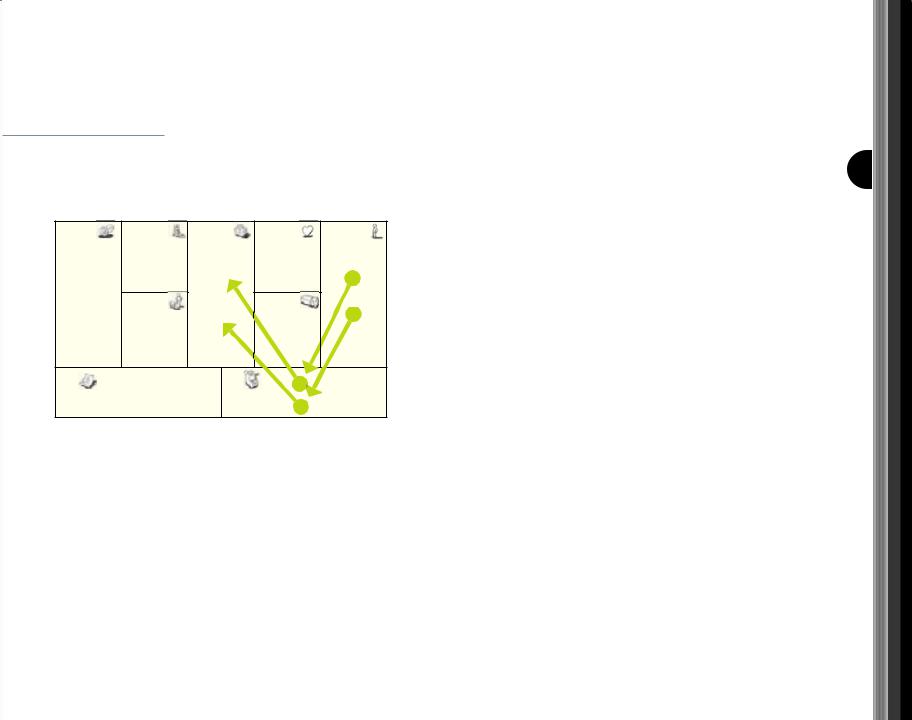
Same pattern, but diΩerent business model: Nintendo’s Wii
KP |
KA |
VP |
CR |
|
CS |
|
|
"family" |
|
su |
|
|
|
console |
|
||
|
|
access |
o |
|
gamers |
|
KR |
|
game |
||
|
console |
|
|||
|
|
users |
|
|
developers |
|
|
cheap |
|
|
|
|
|
develop |
|
|
|
|
|
ment |
t |
|
|
C$ |
|
R$ |
d |
fit b |
|
|
|
|
a |
e s |
|
|
|
|
royalties |
||
Wii Focus
Nintendo’s Wii changed all this. Like its competitors, the Wii is based on a double-sided platform business, but with substantially diΩerent elements. Nintendo aimed its consoles at the huge audience of casual gamers rather than the smaller “traditional” market of avid gamers. It won the hearts
of casual gamers with relatively inexpensive machines equipped with a special remote control device that allows players to control the action with physical gestures. The novelty and fun of motion-controlled games such as Wii Sports, Wii Music, and Wii Fit attracted enormous numbers of casual gamers. This diΩerentiator is also the basis for the new type of double-sided platform that Nintendo created.
Sony and Microsoft competed with costly, proprietary, state-of-the-art technology aimed at avid gamers and subsidized it in order to gain market share and keep hardware prices aΩordable. Nintendo, on the other hand, focused on a market segment that was far less sensitive to technological performance. Instead, it lured customers with its motion-controlled
“fun factor.” This was a much cheaper technological innovation compared to new, more powerful chipsets. Thus, the Nintendo Wii was less costly to produce, allowing the company to forego commercialization subsidies. This is the main diΩerence between Nintendo and rivals Sony and Microsoft: Nintendo earns money from both sides of its double-sided
Wii platform. It generates profits on each console sold to consumers and pockets royalties from game developers.
To summarize, three interlinked business model factors explain the commercial success of the Wii: (1) low-cost diΩerentiation of the product (motion control), (2) focus on a new, untapped market that cares less about technology (casual gamers), and (3) a double-sided platform pattern that generates revenues from both “sides” of the Wii. All three represent clean breaks from past game sector traditions.
Multi-sided platforMs
83
patterns

Multi-sided platforMs
84
patterns
Apple’s Evolution into a Platform Operator
The evolution of Apple’s product line from the iPod to the iPhone highlights the company’s transition to a powerful platform business model pattern. The iPod was initially a stand-alone device. The iPhone, on the contrary, evolved into a powerful multi-sided platform for which Apple controls third party applications through its App Store.
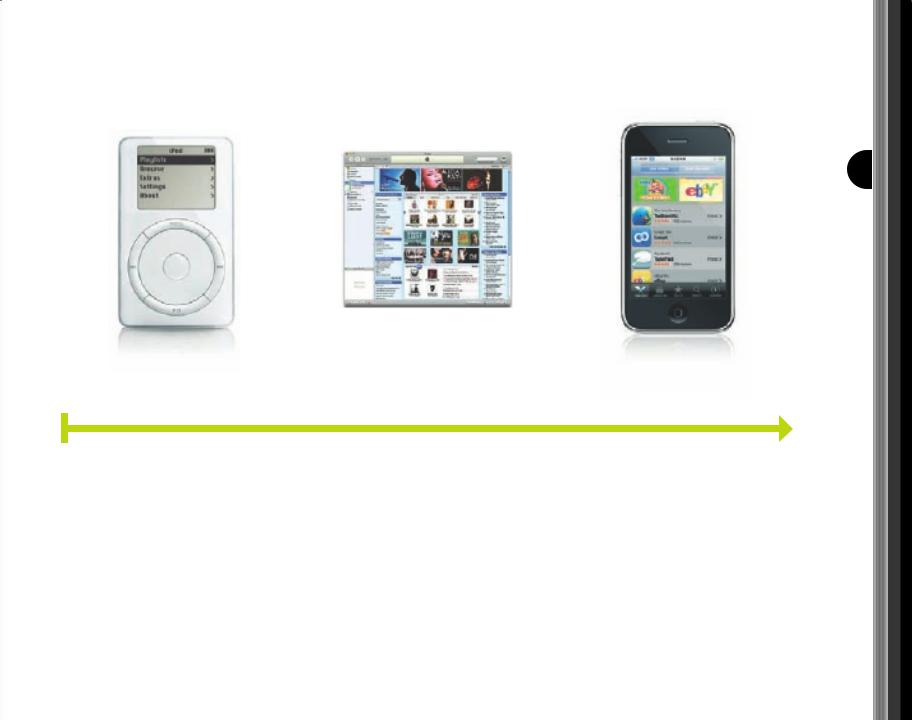
Multi-sided platforMs
85
patterns
|
|
Switch to multi-sided |
|
|
Consolidation of |
|
|
ipod |
platform business model |
ipod & iTunes |
platform business model |
iphone & appstore |
|||
|
|
|
|
|
|
|
|
|
|
|
|
|
|
|
|
2001 |
|
2003 |
|
2008 |
|||
Apple introduced the iPod in 2001 as a standalone product. Users could copy their CDs and download music from the Internet onto the device. The iPod represented a technology platform for storing music from various sources. At this point, though, Apple was not exploiting the platform aspect of the iPod in its business model.
In 2003 Apple introduced the iTunes Music Store, which was closely integrated with the iPod. The store allowed users to buy and download digital music in an extremely convenient way. The store was Apple’s first attempt at exploiting platform effects. iTunes essentially connected “music rightsholders” directly with buyers. This strategy catapulted Apple to its position today as the world’s largest online music retailer.
In 2008 Apple consolidated its platform strategy by launching its App Store for the highly popular iPhone. The App Store allows users to browse, buy, and download applications directly from the iTunes Store and install them on their iPhones. Application developers must channel sales of all applications through the App Store, with Apple collecting a 30 percent royalty on each application sold.

patterns
Sided
Platform
Pattern
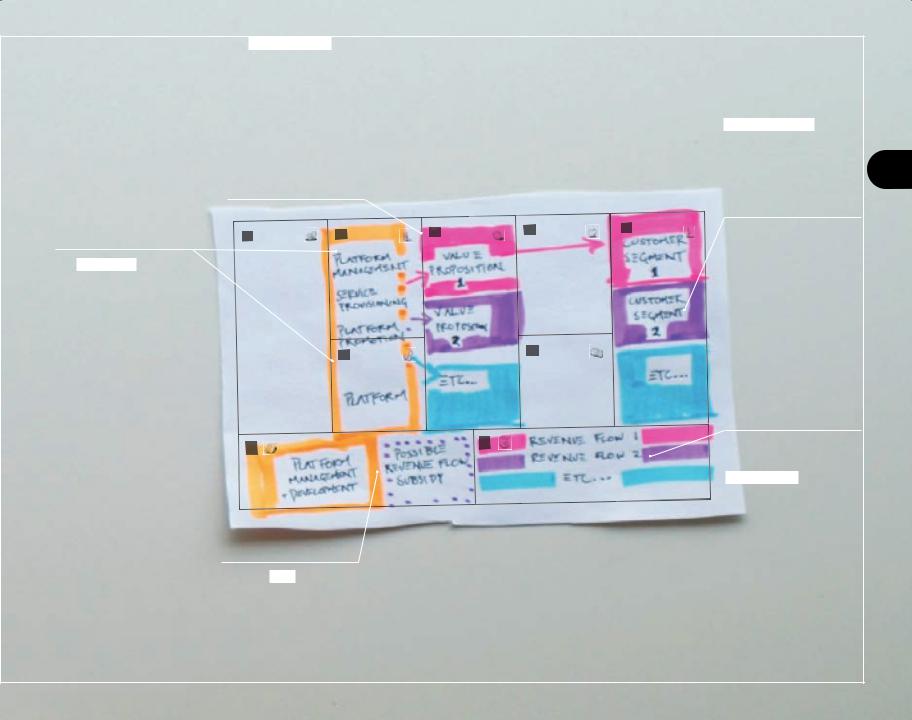
The key resource required for this business model pattern is the platform. The three Key Activities are usually platform management, service provisioning, and platform promotion.
The main costs incurred under this pattern relate to maintaining and developing the platform.
patterns
Each Customer Segment produces a diΩerent revenue stream. One or more segments may enjoy free oΩers or reduced prices subsidized by revenues from other Customer Segments. Choosing which segment to subsidize can be a crucial pricing decision that determines the success
of a multi-sided platform business model.

FREEas a
Business
Model

Def_Pattern No. 4
free • In the free business model at least one substantial Customer Segment is able to continuously benefit from a free-of-charge offer. • DiΩerent patterns make the free offer
possible. • Non-paying customers are financed by another part of the business model or by another Customer Segment.
[ REF·ER·ENCES ]
1 • “Free! Why $0.00 is the Future of Business.”
Wired Magazine.
Anderson, Chris.
February 2008.
2 • “How about Free? The Price Point That Is Turning Industries on Their Heads.” Knowledge@ Wharton. March 2009.
3 • Free: The Future of a
Radical Price. Anderson, Chris. 2008.
[ EX·AM·PLES ]
Metro (free paper), Flickr, Open Source, Skype, Google, Free Mobile Phones
free as a business Model
89
patterns

Free as a business Model
90
paTTerns
Receiving something free of charge has always
been an attractive Value Proposition. Any marketer or
economist will confirm that the demand generated at a price of zero
is many times higher than the demand generated at one cent or any other price
point. In recent years free offers have exploded, particularly over the Internet. The ques-
tion, of course, is how can you systematically offer something for free and still earn substantial
revenues? Part of the answer is that the cost of producing certain giveaways, such as online data storage
capacity, has fallen dramatically. Yet to make a profit, an organization offering free products or services must still generate revenues somehow.
There are several patterns that make integrating free products and services into a business model possible. Some of the traditional FREE patterns are well known, such as advertising, which is based on the previously discussed pattern of multi-sided platforms (see p. 76). Others, such as the so-called freemium model, which provides basic services free of charge and premium services for a fee, have become popular in step with the increasing digitization of goods and services offered via the Web.
Chris Anderson, whose Long Tail concept we discussed previously (see p. 66), has helped the concept of FREE gain widespread recognition. Anderson shows that the rise of new free-of-charge offers is closely related to the fundamentally different economics of digital products and services. For example, creating and recording a song costs an artist time and money, but the cost of digitally replicating and distributing the work over the Internet is close to zero. Hence, an artist can promote and deliver music to a global audience over the Web, as long as he or she finds other Revenue Streams, such as concerts and merchandis-
ing, to cover costs. Bands and artists who have experimented successfully with free music include Radiohead and Trent Reznor of Nine Inch Nails.
In this section we look at three different patterns that make FREE a viable business model option. Each has different underlying economics, but all share a common trait: at least one Customer Segment continuously benefits from the free-of-charge offer. The three patterns are (1) free offer based
on multi-sided platforms (advertising-based), (2) free basic services with optional premium services (the so-called “freemium” model), (3) and the “bait &
hook” model whereby a free or inexpensive initial offer lures customers into repeat purchases.

Free as a business Model
91
paTTerns
(How) can you set it free?
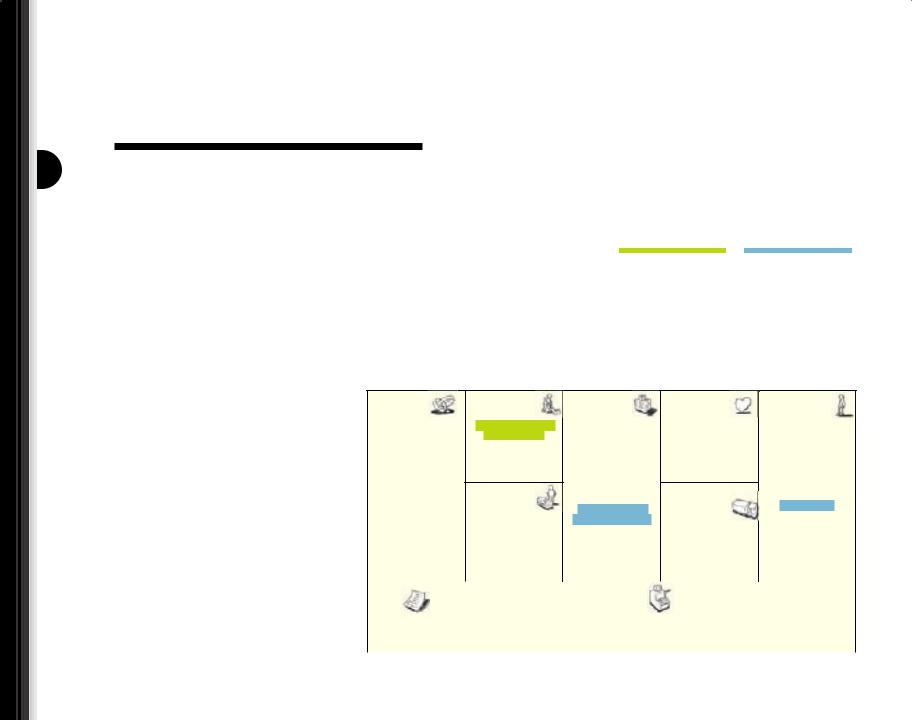
free as a business Model
92
patterns
Advertising: A Multi-Sided
Platform Model
Advertising is a well-established revenue source that enables free offers. We recognize it on television, radio, the Web, and in one of its most sophisticated forms, in targeted Google ads.
In business model terms, FREE based on advertising is a particular form of the multi-sided platform pattern (see p. 76). One side of the platform is designed to attract users with free content, products, or services. Another side of the platform generates revenue by selling space to advertisers.
One striking example of this pattern is Metro, the free newspaper that started in Stockholm and is now available in dozens of cities around the world. The genius of Metro lies in how it modified the traditional daily newspaper model. First, it offered the paper for free. Second, it focused on distributing in high-traffic commuter zones and public transport networks by hand and with self-service racks. This required Metro to develop its own distribution network, but enabled the company to quickly achieve broad circulation. Third, it cut editorial costs to produce a paper just good enough to entertain younger commuters during their short rides
to and from work. Competitors using the same model soon followed, but Metro kept them at bay with a couple of smart moves. For example, it controlled many of the news racks at train and bus stations, forcing rivals to resort to costly hand distribution in important areas.
Minimizes costs by cutting editorial team to produce a daily paper just “good enough” for a commute read
Assures high circulation through free offer and by focusing on distributing in high-traffic commuter zones and public transport networks
Metro |
|
|
|
|
KP |
KA |
VP |
CR |
CS |
|
write & produce |
|
acquisition |
|
|
a daily paper |
|
|
|
|
|
|
|
|
|
distribution |
ad space in high |
retention |
|
|
|
|
||
|
|
|
|
|
distribution |
|
circulation |
|
advertisers |
|
free paper |
|
||
agreements with |
|
|
|
|
public transport |
KR |
|
|
|
networks |
free city-wide |
CH |
commuters |
|
|
||||
|
brand |
commuter paper |
|
|
|
|
|
ad sales force |
|
|
|
distribution net- |
|
|
|
|
|
|
|
|
|
||
|
|
public transport, |
|
|
|||||||||
|
|
work & logistics |
|
|
|
||||||||
|
|
|
|
train stations, |
|
|
|
||||||
|
|
|
|
|
|
|
|
bus stops |
|
|
|
||
|
|
|
|
|
|
|
|
|
|
|
|
|
|
C$ |
|
|
|
|
R$ |
|
|
|
|
|
|||
content, design & print |
|
|
|
|
|
||||||||
|
|
|
free newspaper |
||||||||||
|
of a daily paper |
|
|
|
|
|
|||||||
|
|
|
|
|
fees for ad space in paper |
||||||||
|
|
distribution |
|
||||||||||
|
|
|
|
|
|
|
|
|
|
|
|||
|
|
|
|
|
|
|
|
|
|
|
|
|
|

|
|
|
|
|
|
|
|
|
Newspapers: |
|
|
||
|
|
|
|
|
|
|
|
|
|
|
|||
|
Mass automatic ad $ |
|
|
|
|
|
|||||||
|
A large number of users does not automati- |
|
|
Free or Not Free? |
|||||||||
|
cally translate into an El Dorado of advertising |
|
|
||||||||||
|
revenues, as the social networking service |
|
|
|
|
|
|
|
|||||
|
|
|
|
|
|
|
|||||||
|
Facebook has demonstrated. The company |
|
|
|
|
|
|
||||||
|
claimed over 200 million active users as of May |
|
|
|
|
|
|
||||||
|
2009, and said more than 100 million log on |
|
|
|
|
|
|
||||||
|
to its site daily. Those figures make Facebook |
|
|
One industry crumbling under the impact of |
for articles when readers can view similar con- |
||||||||
|
the world’s largest social network. Yet users are |
|
|
FREE is newspaper publishing. Sandwiched |
tent for free on Web sites such as CNN.com or |
||||||||
|
less responsive to Facebook advertising than |
|
|
||||||||||
|
|
|
between freely available Internet content and |
MSNBC.com. Few newspapers have succeeded |
|||||||||
|
to traditional Web ads, according to industry |
|
|
||||||||||
|
|
|
free newspapers, several traditional papers |
in motivating readers to pay for access to pre- |
|||||||||
|
experts. While advertising is only one of several |
|
|
||||||||||
|
|
|
|
|
|
|
|||||||
|
potential Revenue Streams for Facebook, clearly |
|
|
have already filed for bankruptcy. The U.S. news |
mium content online. |
||||||||
|
a mass of users does not guarantee huge adver- |
|
|
industry reached a tipping point in 2008 when |
On the print side, traditional newspapers |
||||||||
|
tising revenues. At this writing, privately held |
|
|
the number of people obtaining news online for |
are under attack from free publications such |
||||||||
|
Facebook did not disclose revenue data. |
|
|
|
free outstripped those paying for newspapers |
as Metro. Though Metro offers a completely |
|||||||
|
|
|
|
|
|
|
|
|
|
||||
|
|
|
|
|
|
|
or news magazines, according to a study by the |
different format and journalistic quality and |
|||||
|
|
|
|
|
|
|
|
Pew Research Center. |
focuses primarily on young readers who previ- |
||||
|
|
|
|
|
|
|
|
|
|
|
Traditionally, newspapers and |
ously ignored newspapers, it is ratcheting up |
|
|
|
|
|
|
|
|
|
|
|
|
|||
|
|
|
|
|
|
|
|
|
|
|
magazines relied on revenues from three |
the pressure on fee-for-service news providers. |
|
|
|
|
|
|
mass |
|
|
|
|
|
sources: newsstand sales, subscription fees, |
Charging money for news is an increasingly |
|
|
|
|
|
|
customized |
|
|
|
|
|
and advertising. The first two are rapidly |
difficult proposition. |
|
|
|
ad space on |
|
|
|
|
|
|
|
||||
|
|
|
|
|
advertisers |
|
|
declining and the third is not increasing |
Some news entrepreneurs are experiment- |
||||
|
|
high traffic |
|
|
|
|
|
||||||
|
|
social network |
|
|
global web |
|
quickly enough. Though many newspapers |
ing with novel formats focused on the online |
|||||
|
|
|
|
|
|||||||||
|
|
free social |
|
|
|
|
|||||||
|
|
|
|
|
audience |
|
have increased online readership, they’ve |
space. For example, news provider True/Slant |
|||||
|
|
network |
|
ad sales force |
|
|
|
|
|
||||
|
|
|
|
|
|
|
|
|
|
|
|
|
|
|
|
|
|
|
|
|
|
|
|
|
failed to achieve correspondingly greater |
(trueslant.com) aggregates on one site the |
|
|
|
|
|
|
facebook.com |
|
|
|
|
|
advertising revenues. Meanwhile, the high |
work of over 60 journalists, each an expert in a |
|
|
|
|
|
|
|
|
|
|
|
|
fixed costs that guarantee good journal- |
specific field. The writers are paid a share of the |
|
|
|
|
|
|
|
|
|
|
|
|
ism—news gathering and editorial teams— |
advertising and sponsorship revenues gener- |
|
|
|
|
|
|
|
|
|
|
|
|
|||
|
|
|
|
|
free accounts |
|
|
|
|
remained unchanged. |
ated by True/Slant. For a fee, advertisers can |
||
|
|
|
|
|
|
|
|
|
|
|
|
||
|
|
|
|
fees for ad space on facebook |
|
Several newspapers have experi- |
publish their own material in pages paralleling |
||||||
|
|
|
|
|
|
|
|
|
|
|
mented with paid online subscriptions, |
the news content. |
|
|
|
|
|
|
|
|
|
|
|
|
with mixed results. It is difficult to charge |
|
|
|
|
|
|
|
|
|
|
|
|
|
|
|
|
|
|
|
|
|
|
|
|
|
|
|
|
|
|
free as a business Model
93
patterns

free as a business Model
94
patterns
Free Advertising:
Patternof
Multi-Sided
Platforms
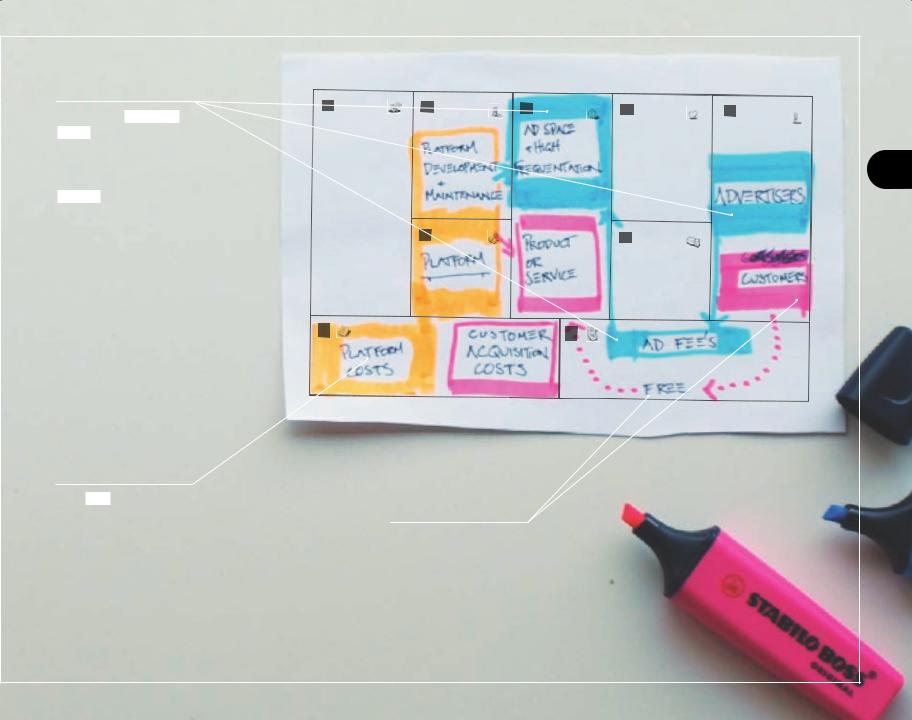
With the right product or service and high traffic, the platform becomes interesting to advertisers, which in turn allows charging fees to subsidize free products and services.
Main costs relate to developing and maintaining the platform; trafficgeneration and retention costs may also arise.
Free products or services generate high platform traffic and increase attractiveness to advertisers.
free as a business Model
95
patterns
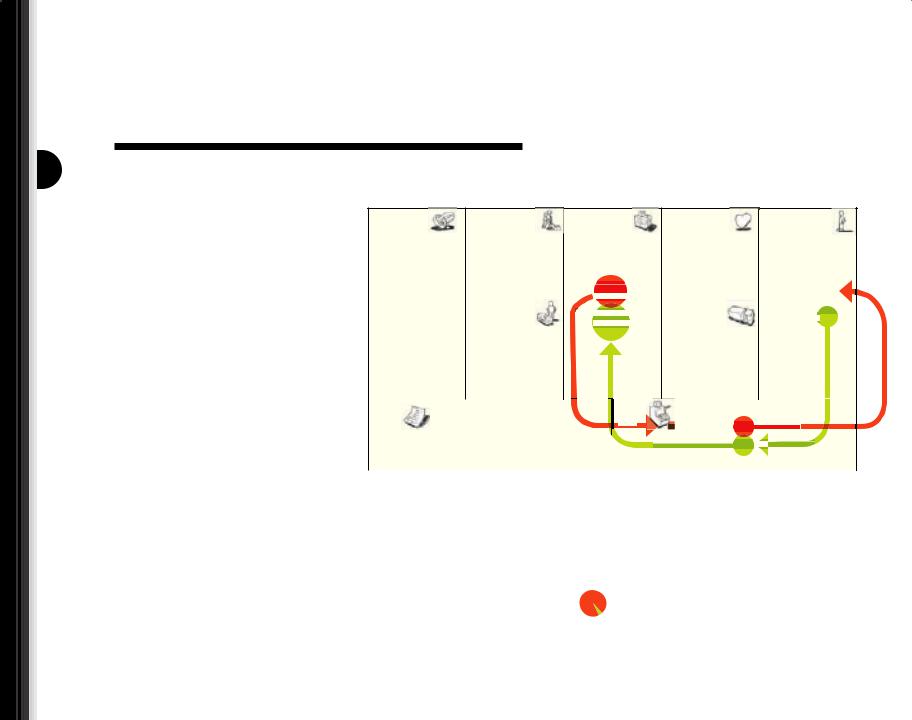
free as a business Model
96
patterns
Freemium: Get the Basics for Free, Pay for More
Flickr
The term “freemium” was coined by Jarid Lukin and popularized by venture capitalist Fred Wilson on his blog. It stands for business models, mainly Web-based, that blend free basic services with paid premium services. The freemium model is characterized by a large user base benefiting from a free, no-strings-attached offer. Most of these users never become paying customers; only a small portion, usually less than 10 percent of all users, subscribe to the paid premium services. This small base of paying users subsidizes the free users. This is possible because of the low marginal cost of serving additional free users. In a freemium model, the key metrics to watch are (1) the average cost of serving a free user, and (2) the rates at which free users convert to premium (paying) customers.
Flickr, the popular photo-sharing Web site acquired by Yahoo! in 2005, provides a good example of a freemium business model. Flickr users can subscribe for free to a basic account that enables them to upload and share images. The free service has certain constraints, such as limited storage space and a maximum number of uploads per month. For a small annual fee users
KP |
KA |
VP |
CR |
CS |
|
|
|
platform |
|
|
|
|
|
|
|
|
|
mass customized |
|||||||||||||||||
|
|
|
management |
|
|
|
|
|
|
|
|
|
switching costs |
|||||||||||||||||
|
|
|
|
|
|
|
|
|
|
|
|
|
|
|
|
|
||||||||||||||
|
|
|
|
|
|
|
|
|
|
|
|
|
|
|
|
|
|
|
|
|
|
|
|
|
|
|
|
|
|
|
|
|
|
|
|
|
free |
basic |
photo |
|
|
|
|
|
|
|
|
|
|
|
|
|
|
|
|
||||||
|
|
|
|
|
|
|
|
|
|
|
|
|
|
casual users |
|
|
|
|||||||||||||
yahoo! |
|
|
|
|
|
|
|
harin |
|
|
|
|
|
|
|
|
|
|
|
|
|
|
||||||||
|
|
|
|
|
|
|
|
|
|
|
|
|
|
|
|
|
|
|
|
|
|
|
|
|
|
|||||
|
|
KR |
|
|
|
|
|
|
|
|
|
CH |
|
|
|
|
|
|
|
|
|
|
|
|
|
|||||
|
|
|
|
|
|
|
|
|
|
|
|
|
|
|
|
high-vol |
ume |
|
|
|||||||||||
|
|
|
|
sharin |
|
|
|
|
|
|
|
|
|
users |
|
|
|
|||||||||||||
|
|
|
|
|
|
|
|
ium p |
|
|
|
|
|
|
|
|
|
|
|
|
|
|
|
|
|
|
||||
|
|
|
|
|
|
|
|
|
|
|
|
|
|
|
|
|
|
|
|
|
|
|
|
|
|
|
|
|
|
|
|
|
|
flickr platform |
|
|
|
|
|
|
|
|
|
flickr.com |
|||||||||||||||||
|
|
|
brand |
|
|
|
|
|
|
|
|
|
yahoo.com |
|||||||||||||||||
|
|
|
|
|
|
|
|
|
|
|
|
|
|
|
|
|
|
|
|
|
|
|
|
|
|
|
|
|
|
|
C$ |
|
|
|
|
|
|
|
|
|
|
|
|
|
|
|
|
|
|
|
|
|
|
|
|
|
|
|
|
|
|
|
platform development |
|
|
|
|
|
|
|
|
|
free limited |
|
asic |
accounts |
|
|
|
|
|
|
||||||||||
|
|
|
|
|
|
|
|
|
|
|
|
|
|
|
|
|
|
|
|
|
|
|||||||||
|
|
storage costs |
|
|
|
|
|
|
|
|
|
|
|
|
|
subscript |
ion |
r account |
|
|
|
|
|
|||||||
|
|
|
|
|
|
|
|
|
|
|
|
|
|
|
|
|
|
|
|
|
|
|
|
|
|
|
|
|
|
|
can purchase a “pro” account and enjoy unlim- |
|
|
|
|
|
|
|
|
|
|
|
|
|
|
|
|
|
|
|
|||||||||||
|
|
|
|
|
|
|
|
|
|
|
|
|
|
|
|
|
|
|
||||||||||||
ited uploads and storage space, plus additional |
|
|
|
Fixed and sunk costs |
|
|
Variable cost |
|||||||||||||||||||||||
features. |
|
|
|
|
|
|
|
|
|
|
related to platform |
|
|
depending on number |
||||||||||||||||
|
|
|
|
|
|
|
|
|
|
|
development |
|
|
of photos stored |
||||||||||||||||
|
|
|
|
|
|
|
|
|
|
|
|
|
|
|
|
|
|
|
|
|
|
|||||||||
|
|
|
|
|
|
|
|
|
|
|
|
|
|
|
|
|
|
|
|
|
|
|
|
|
|
|
|
|
|
|
|
|
|
|
|
|
|
|
|
|
|
Large base of basic |
|
|
Small base of paying |
||||||||||||||||
|
|
|
|
|
|
|
|
|
|
|
accounts for casual users |
|
|
“pro” users |
||||||||||||||||
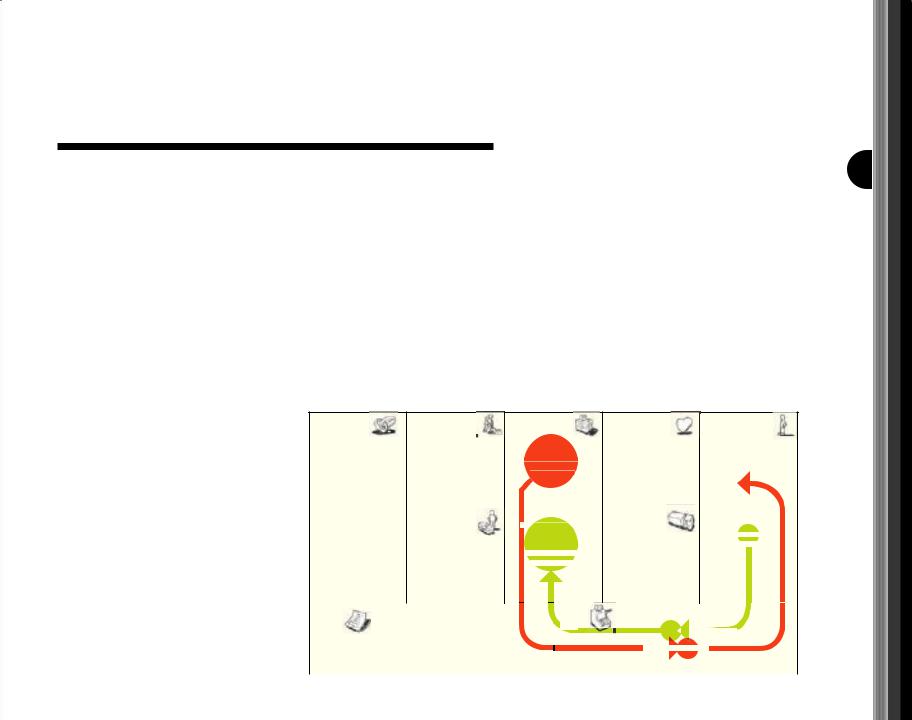
Open Source: Freemium with a Twist
Business models in the enterprise software industry are usually characterized by two traits: First, the high fixed cost of supporting an army of expert software developers who build the product; Second, a revenue model based on selling multiple per-user licenses and regular upgrades of the software.
Red Hat, a U.S. software company, turned this model upside down. Rather than creating software from scratch, it builds its product on top of so-called open source software developed voluntarily by thousands of software engineers around the world. Red Hat understood that companies were interested in robust, licensing fee-free open source software, but were reluctant to adopt it due to concerns that no single entity was legally responsible for providing and maintaining it. Red Hat filled this gap by offering stable, tested, service-ready versions of freely available open source software, particularly Linux.
Each Red Hat release is supported for seven years. Customers benefit from this approach because it allows them to enjoy the cost and stability advantages of open source software,
while protecting them from the uncertainties surrounding a product not officially “owned” by anyone. Red Hat benefits because its software kernel is continuously improved by the open source community free of charge. This substantially reduces Red Hat’s development costs.
Naturally, Red Hat also has to earn money. So rather than charging clients for each major
new release—the traditional software revenue model—it sells subscriptions. For an annual fee, each client enjoys continuous access to the latest Red Hat release, unlimited service support, and the security of interacting with the legal owner of the product. Companies are willing to pay for these benefits despite the free availability of many versions of Linux and other open source software.
Red Hat
KP |
KAsoftware |
VP |
CR |
CS |
|
support services |
free (linux) open |
self-service & |
|
|
software |
direct access to |
|
|
|
ource bas |
|
||
|
engineers |
self-service |
||
|
versioning & |
softwar |
||
|
testing |
|
|
users |
(linux) open |
|
|
|
|
|
|
|
|
|
|
|
|
|
|
|
|
|
|
|
|
|
|
|
source |
|
|
|
|
|
|
|
|
|
|
|
|
|
|
|
|
|
|
|
|
|
|
|
development |
KR |
|
|
|
|
|
|
|
|
|
|
|
|
|
|
|
|
|
|
|
|
|
|
community |
|
|
ntinuou |
|
|
|
|
|
|
|
|
|
|
|
|
|
|
|
|
||||
|
|
|
|
|
|
|
|
|
|
|
|
|
|
|
|||||||||
|
|
|
|
|
pgraded, |
|
|
|
|
|
.com |
|
|
|
|
|
|
|
|||||
|
|
|
|
|
|
|
|
|
|
|
|
|
|||||||||||
|
red hat (linux) |
|
|
serviced, |
|
|
|
|
|
|
|
|
|
|
|
||||||||
|
|
|
|
|
|
|
|
|
|
|
|||||||||||||
|
|
|
|
|
|
|
|
|
|
|
|
|
|
|
|
|
|
|
|
|
|
||
|
software |
|
|
uarantee |
|
|
|
hat global |
|
|
|
|
|
|
|
||||||||
|
|
|
|
|
|
|
|
|
|
|
|
|
|
|
|
|
|||||||
|
|
|
softwar |
|
|
|
|
|
|
|
|
|
|
|
|||||||||
|
|
|
|
|
|
|
|
branches |
|
|
|
|
|
|
|
||||||||
|
|
|
|
|
|
|
|
|
|
|
|
|
|
|
|
|
|
|
|||||
|
|
|
|
|
|
|
|
|
|
|
|
|
|
|
|
|
|
|
|
|
|
|
|
C$ |
|
|
|
|
|
|
|
|
|
p |
|
|
nal |
u |
|
|
|
|
|
|
|
|
|
|
|
|
|
|
|
|
|
|
|
|
|
|
|
|
|
|
|
|
|||||
cost structure contains |
|
|
|
|
|
|
|
|
|
|
|
|
|
|
|
|
|
|
|
||||
|
|
|
|
|
|
|
|
|
|
|
|
|
|
|
|
|
|
|
|||||
elements of a service company |
|
|
|
|
|
|
|
|
|
|
|
|
|
|
|
|
|
|
|
|
|
||
|
|
|
|
|
|
|
|
|
|
free s |
o |
tw |
|
|
|
|
|
|
|
||||
|
|
|
|
|
|
|
|
|
|
|
|
|
|
|
|
|
|
|
|
|
|
|
|
free as a business Model
97
patterns
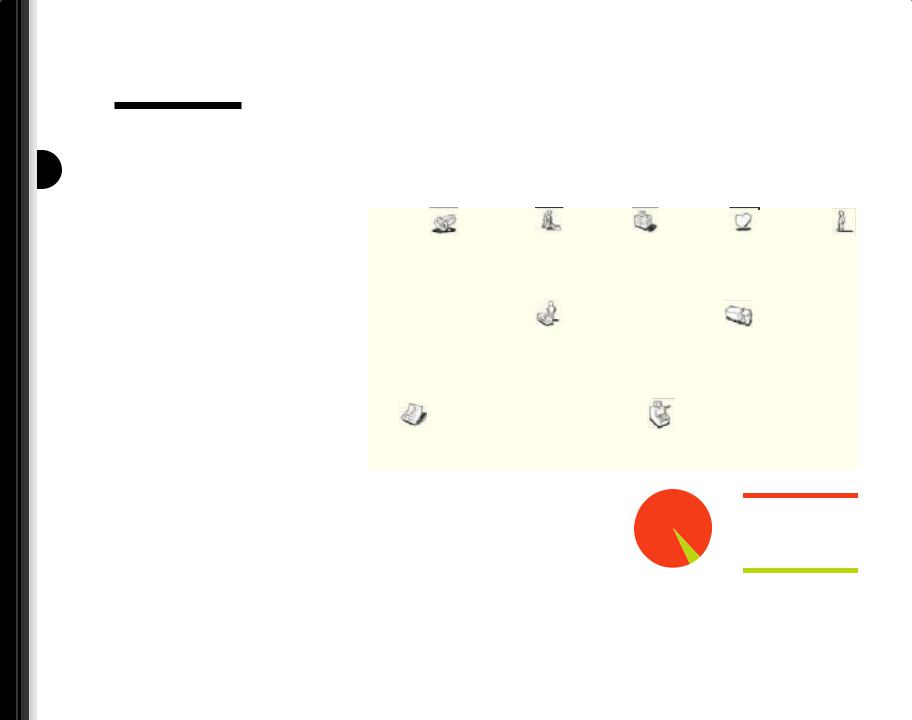
free as a business Model
98
patterns
Skype
Skype offers an intriguing example of a freemium pattern that disrupted the telecommunications sector by enabling free calling services via the Internet. Skype developed software by the same name that, when installed on computers or smartphones, enables users to make calls from one device to another free of charge. Skype can offer this because its Cost Structure is completely different from that of a telecom carrier. Free calls are fully routed through
the Internet based on so-called peer-to-peer technology that employs user hardware and the Internet as communications infrastructure. Hence, Skype does not have to manage its own network like a telco and incurs only minor costs to support additional users. Skype requires very little of its own infrastructure besides backend software and the servers hosting user accounts.
Users pay only for calling landlines and mobile phones through a premium service called SkypeOut, which offers very low rates. In fact, users are charged only slightly more than the termination costs that Skype itself incurs for calls routed through wholesale carriers such as iBasis and Level 3, which handle the company’s network traffic.
Skype
KP |
|
KA |
VP |
|
|
CR |
CS |
|||||||||||||||||||
|
|
software |
|
|
|
|
|
|
|
|
|
|
|
mass customized |
|
|
|
|
|
|
|
|
|
|
||
|
|
development |
|
|
|
|
|
|
|
|
|
|
|
|
|
|
|
|
|
|
|
|
|
|
|
|
|
payment |
|
|
|
|
|
|
|
|
|
|
|
|
|
|
|
|
|
|
|
|
|
|
|
|
|
|
|
|
free internet & |
|
|
|
|
|
|
|
|
|
|
|
|
|
|
|
||||||||
providers |
|
|
|
|
|
|
|
|
|
|
web users |
|
|
|
||||||||||||
|
|
|
video calling |
|
|
|
|
|
|
|
|
|
|
|
|
|||||||||||
distribution |
|
|
|
|
|
|
|
|
|
|
|
|
|
globally |
|
|
|
|
||||||||
|
|
|
|
|
|
|
|
|
|
|
|
|
|
|
|
|
|
|
|
|
|
|||||
KR |
|
cheap calls to |
|
|
CH |
|
|
|
|
|
|
|
|
|
|
|||||||||||
|
partners |
|
|
|
|
people who want |
|
|||||||||||||||||||
|
|
|
|
|
phones |
|
|
|
|
|
|
|
||||||||||||||
|
|
|
|
|
|
|
|
|
|
|
|
|
to call phones |
|
|
|||||||||||
telco partners |
|
|
|
|
(skypeout) |
|
|
|
|
|
|
|
||||||||||||||
|
|
|
|
|
|
|
|
|||||||||||||||||||
|
|
|
|
|
|
|
|
|
|
|
|
|
|
|
|
|
|
|
|
|||||||
software |
|
|
|
|
|
|
|
|
|
|
|
skype.com |
|
|
|
|
|
|
|
|
|
|
||||
|
|
|
|
|
|
|
|
|
|
|
|
|
|
|
|
|
|
|
|
|
|
|
||||
|
|
developers |
|
|
|
|
|
|
|
|
|
|
|
headset |
|
|
|
|
|
|
|
|
|
|
||
|
|
software |
|
|
|
|
|
|
|
|
|
|
|
|
|
|
|
|
|
|
|
|
|
|||
|
|
|
|
|
|
|
|
|
|
|
|
|
partnerships |
|
|
|
|
|
|
|
|
|
|
|||
|
|
|
|
|
|
|
|
|
|
|
|
|
|
|
|
|
|
|
|
|
|
|
|
|
|
|
C$ |
|
|
|
|
|
|
|
R$ |
|
|
|
|
|
|
|
|
|
|
|
|
|
|
|
|||
software development |
|
|
|
|
|
|
|
free |
|
|
|
|
|
|
|
|
|
|
||||||||
|
|
|
|
|
|
|
|
|
|
|
|
|
|
|
|
|
|
|
|
|
|
|
|
|
||
|
complaint management |
|
|
|
|
|
|
|
|
|
|
skypeout pre-paid or subscription |
|
|||||||||||||
|
|
|
|
|
|
|
|
|
|
|
|
hardware sales |
||||||||||||||
|
|
|
|
|
|
|
|
|
|
|
|
|
|
|||||||||||||
|
|
|
|
|
|
|
|
|
|
|
|
|
|
|
|
|
|
|
|
|
|
|
|
|
|
|
Skype claims it has over 400 million registered users who have made more than 100 billion free calls since the company was founded in 2004. Skype reported revenues of U.S. $550 million in 2008, though the company and its owner, eBay, do not release detailed financial data including information on profitability. We may soon know more as eBay has announced plans to list Skype through an initial public offering (IPO).
Over 90 percent of Skype users subscribe to the free service
Paid SkypeOut calls account for less than
10 percent of total usage
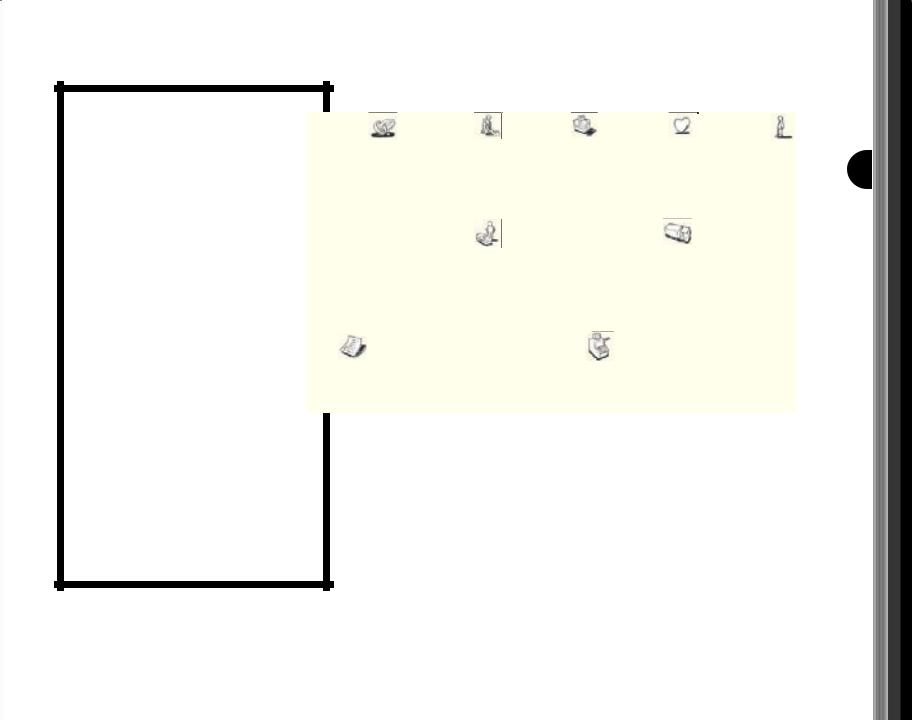
5+ years old
400 million+ users
100 billion+ free calls generated
2008 revenues of U.S. $550 million
Skype disrupted the telecommunications industry and helped drive voice communication costs close to zero. Telecom operators initially didn’t understand why Skype would offer calls for free and didn’t take the company seriously. What’s more, only a tiny fraction
of the traditional carriers’ customers used Skype. But over time more and more customers decided to make their international calls with Skype, eating into one of the most lucrative carrier revenue sources. This pattern, typical of a disruptive business model, severely affected the traditional voice communication business, and today Skype is the world’s largest provider of cross-border voice communication services, according to telecommunications research firm Telegeography.
Skype versus Telco
KP |
KA |
VP |
CR |
|
CS |
|
|
software devel- |
|
|
automated mass |
|
|
|
opment and no |
|
|
|
|
|
|
network mainte- |
|
|
customization |
|
|
|
nance |
|
|
|
|
|
|
|
|
|
|
|
global reach |
maximum |
|
roughly similar |
|
|
without the |
|
KR |
CH |
|
||||
outsourcing |
voice oΩer |
|
network |
|||
|
|
|
limitations of a |
|||
|
no |
|
|
software |
|
|
|
|
|
distribution 100% |
|
|
|
|
infrastructure |
|
|
low cost chan- |
|
|
|
|
|
|
nels |
|
|
|
|
|
|
|
|
|
C$ |
|
|
R$ |
90% free usage |
||
cost structure of a software company |
|
|||||
|
10% paying |
|
||||
|
|
|
|
|
||
|
|
|
|
|
|
|
|
|
|
Skype is a voice calling |
Giving away software |
|
services company operat- |
and allowing customers |
|
ing under the economics |
to make free Skype-to- |
|
of a software company |
Skype calls costs the |
|
|
company little |
|
|
|
|
free as a business Model
99
patterns
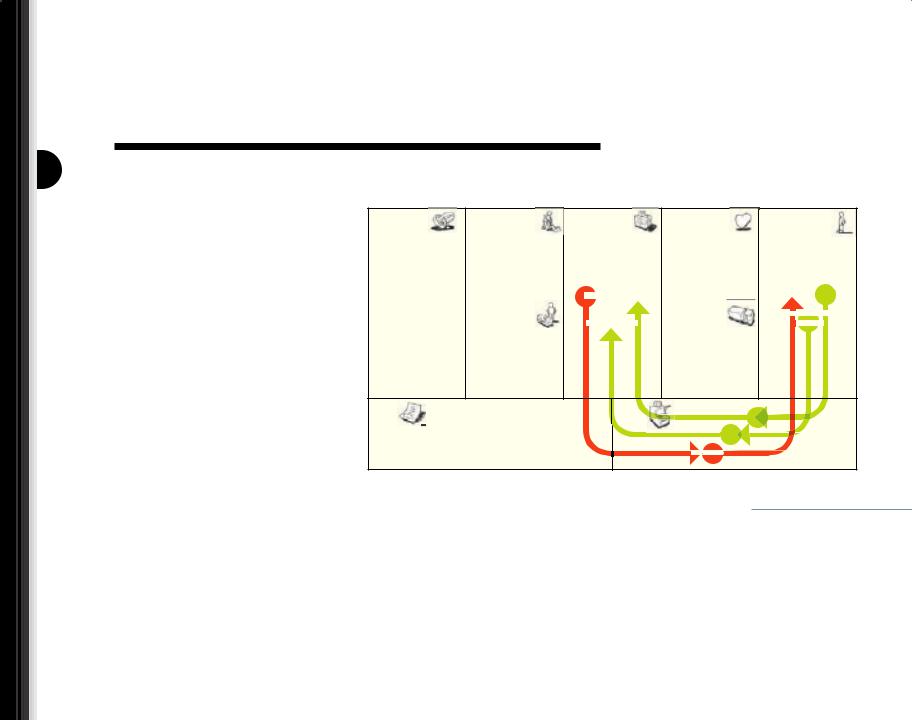
free as a business Model
100
patterns
The Insurance Model:
Freemium Upside Down
REGA
In the freemium model a small base of customers paying for a premium service subsidizes a large base of non-paying customers. The insurance model is actually the opposite—it’s the freemium model turned on its head. In the insurance model, a large base of customers pay small regular fees to protect themselves from unlikely— but financially devastating—events. In short, a large base of paying customers subsidizes a small group of people with actual claims—but any
one of the paying customers could at any time become part of the beneficiary group.
Let’s look at REGA as an example. REGA is a Swiss non-profit organization that uses helicopters and airplanes to transport medical staff to the scene of accidents, notably in the mountainous areas of Switzerland. Over two
million so-called “patrons” finance the organization. In return, patrons are exempt from paying any costs arising from being rescued by REGA. Mountain rescue operations can be extremely expensive, so REGA patrons find the service attractive in protecting them against the high cost of accidents during skiing vacations, summer hikes, or mountain drives.
KP |
KA |
VP |
CR |
CS |
|
rescue |
|
|
|
|
|
patron |
|||||||
|
operations |
|
|
|
|
|
membership |
|||||||
insurance |
|
|
|
rescue |
|
sponsor |
ing |
|||||||
companies |
|
|
|
surance" |
|
patro |
ns |
|
||||||
|
"in |
|
|
|||||||||||
sponsoring |
KR |
|
|
|
|
|
|
|
|
|
|
|
|
|
|
|
|
|
|
|
|
|
|
|
|
|
|
||
patrons |
|
|
|
|
|
|
|
v |
|
|
|
|
|
|
|
|
|
|
|
|
|
|
|
|
|||||
|
fleet of |
|
|
|
|
|
|
|
|
|
|
|
|
|
|
helicopters |
|
|
|
|
|
|
|
|
|
|
|
|
|
|
and planes |
|
|
|
|
|
|
|
|
|
|
|
|
|
C$ |
fleet of helicopters & planes |
|
|
companies |
|
|
rescuing |
|
|
e rescue operation |
|
|
|
Many paying users cover the costs of a few claims

“Every industry that becomes digital eventually becomes free.”
—— Chris Anderson
Editor-in-Chief, Wired Magazine
“We can no longer stand by and watch others walk oΩ with our work under misguided legal theories.”
—— Dean Singleton
Chairman, Associated Press
“The demand you get at a price of zero is many times higher than the demand you get at a very low price.”
—— Kartik Hosanagar
Assistant Professor, Wharton
“Google’s not a real company. It’s a house of cards.”
—— Steve Ballmer
CEO, Microsoft
free as a business Model
101
patterns
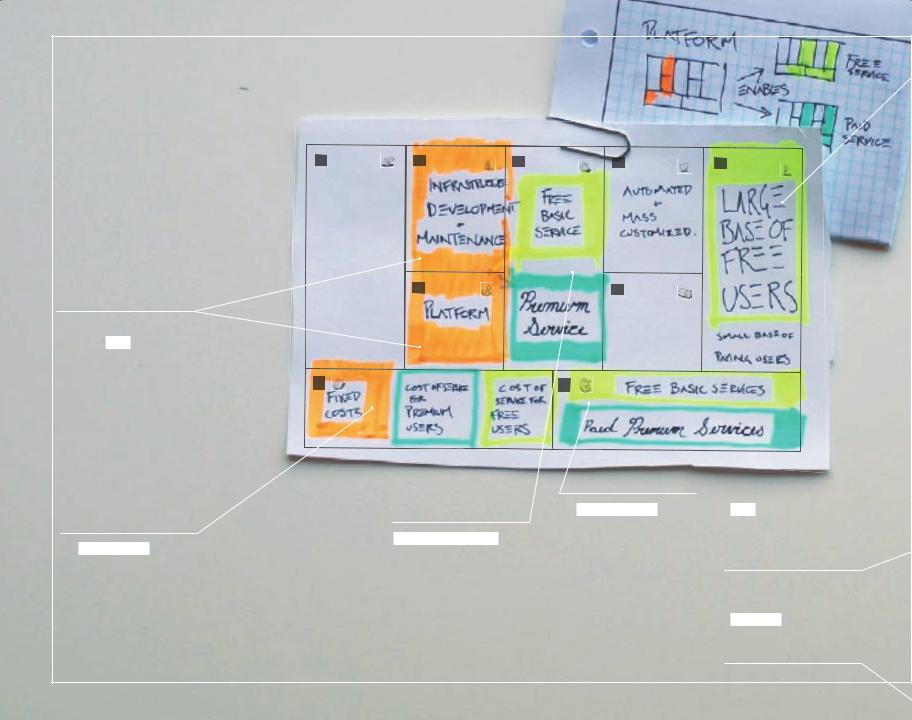
free as a business Model
102
patterns
Freemium
 Pattern
Pattern
The platform is the most important asset in the freemium pattern, because it allows free basic services to be offered at low marginal cost.
The cost structure of this pattern is tripartite: usually with substantial fixed costs, very low marginal costs for services to free accounts, and (separate) costs for premium accounts
customer relationship must be automated and low cost in order to handle large numbers of free users.
An important metric to |
users |
follow is the rate at which |
describes how many users |
free accounts convert to |
a company with a freemium |
premium accounts |
business model can attract |
|
fixed costs a company |
|
incurs to run its business |
|
model (e.g. systems costs) |

The freemium model is characterized by a large base of free service users subsidized by a small base of paying users.
Users enjoy a free basic service and can pay for a premium service that offers additional benefits.
percent of premium & free users specifies how many of all users are premium paying users or free users.
cost of service indicates the average cost
the company incurs to deliver a free or premium service to a free or premium user.
growth & churn rate specifies how many users defect/respectively join the user base.
customer acquisition costs total expenses a company incurs to acquire new users.
price of premium service indicates the average cost the company incurs to deliver a premium service to a premium paying user.
free as a business Model
103
patterns
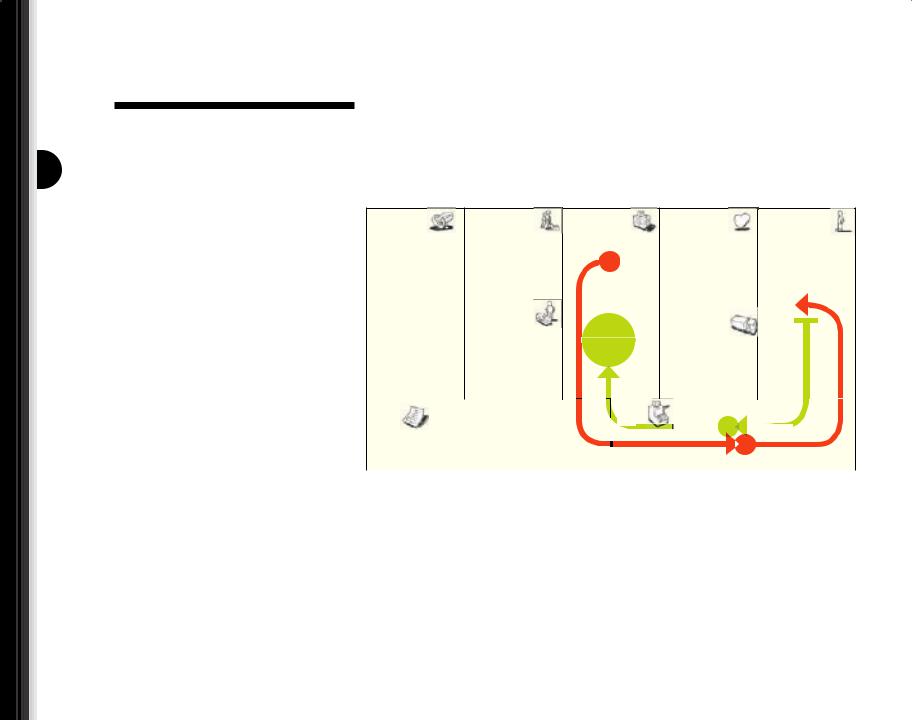
free as a business Model
104
patterns
Bait & Hook
“Bait & hook” refers to a business model pattern characterized by an attractive, inexpensive, or free initial offer that encourages continuing future purchases of related products or services. This pattern is also known as the “loss leader” or “razor & blades” model. “Loss leader” refers to a subsidized, even money-losing initial offer with the intention of generating profits from subsequent purchases. “Razor & blades” refers to a business model popularized by an American businessman, King C. Gillette, inventor of the disposable razor blade (see p. 105). We use the term bait & hook pattern to describe the general idea of luring customers with an initial offering, while earning from follow-up sales.
The mobile telecommunications industry provides a good illustration of the bait & hook pattern with a free offer. It is now standard practice for mobile network operators to offer free telephone handsets bundled with service subscriptions. Operators initially lose money by giving away mobile phones for free, but they easily cover the loss through subsequent monthly service fees. Operators provide instant gratification with a free offer that later generates recurring income.
Bait & Hook of Free Mobile Phones
KP |
KA |
VP |
CR |
CS |
|
services |
|
|
|
|
|
|
|
contractual |
||||||||
|
|
free |
ph |
ones |
|
lock-in |
|||||||||||
device |
|
|
|
||||||||||||||
|
|
|
|
|
|
|
|
|
|
|
|
|
|
cus |
tomers |
||
KR |
|
|
|
|
|
|
|
|
|
|
|
|
|
||||
manufacturers |
|
|
|
|
|
|
|
|
|
|
|
|
|
||||
|
ubscriptio |
|
|
|
|
|
|
|
|
|
|
|
|||||
|
network |
|
|
|
|
|
|
|
|
|
|
|
|
||||
|
|
|
|
|
|
|
|
|
|
|
|
||||||
|
|
|
|
|
|
|
|
|
|
|
|
|
|
|
|
|
|
|
|
|
|
|
|
|
|
|
|
|
|
|
|
|
|
|
|
C$ |
network |
|
|
|
|
|
|
|
|
ly |
su |
|
|
|
|
||
|
|
|
|
|
|
|
|
|
|
|
|
||||||
|
phones |
|
|
|
|
|
|
|
|
|
|
|
|
||||
|
|
|
|
|
|
|
|
|
1 x |
f |
|
e |
|
|
|
|
|
|
services |
|
|
|
|
|
|
|
|
|
|
|
|
|
|||
|
|
|
|
|
|
|
|
|
|
|
|
|
|
|
|
|
|
|
|
|
|
|
|
|
|
|
|
|
|
|
|
|
|
|
|
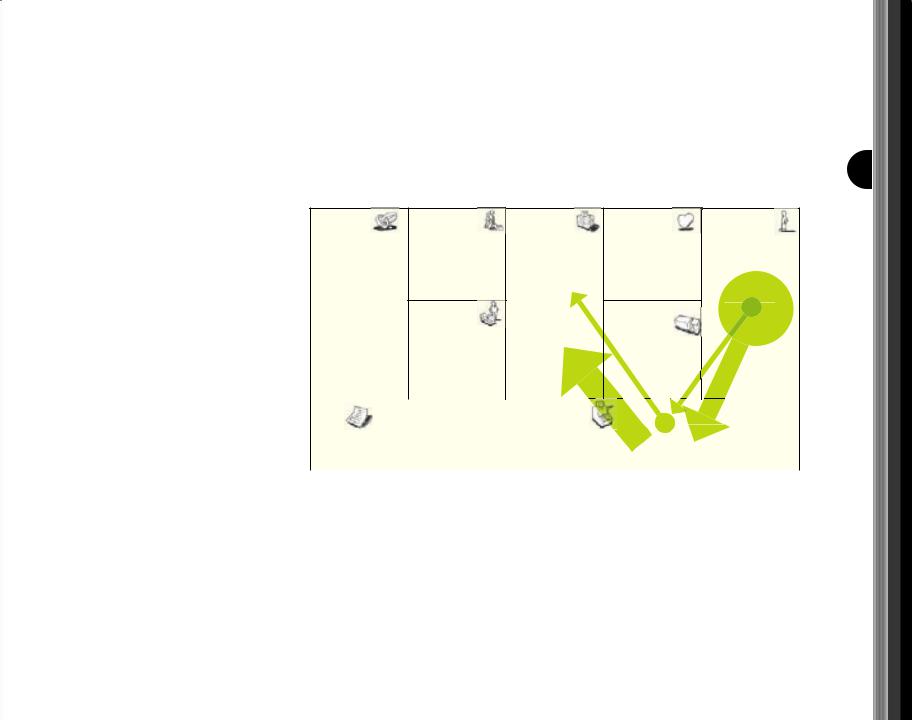
The form of the bait & hook pattern known as the razor and blades model derives from the way the first disposable razors were sold. In 1904 King C. Gillette, who commercialized the first disposable razor blade system, decided to sell razor handles at a steep discount or even give them away with other products in order to create demand for his disposable blades. Today Gillette is still the preeminent brand in shaving products. The key to this model is the close link between the inexpensive or free initial product and the follow-up item—usually disposable—on which the company earns a high margin. Controlling the “lock-in” is crucial to this pattern’s success. Through blocking patents, Gillette ensured that competitors couldn’t offer cheaper blades for the Gillette razor handles. In fact, today razors are among the world’s most heavily patented consumer products, with more than 1,000 patents covering everything from lubricating strips to cartridge-loading systems.
free as a business Model
105
Razor & Blades : Gillette |
|
|
|
patterns |
|
KP |
KA |
VP |
CR |
CS |
|
|
marketing |
|
|
|
|
|
r&d |
|
|
built-in |
|
|
|
|
"lock-in" |
|
|
|
|
razor handle |
|
|
|
|
logistics |
|
|
|
|
manufacturers |
KR |
|
|
|
om |
retailers |
|
|
|
||
|
|
|
|
||
|
|
|
|
|
|
|
brand |
blades |
|
|
|
|
patents |
|
|
|
|
C$ |
marketing |
R$ |
|
|
||
|
manufacturing |
|
1 x |
ndl |
rchas |
|
|
|
uen |
|
blade replacements |
||
|
logistics, r&d |
|
|
|||
|
|
|
|
|
|
|
|
|
|
|
|
|
|
This pattern is popular in the business world and has been applied in many sectors, including inkjet printers. Manufacturers such as HP, Epson, and Canon typically sell printers at very low prices, but they generate healthy margins on subsequent sales of ink cartridges.

patterns
106
free as a business Model
Hook
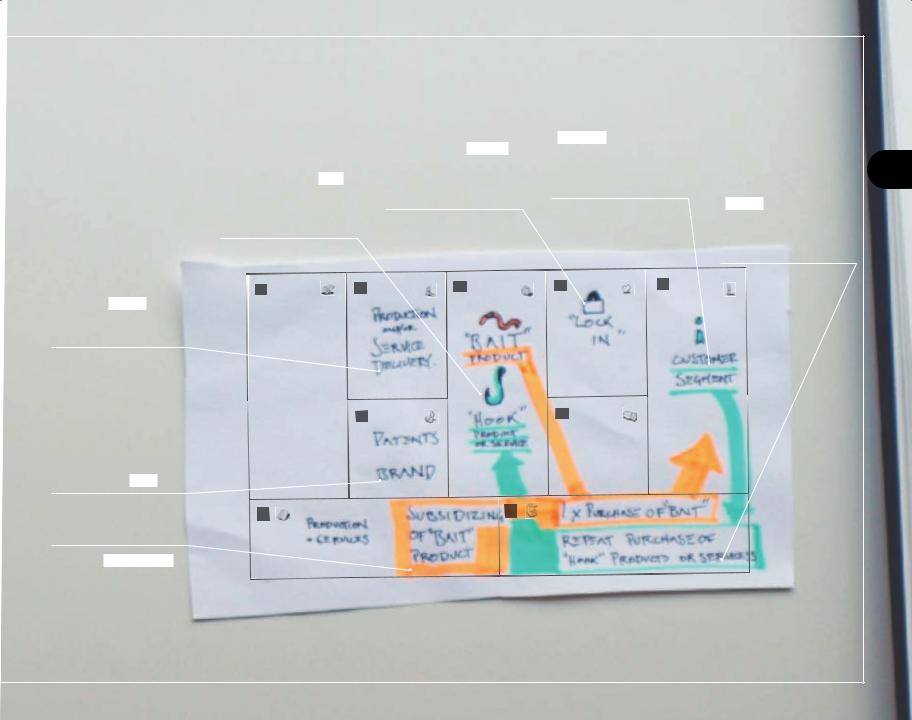
Cheap or free “bait” lures customers—and is closely linked to a (disposable) follow-up item or service.
Focuses on delivery of follow-up products or services.
Bait & hook patterns usually require a strong brand.
Important cost structure elements include subsidization of the initial product and the costs of producing follow-up products or services.
This pattern is characterized by a tight link or “lock-in” between the initial product and the follow-up products or services.
customers are attracted by the instant gratification of a cheap or free initial product or service.
The initial one-time purchase generates little or no revenue, but is made up for through repeat follow-up purchases of high-margin products or services.
free as a business Model
107
patterns

Open
Business
Models

Def_Pattern No. 5
open business models can be used by companies to create and capture value by systematically collaborating with outside partners. • This may happen from the “outside-in” by exploiting external ideas within the firm, or from the
“inside-out” by providing external parties with ideas or assets lying idle within the firm.
[ REF·ER·ENCES ]
1 • Open Business Models:
How to Thrive in the New Innovation Landscape.
Chesbrough, Henry. 2006.
2 • “The Era of Open Innovation.” MIT Sloan Management Review.
Chesbrough, Henry. Nº 3, 2003.
[ EX·AM·PLES ]
P&G, GlaxoSmithKilne,
Innocentive
open business Models
109
patterns
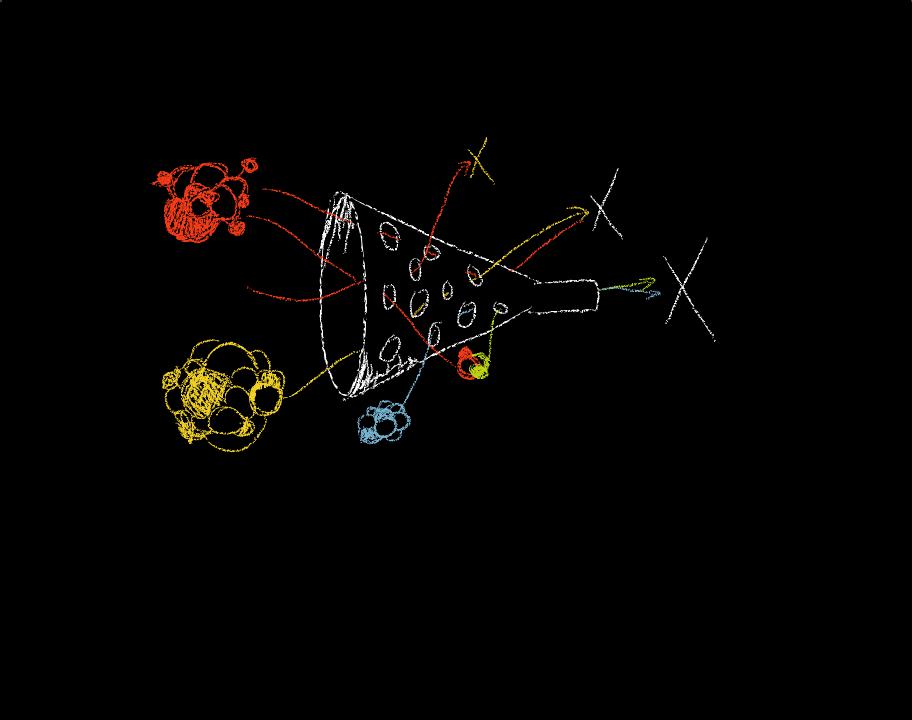
open business Models
110
paTTerns
Internal
Technology
Base
External
Technology
Base
Other fi rm's
 market
market
Our NEW
market
Our CURRENT
market
Open innovation and open business models are two terms coined by Henry Chesbrough. They refer to opening up a company’s research process to outside parties. Chesbrough argues that in a world characterized by distributed knowledge, organizations can create more value and better exploit their own research by integrating outside knowledge, intellectual property, and products into their innovation processes. In addition, Chesbrough
shows that products, technologies, knowledge, and intellectual property lying idle inside a company can be monetized by making them available to outside parties through licensing, joint ventures, or spin-oΩs. Chesbrough distinguishes between "outside-in" innovation and “inside-out” innovation. “Outside-in” innovation occurs when an organization brings external ideas, technology, or intellectual property into its development
and commercialization processes. The table opposite illustrates how companies increasingly rely on outside sources of technology to strengthen their business models. “Inside-out” innovation occurs when organizations license or sell their intellectual property or technologies, particularly unused assets. In this section we describe the business model patterns of firms that practice open innovation.

PRINCIPLES OF INNOVATION
Closed |
Open |
The smart people in our field work for us.
To profit from research and development  (R&D), we must discover it, develop it, and ship it ourselves.
(R&D), we must discover it, develop it, and ship it ourselves. 
If we conduct most of the best research in the industry, we will win.
If we create the most or the best ideas in the industry, we will win.
We should control our innovation process, so that competitors don't profit from our ideas.
We need to work with smart people both inside and outside our company.
External R&D can create significant value; internal R&D is needed to claim some portion of that value.
We don't have to originate the research to benefit from it.
If we make the best use of internal and external ideas, we will win.
We should profit from others' use of our innovations, and we should buy others' intellectual property (IP) whenever it advances our own interests.
open business Models
111
paTTerns
Source: Adapted from Chesbrough, 2003 and Wikipedia, 2009.
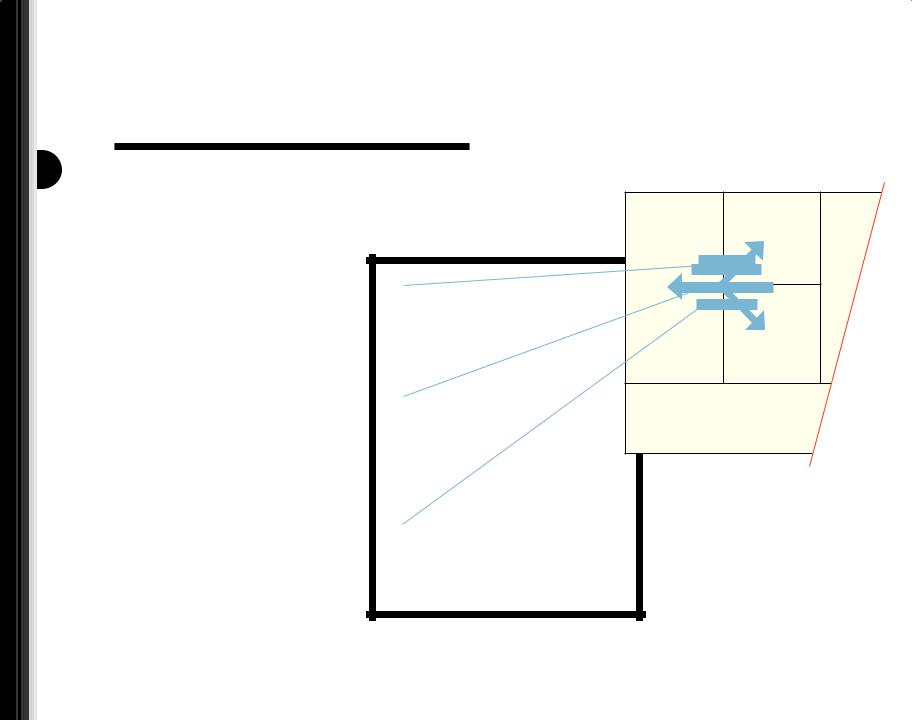
open business Models
112
patterns
Procter & Gamble:
Connect & Develop
In June of 2000, amid a continuing slide in Procter & Gamble’s share price, longtime P&G executive A.G. Lafley got the call to become the consumer product giant’s new CEO. To rejuvenate P&G, Lafley resolved to put innovation back at the company’s core. But instead of boosting R&D spending, he focused on structuring a
new innovation culture: one that moved from an internally focused R&D approach to an open R&D process. A key element was a “Connect & Develop” strategy aimed at exploiting internal research through outside partnerships. Lafley set an ambitious goal: create 50 percent of P&G’s
innovations with outside partners at a time when that figure was closer to 15 percent. The company surpassed that goal in 2007. Meanwhile, R&D productivity had soared 85 percent, even though R&D spending was only modestly higher compared to when Lafley took over as CEO.
In order to link its internal resources and R&D activities with the outside world, Procter & Gamble built three “bridges” into its business model: technology entrepreneurs, Internet platforms, and retirees.
|
Outside-In |
|
|
|
other |
internal r&d |
|
|
company's ip |
||
|
|
technology |
|
|
entrepreneurs |
||
1 Technology entrepreneurs are senior scien- |
internet platforms |
||
tists from P&G business units who systemati- |
your-encore |
||
cally develop relationships with researchers |
external |
|
|
at universities and other companies. They also |
scientists |
|
|
retired |
internal r&d |
||
act as “hunters” who scan the outside world |
|||
scientists |
|
||
|
|
||
for solutions to internal P&G challenges. |
|
|
|
2 Through Internet platforms, P&G connects |
|
|
|
with expert problem-solvers around the world. |
leveraging internal r&d |
||
Platforms such as InnoCentives (see p. 114) |
|||
|
|
||
allow P&G to expose some of its research prob- |
|
|
|
lems to non-P&G scientists around the globe. |
|
|
|
Respondents earn cash prizes for developing |
|
|
|
successful solutions. |
|
|
|
3 P&G solicits knowledge from retirees through YourEncore.com, a platform the company launched specifically to serve as an open innovation “bridge” to the outside world.
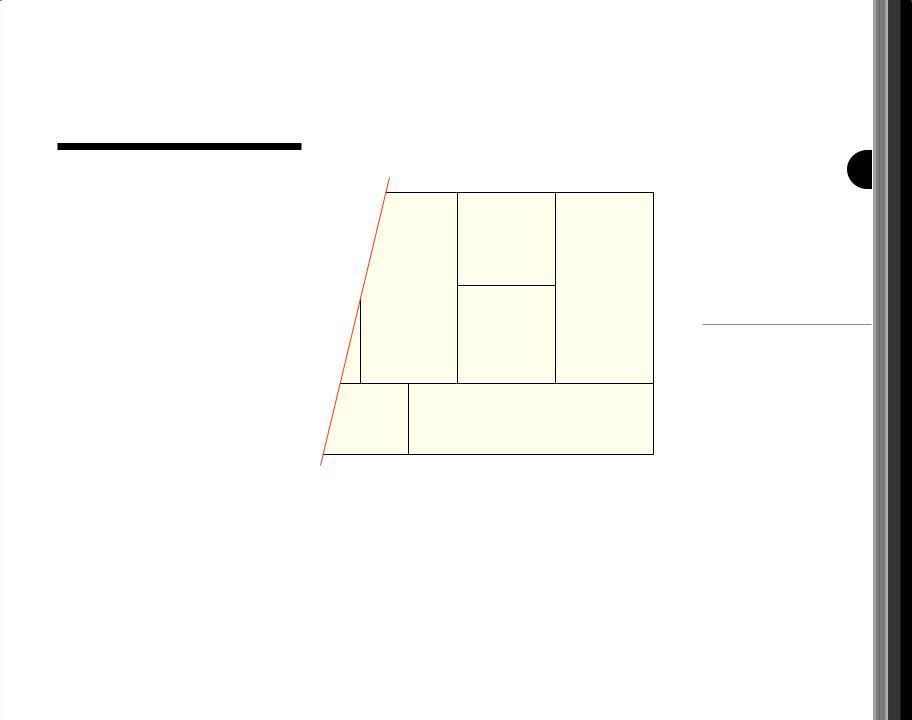
GlaxoSmithKline’s
Patent Pools
The inside-out approach to open innovation ordinarily focuses on monetizing unused internal assets, primarily patents and technology. In the case of GlaxoSmithKline’s “patent
pool” research strategy, though, the motivation was slightly diΩerent. The company’s goal was to make drugs more accessible in the world’s poorest countries and to facilitate research into understudied diseases. One way to achieve this was to place intellectual property rights relevant to developing drugs for such diseases into a patent pool open to exploration by other researchers. Since pharmaceutical companies focus mainly on developing blockbuster drugs, intellectual property related to less-studied diseases often lies idle. Patent pools aggregate intellectual property from diΩerent rights-
holders and makes it more accessible. This helps prevent R&D advances from being blocked by
a single rights-holder.
Inside-Out |
|
|
|
acquisition |
|
|
retention |
|
ip for |
outside |
|
underserved |
||
researchers |
||
diseases |
||
|
||
|
patent pools |
|
|
license fees |
open business Models
113
patterns
Unused internal ideas, R&D, and intellectual property related to diseases in poor nations have substantial value when “pooled”
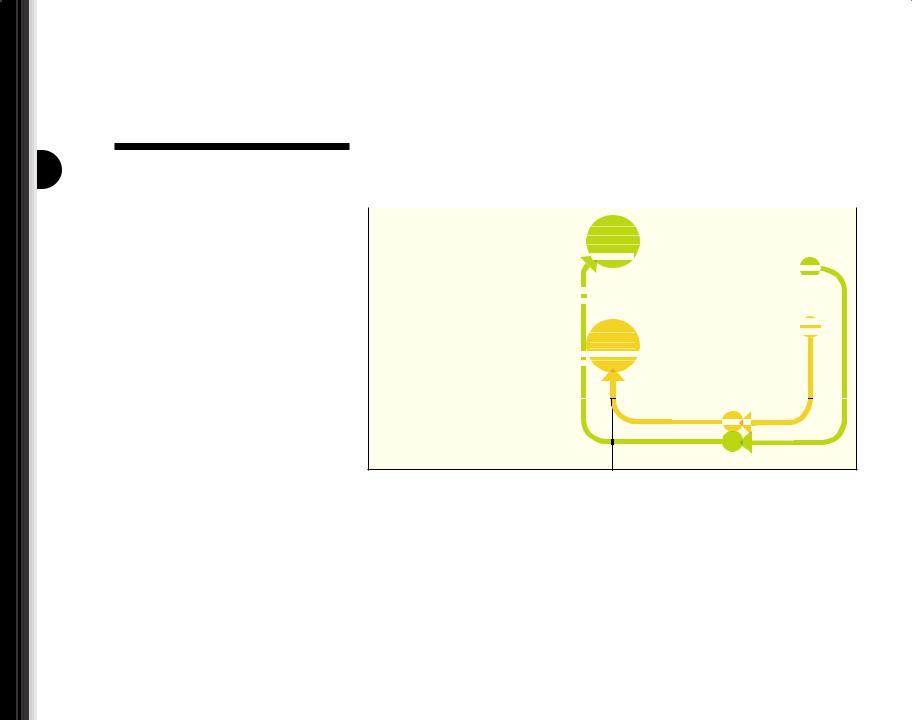
open business Models
114
patterns
The Connector:
Innocentive
Innocentive
Companies seeking insights from external researchers incur substantial costs when trying to attract people or organizations with knowledge that could solve their problems. On the other hand, researchers who want to apply their knowledge outside their own organizations also incur search costs when seeking attractive opportunities. That is where a company called InnoCentive saw opportunity.
InnoCentive provides connections between organizations with research problems to solve and researchers from around the world who are eager to solve challenging problems. Originally part of drug maker Eli Lilly, InnoCentive now functions as an independent intermediary listing non-profits, government agencies, and commercial organizations such as Procter & Gamble, Solvay, and the Rockefeller Foundation. Companies who post their innovation challenges on InnoCentive’s Web site are called “seekers.” They reward successful problemsolvers with cash prizes that can range from $5,000 to $1,000,000. Scientists who attempt to find solutions to listed problems are called “solvers.” InnoCentive’s Value Proposition lies
|
platform |
|
|
|
ccess to |
|
|
|
|
|
|
|
|||
|
management |
|
|
|
ad netwo |
|
|
|
|
|
|
|
|||
|
|
|
|
f scientist |
online profiles |
|
|
|
|
|
|||||
|
|
|
|
|
|
|
|
|
|
|
|||||
|
|
|
|
|
|
|
|
|
|
|
|
|
|
||
|
|
|
|
|
|
"solvers" |
|
|
|
|
|
|
s |
|
|
|
|
|
|
|
|
|
|
|
|
|
|
|
|
|
|
|
acquire solvers |
|
|
|
|
|
|
|
|
|
|
eker |
|
||
|
|
|
|
|
|
|
|
|
|
|
|
|
|||
major "seekers" |
& seekers |
|
|
|
access to |
|
|
|
|
|
|
|
|
|
|
|
|
|
|
|
|
|
|
|
|
|
|
|
|||
|
|
|
|
|
|
|
|
|
|
|
|
|
|||
innocentive |
|
|
|
|
|
|
|
|
|
|
|
|
|||
|
|
|
|
|
|
|
|
|
|
|
|
|
|||
|
|
|
|
|
|
|
|
|
|
|
|
|
|||
|
|
|
|
|
|
|
|
|
|
|
|
|
|||
|
|
|
|
|
|
|
|
|
|||||||
|
|
|
|
|
|
|
|||||||||
|
platform with |
|
|
|
scientific |
|
|
|
.com |
|
|
|
|
|
|
|
|
|
|
|
|
|
|
|
|
|
|||||
|
base of "solvers" |
|
|
|
llenges w |
|
|
|
|
|
|
||||
|
|
|
|
h rewar |
|
|
|
|
|
|
|
|
|||
|
& "seekers" |
|
|
|
|
|
|
|
|
|
|
|
|||
|
|
|
|
|
|
|
|
|
|||||||
|
|
|
|
|
|
|
|
|
|
|
|
||||
|
|
|
|
|
|
|
|
|
|
|
|
|
|
|
|
platform management |
to c |
|
|
acquisition of "solvers" & "seekers" |
chal |
|
solve commissions |
in aggregating and connecting “seekers” and “solvers.” You may recognize these qualities as characteristic of the multi-sided platform business model pattern (see p. 76). Companies with open business model patterns often build on such platforms to reduce search costs.

“Open Innovation is fundamentally about operating in a world of abundant knowledge, where not all the smart people work for you, so you better go find them, connect to them, and build upon what they can do.”
—— Henry Chesbrough
Executive Director, Center for Open Innovation Haas School of Business, UC Berkeley
“Long known for a preference to do everything in-house, we began to seek out innovation from any and all sources, inside, outside the company.”
—— A.G. Lafley
“Nestlé clearly recognizes that to achieve its growth objective it must extend its internal capabilities
to establish a large number of strategic partnering relationships. It has embraced open innovation and works aggressively with strate-
gic partners to co-create significant new market and product opportunities.”
—— Helmut Traitler
Head of Innovation Partnerships, Nestlé
open business Models
115
patterns
Chairman & CEO, P&G
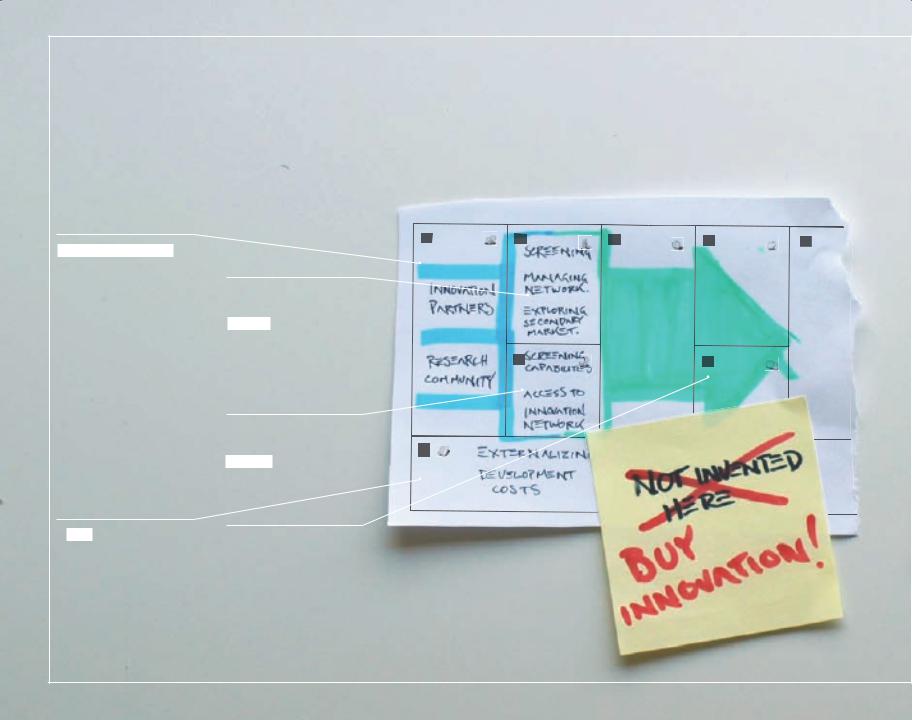
open business Models
116
patterns
Outside-In
 Pattern
Pattern
external organizations, sometimes from completely diΩerent industries, may
be able to oΩer valuable insights, knowledge, patents, or ready-made products to internal R&D groups.
It costs money to acquire innovation from outside sources. But by building on externally-created knowledge and advanced research programs, a company can shorten time-to-market and increase its internal R&D productivity.
Building on external knowledge requires dedicated activities that connect external entities with internal business processes and R&D groups.
Taking advantage of outside innovation requires specific resources to build gateways to external networks.
Established companies with strong brands, strong Distribution Channels, and strong Customer Relationships are well suited to
an outside-in open business model. They can leverage existing Customer Relationships by building on outside sources of innovation.
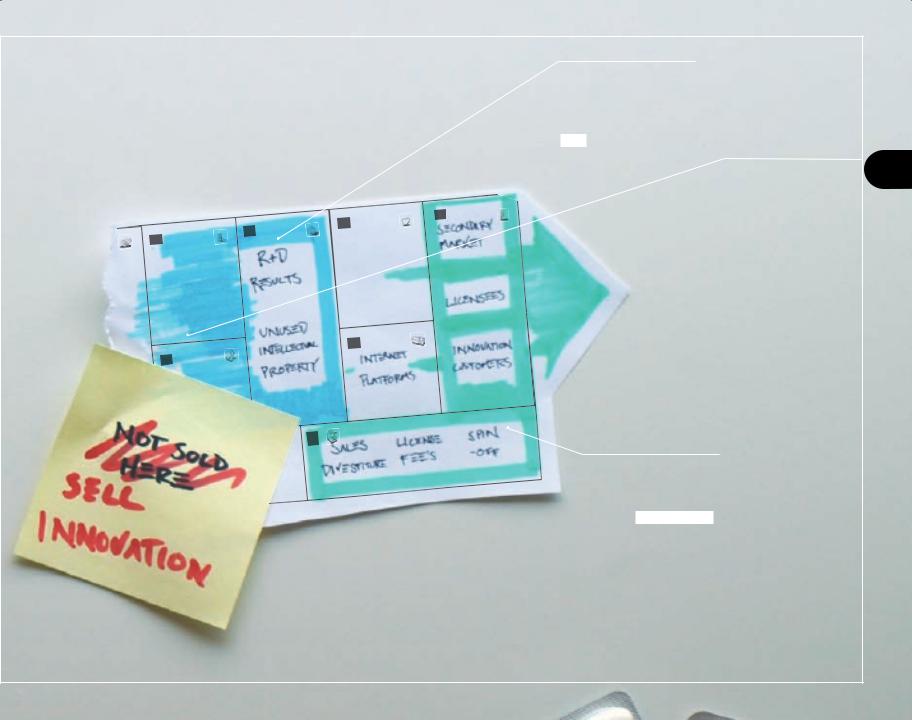
Inside-Out
Pattern
Some R&D outputs that are unusable internally—for strategic or operational reasons—may be of high value to organizations in other industries.
By enabling others to exploit unused internal ideas,
a company adds “easy” additional revenue streams.
Organizations with substantial internal R&D operations typically possess much unutilized knowledge, technology, and intellectual property. Due to sharp focus on core businesses, some
of these otherwise valuable intellectual assets sit idle. Such businesses are good candidates for an "insideout" open business model.
open business Models
117
patterns
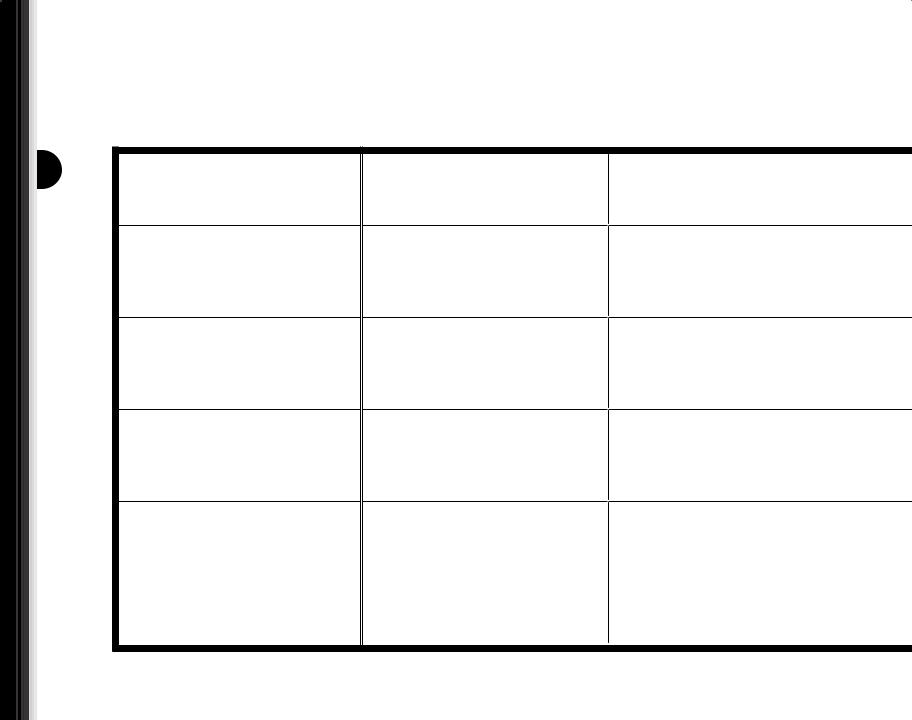
oVerVieW
118
patterns
Patterns
Overview Unbundling Business Models The Long Tail
context (before)
challenge
solution (after)
rationale
examples
An integrated model combines infrastructure management, product innovation, and Customer Relationships under one roof.
Costs are too high.
Several conflicting organizational cultures are combined in a single entity, resulting in undesirable trade-offs.
The business is unbundled into three separate but complementary models dealing with
•Infrastructure management
•Product innovation
•Customer relationships
IT and management tool improvements allow separating and coordinating different business models at lower cost, thus eliminating undesirable trade-offs.
Private Banking
Mobile Telco
The Value Proposition targets only the most profitable clients.
Targeting less profitable segments with specific Value Propositions is too costly.
The new or additional Value Proposition targets a large number of historically less profitable, niche Customer Segments—which in aggregate are profitable.
IT and operations management improvements allow delivering tailored Value Propositions to a very large number of new customers at low cost.
Publishing Industry (Lulu.com)
LEGO

Multi-Sided Platforms |
FREE as a Business Model |
Open Business Models |
One Value Proposition targets one
Customer Segment.
Enterprise fails to acquire potential new customers who are interested in gaining access to a company’s existing customer base (e.g. game developers who want to reach console users)
A Value Proposition “giving access” to a company’s existing Customer Segment is added (e.g. a game console manufacturer provides software developers with access to its users)
An intermediary operating a platform between two or more Customer Segments adds Revenue Streams to the initial model.
Video game consoles from Nintendo, Sony, Microsoft
Apple
iPod, iTunes, iPhone
A high-value, high-cost Value Proposition is offered to paying customers only.
The high price dissuades customers.
Several Value Propositions are offered to different Customer Segments with different Revenue Streams, one of them being free- of-charge (or very low cost).
Non-paying Customer Segments are subsidized by paying customers in order to attract the maximum number of users.
Advertising and newspapers
Metro
Flickr
Open Source
Red Hat
Skype (versus Telco)
Gillette
Razor and blades
R&D Resources and Key Activities are concentrated in-house:
•Ideas are invented “inside” only
•Results are exploited “inside” only
R&D is costly and/or productivity is falling.
Internal R&D Resources and Activities are leveraged by utilizing outside partners. Internal R&D results are transformed into a Value Proposition and offered to interested Customer Segments.
Acquiring R&D from external sources can be less expensive, resulting in faster time- to-market. Unexploited innovations have the potential to bring in more revenue when sold outside.
Procter & Gamble
GlaxoSmithKline
Innocentive
oVerVieW
119
patterns



Des

ign

“Businesspeople don’t just need to understand designers better; they
need to become designers.”
Roger Martin, Dean, Rotman School of Management

This section describes a number of techniques and tools from the world of design that can help you design better and more innovative business models. A designer’s business involves relentless inquiry into the best possible way to create the new, discover the unexplored, or achieve the functional. A designer’s job is to extend the boundaries of thought, to generate new options, and, ultimately, to create value for users. This requires the ability to imagine “that which does not exist.” We are convinced that the tools and attitude of the design profession are prerequisites for success in the business model generation.
Businesspeople unknowingly practice design every day. We design organizations, strategies, business models, processes, and projects. To do this, we must take into account a complex web of factors, such as competitors, technology, the legal environment, and more. Increasingly, we must do so in unfamiliar, uncharted territory. This is precisely what design is about. What businesspeople lack are design tools that complement their business skills.
The following pages explore six business model design techniques: Customer Insights, Ideation, Visual Thinking, Prototyping, Storytelling, and Scenarios. We introduce each technique with a story, then demonstrate how the technique applies to business model design. Here and there we've added exercises and suggestions for workshop activities that show you specifically how the design technique can be applied. Book references are provided at the end for those interested in exploring each technique in more depth.
Design
126 Customer Insights
134 Ideation
146 Visual Thinking
160 Prototyping
170 Storytelling
180 Scenarios
